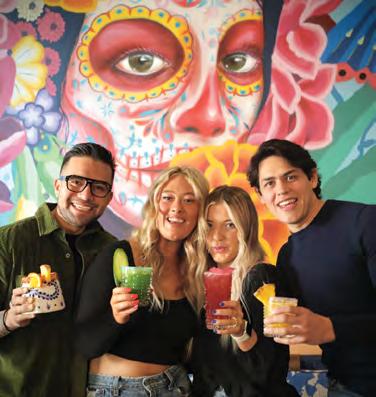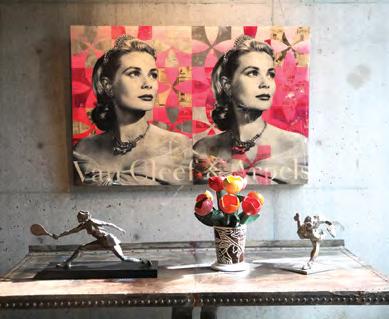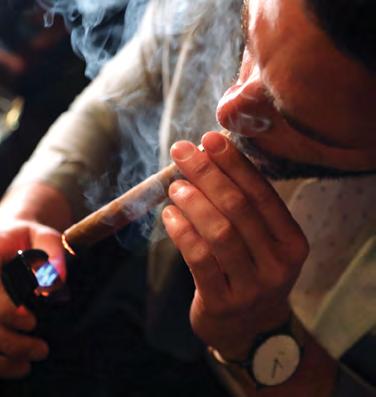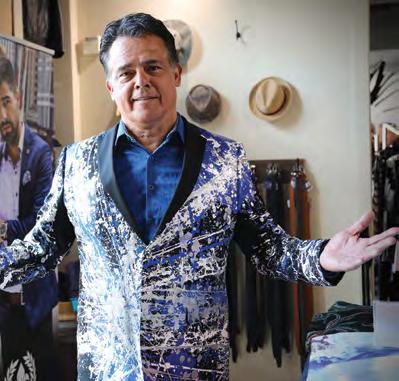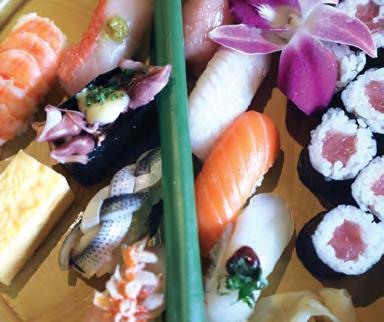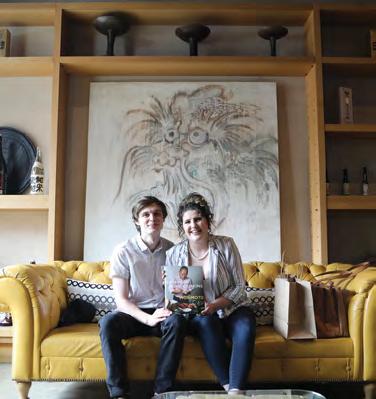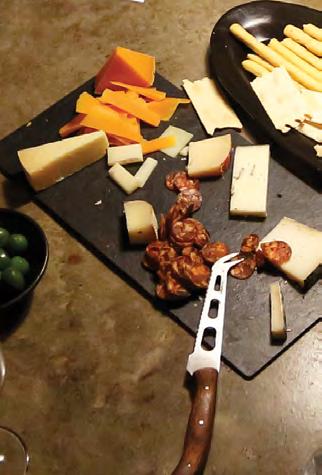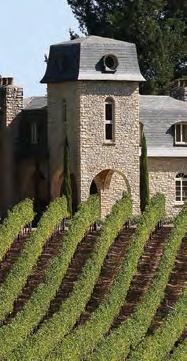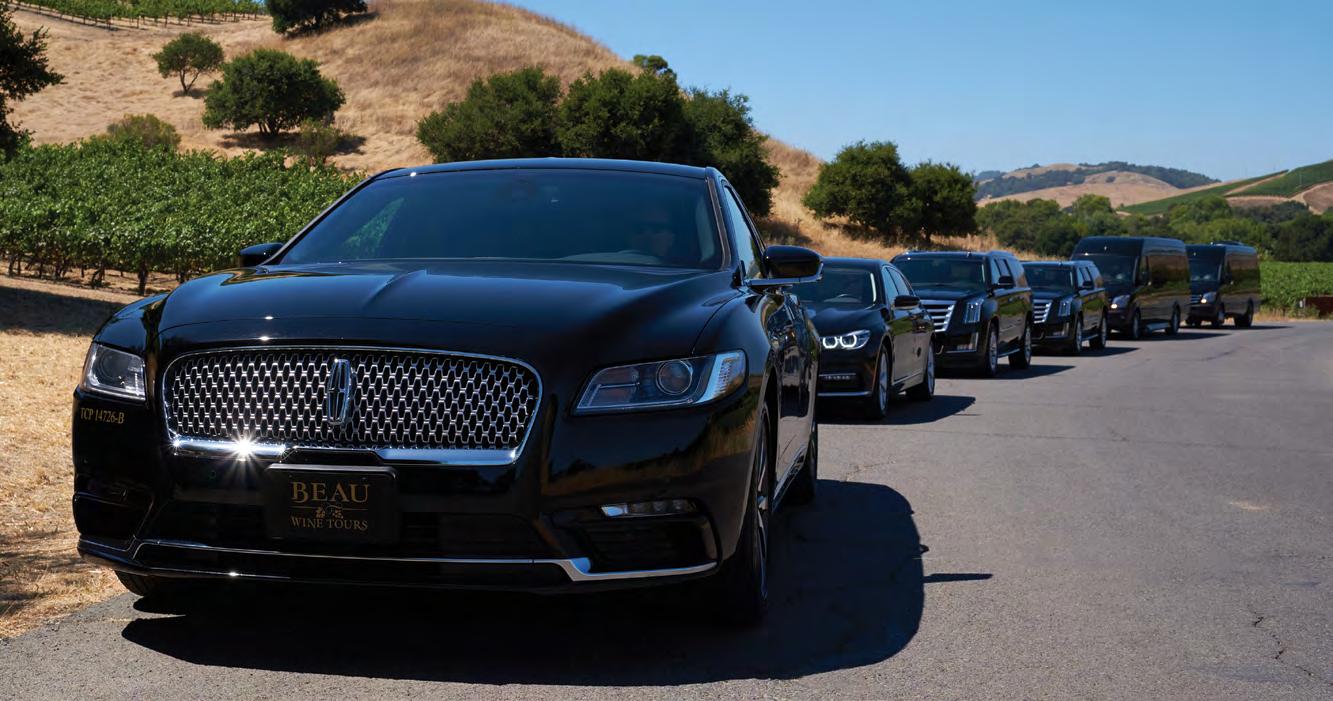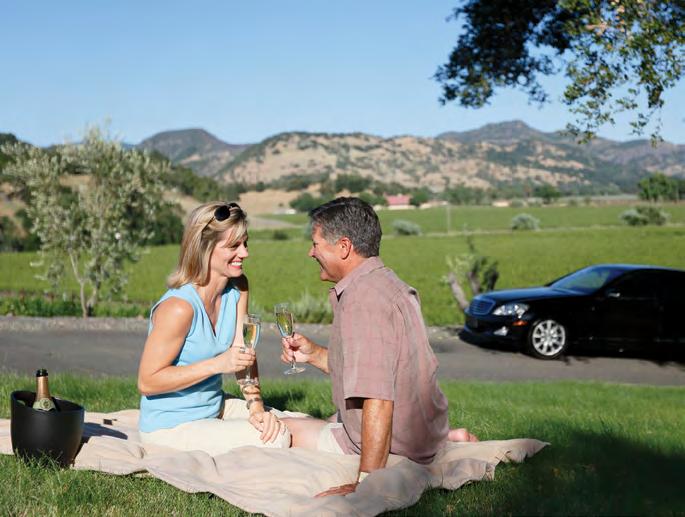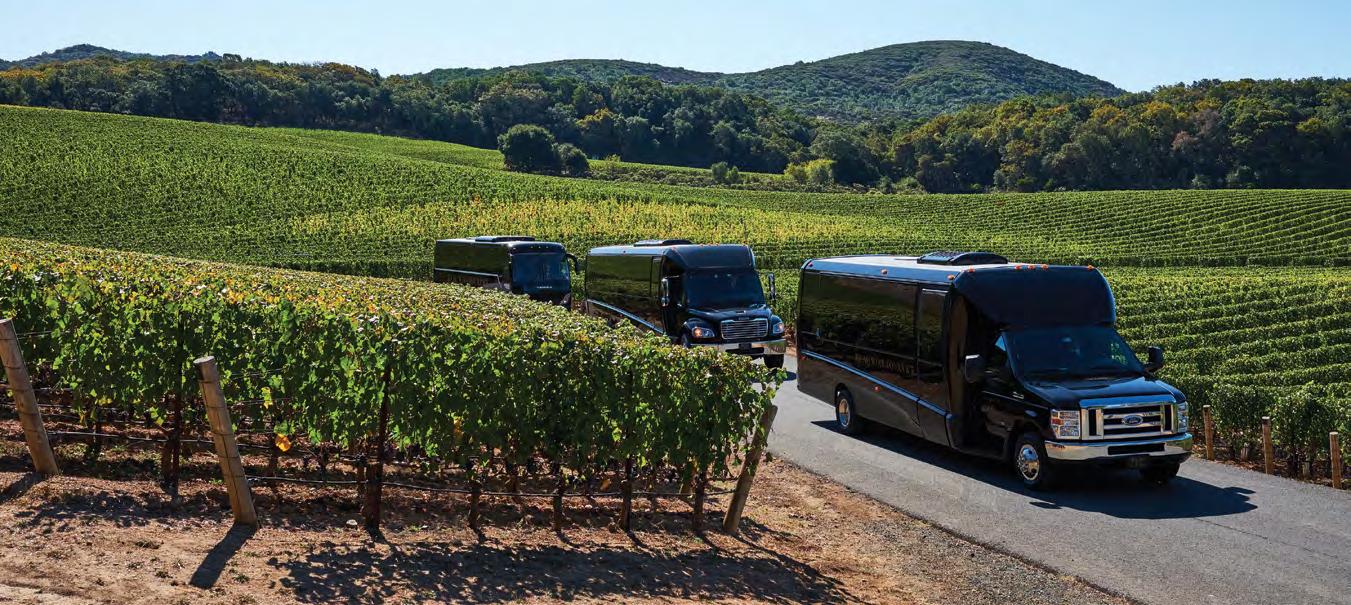






We’re bullish on your future. When we work together, you get personalized guidance, insights and financial planning — all designed to connect your life with your finances and to help make the path toward your goals even clearer.
Let’s have a conversation.
The Gonzales Group
Eric F. Gonzales
Merrill Lynch Wealth Management
Senior Vice President
Senior Resident Director-Wealth Management Advisor
707.254.4606
eric_gonzales@ml.com fa.ml.com/gonzales_group
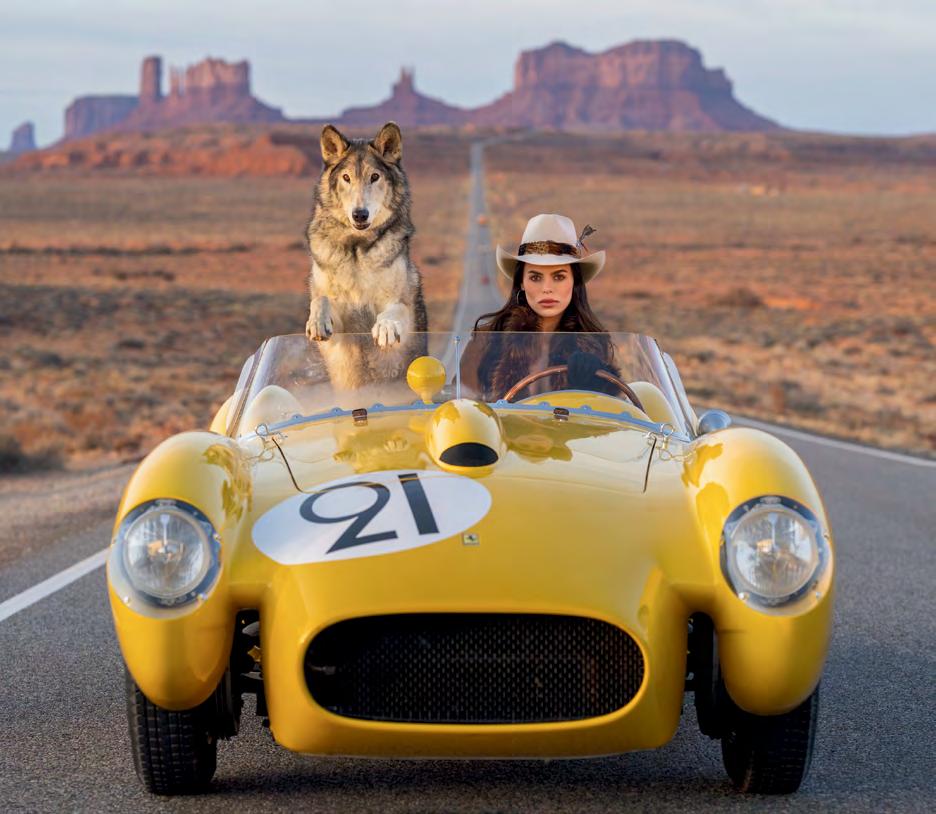
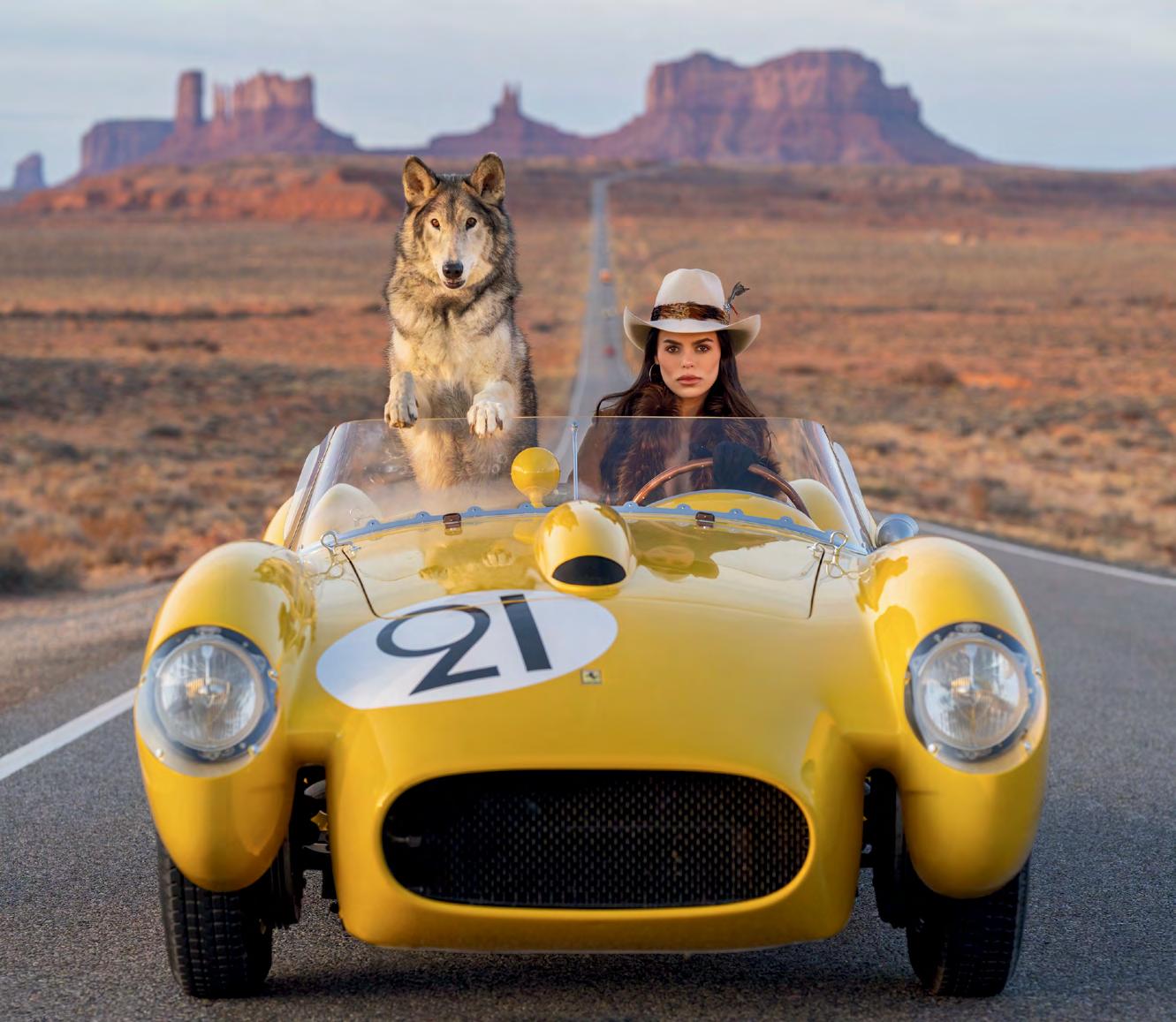
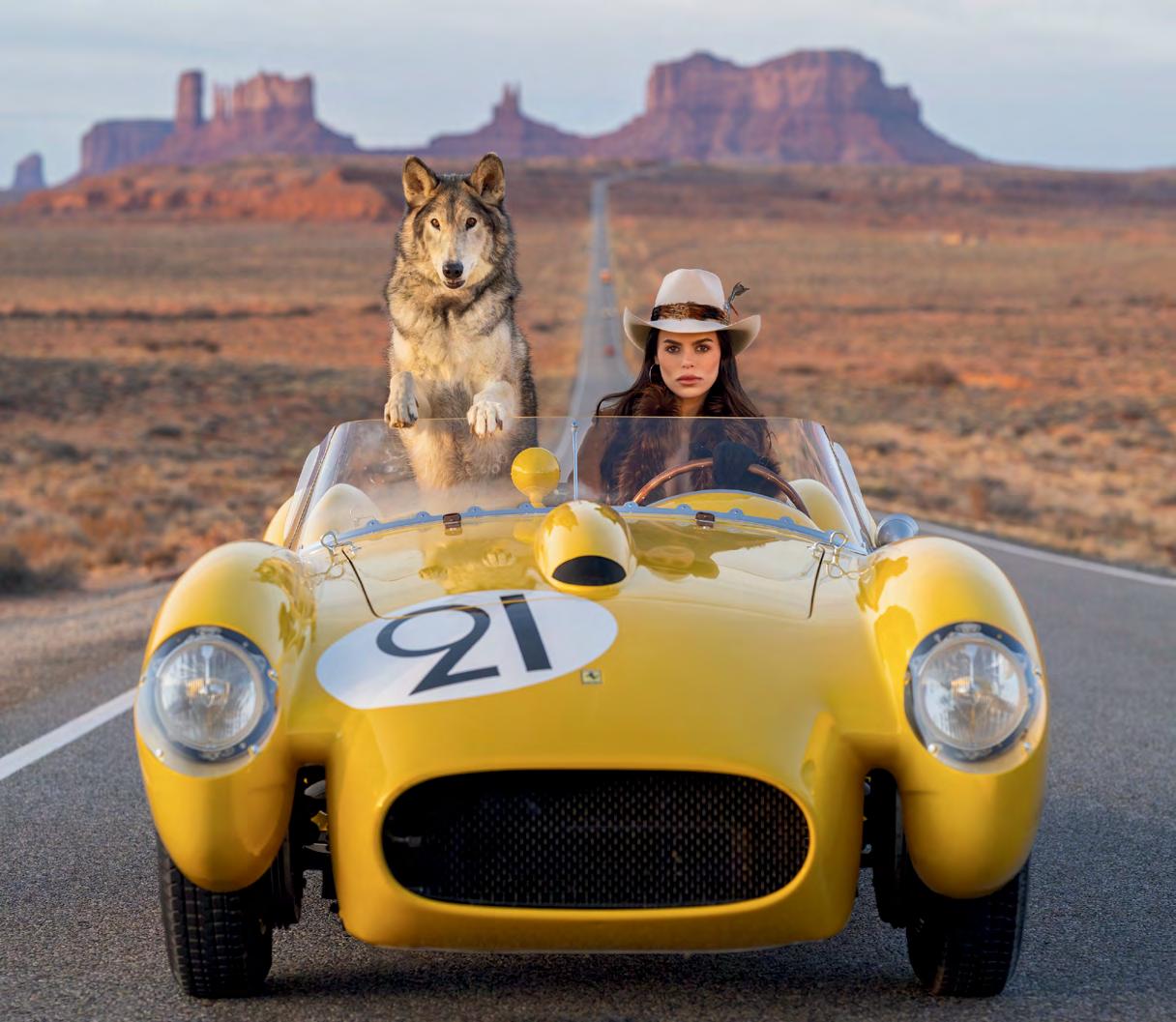


David Yarrow, Testarossa, 2023
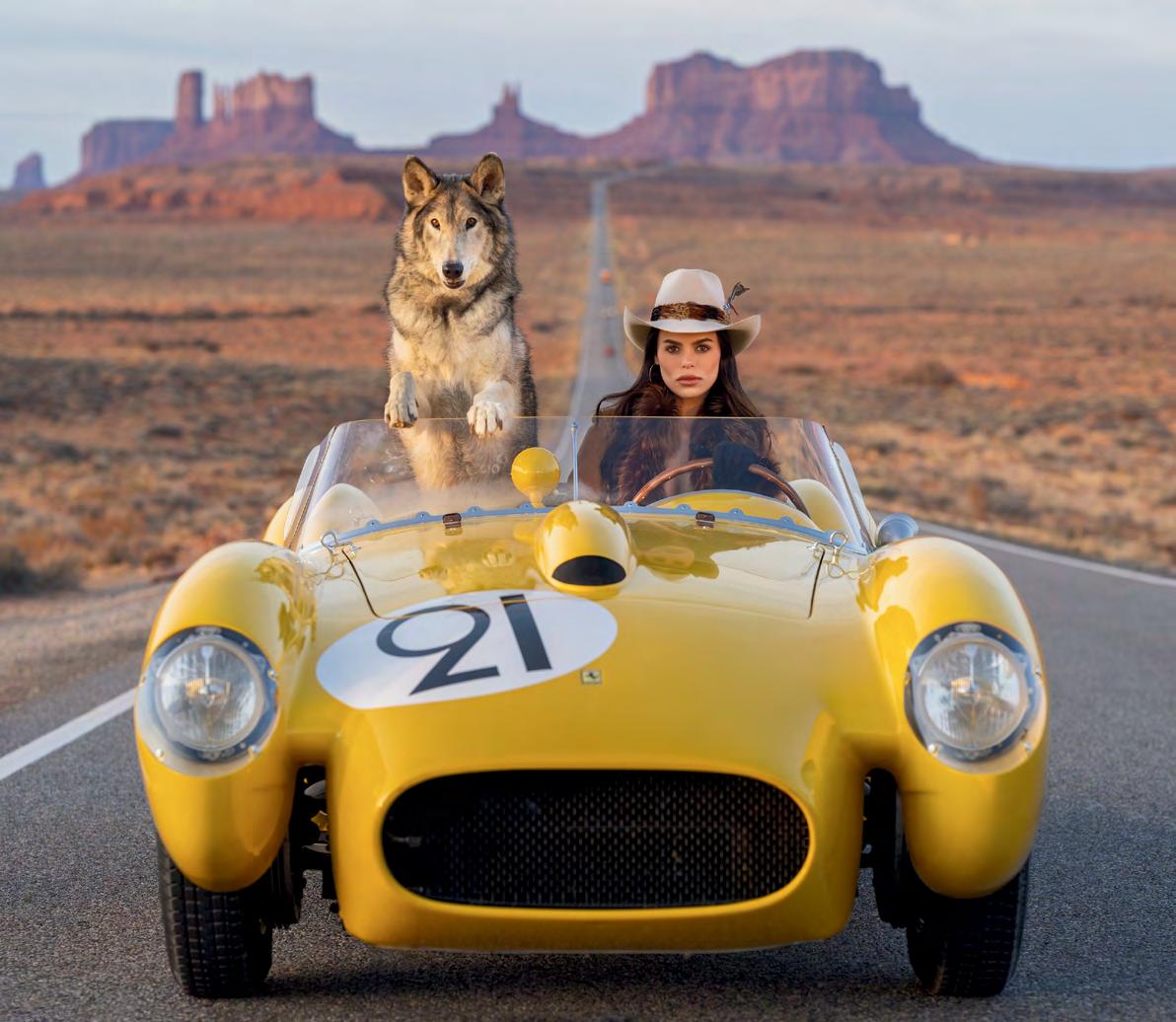
masters and rising talents, the gallery invites gue sts to enjoy art and wine together for a truly memorable experience.

www.CalistogaContemporary.com RUSHA - HOCKNEY - YARROW - PROCACCIO - PEDERSON - YOCUM 1255 LINCOLN AVE
Napa Valley’s newest premier fine art gallery, offe rs a fresh vision in the heart of Wine Country. Featuring a cu rated mix of modern and contemporary works from celebrate d masters and rising talents, the gallery invites gue sts to enjoy art and wine together for a truly memorable experience.
cu rated mix of modern and contemporary works from celebrate d masters and rising talents, the gallery invites gue sts to enjoy art and wine together for a truly memorable experience. www.CalistogaContemporary.com
Napa Valley’s newest premier fine art gallery, offe rs a fresh vision in the heart of Wine Country. Featuring a cu rated mix of modern and contemporary works from celebrate d masters and rising talents, the gallery invites gue sts to enjoy art and wine together for a truly memorable experience. www.CalistogaContemporary.com





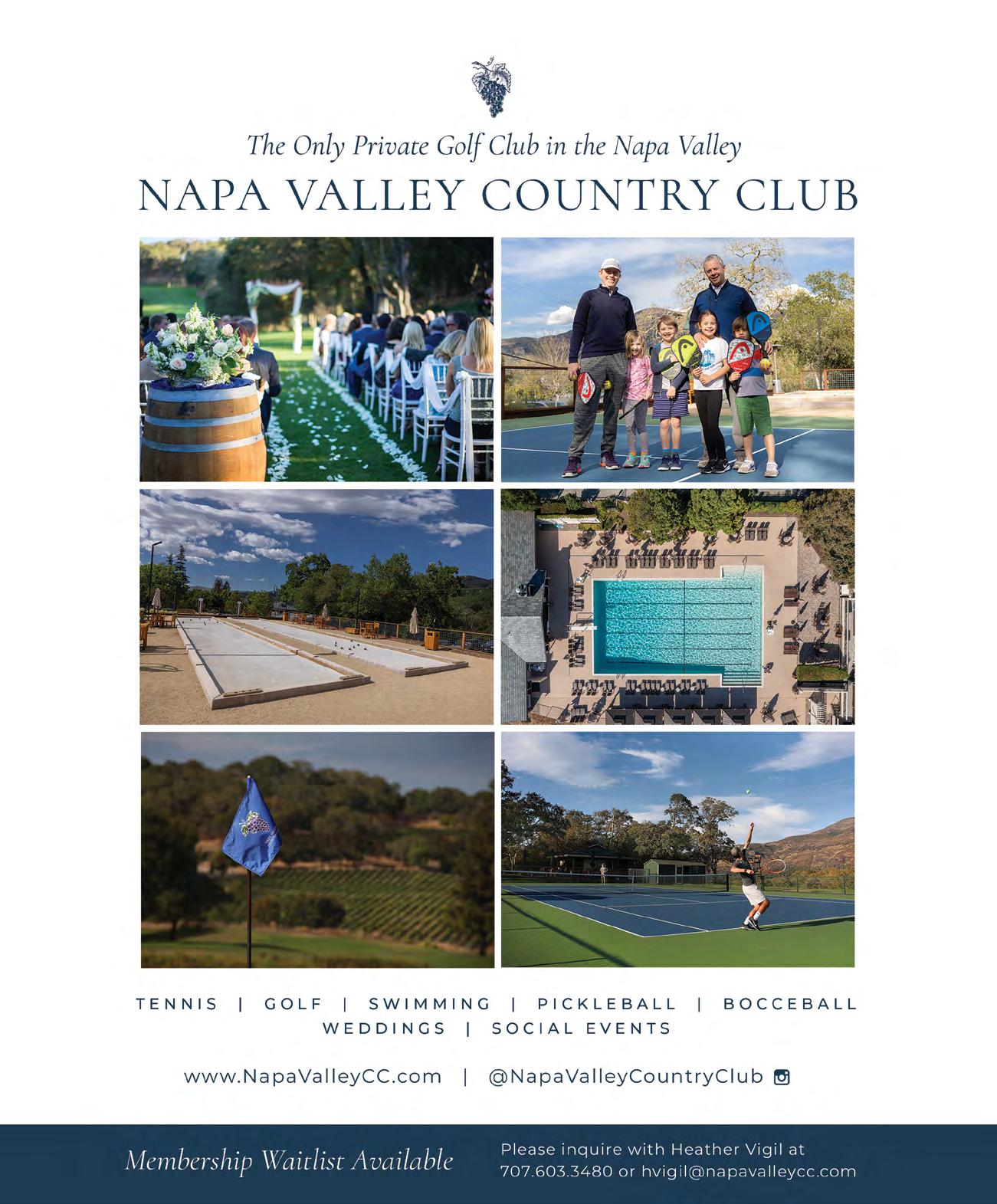
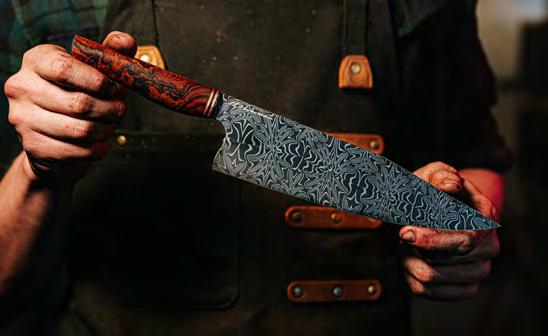

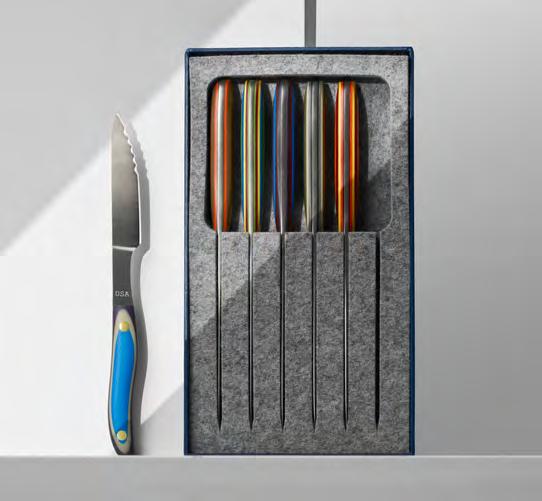


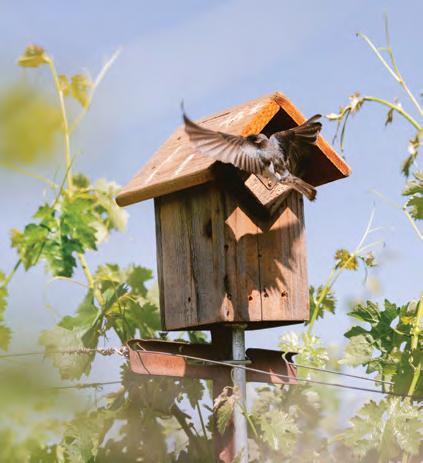
34 30 53 76 Cover Story Blue Diamond Jeweler: Wine, Dine, and Now Shine
Annual Holiday Gift Guide: Napa Valley Gift Ideas for the Holidays Sustainability: More Than a Buzzword in Napa Valley Side Trip: The Bohemian Highway Lives On
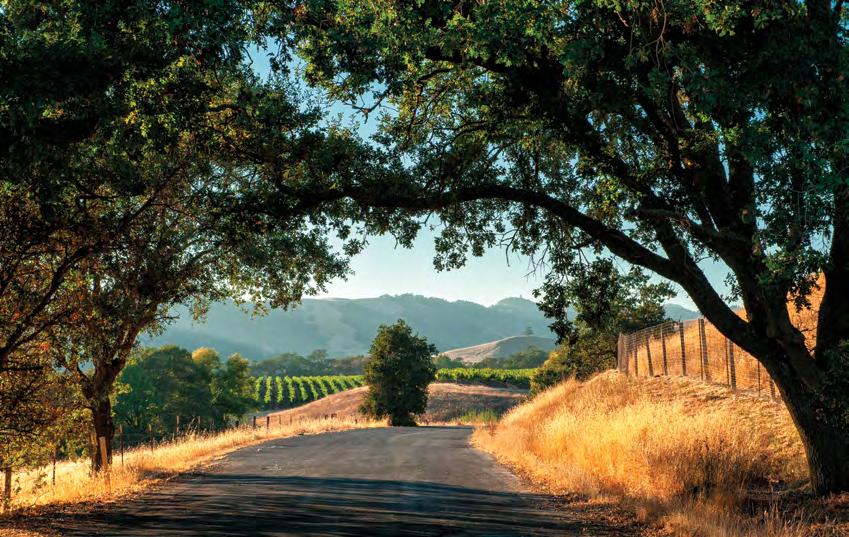





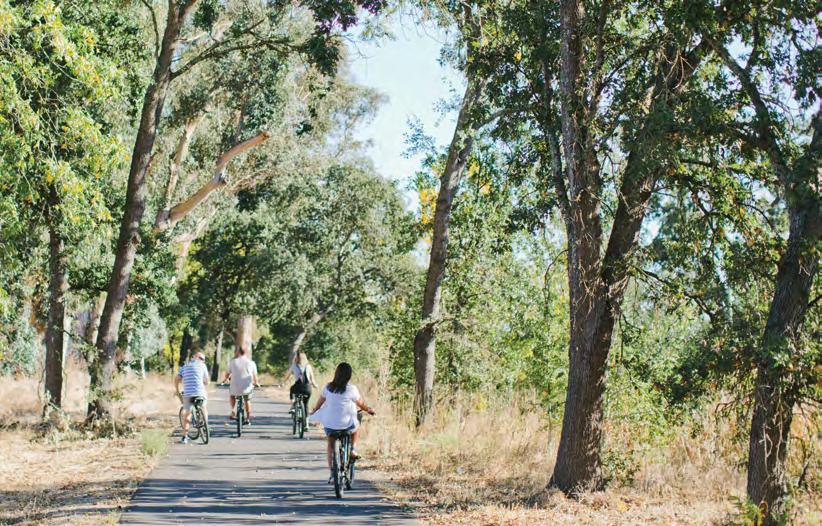
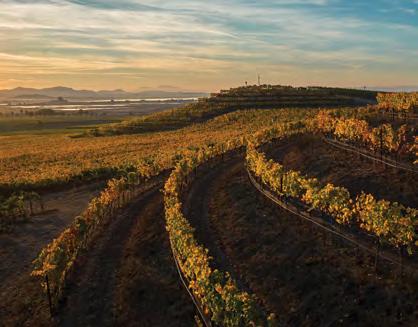
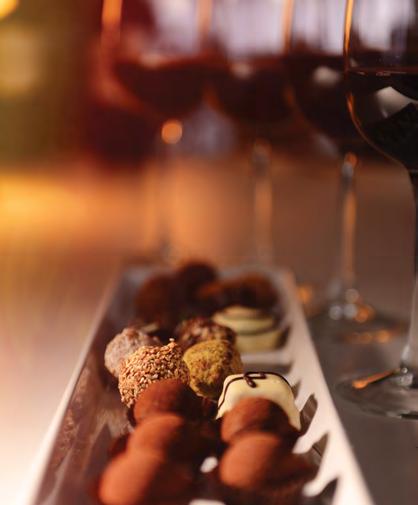
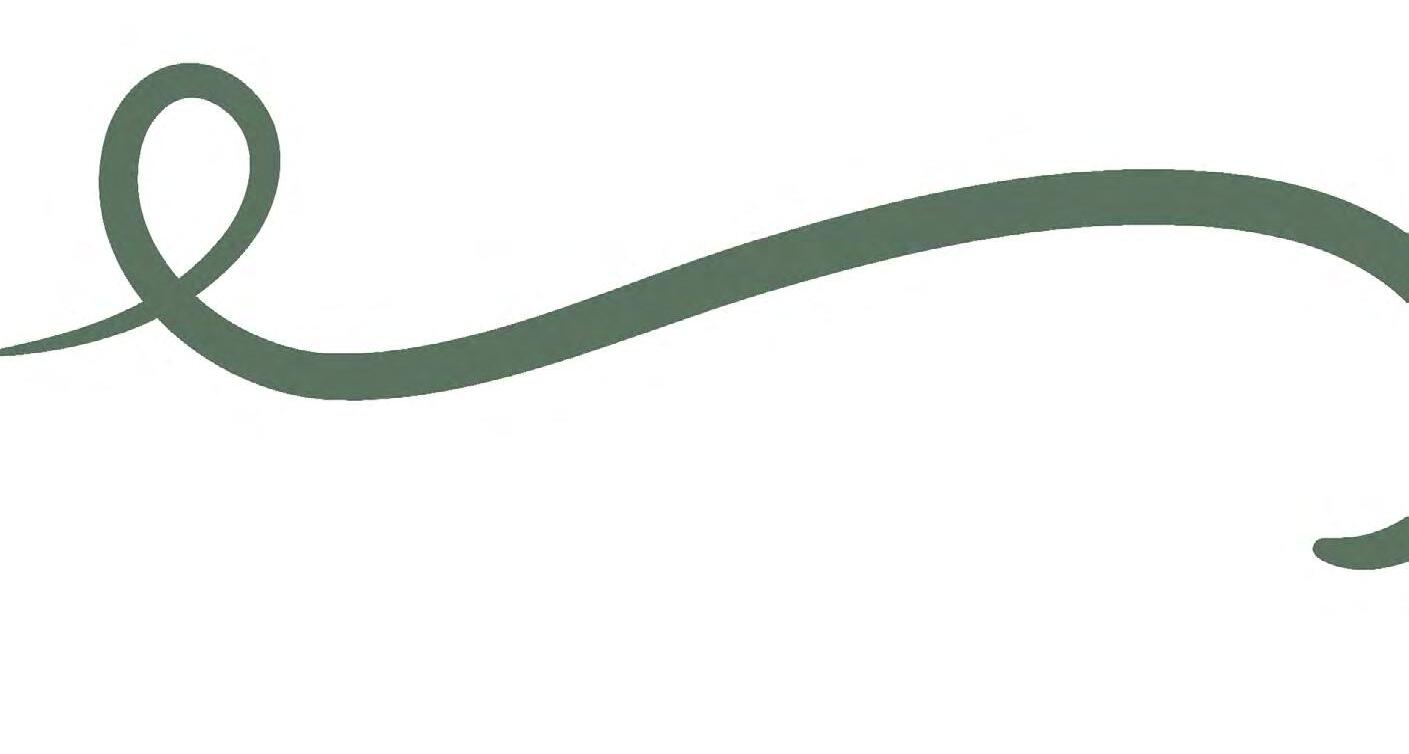
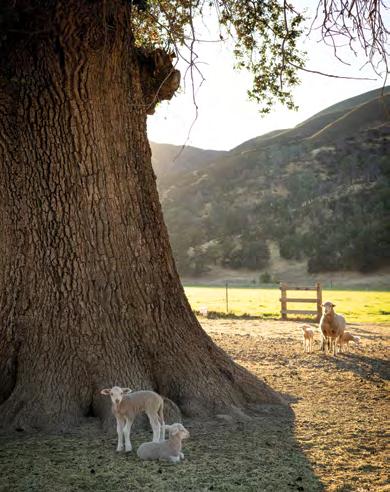
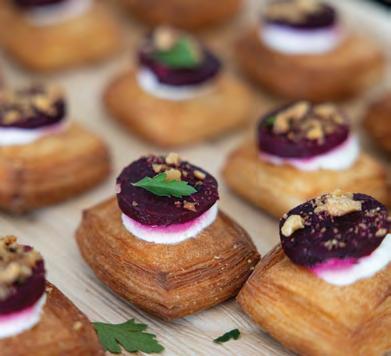

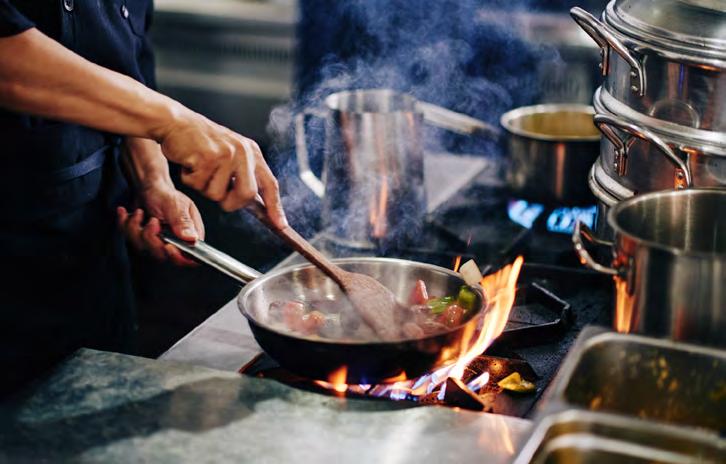
At Calligraphy Napa Valley, fine dining is more than a meal, it’s a chef-d’oeuvre in motion. Each course is composed like a handwritten letter, unfolding with intention, grace, and culinary storytelling where every plate is a paragraph and every flavor an adjective.
This unparalleled dining experience offers locally sourced ingredients, where even the most sophisticated palates of the mouth will be serenaded by a symphony of flavors. From the first sip to the final flourish, Savour CuisineSM delivers a dining experience as refined and expressive as a Shakespearean sonnet.
Join us for a personalized tour and delight in a chef-crafted taste of Savour Cuisine,SM our treat.
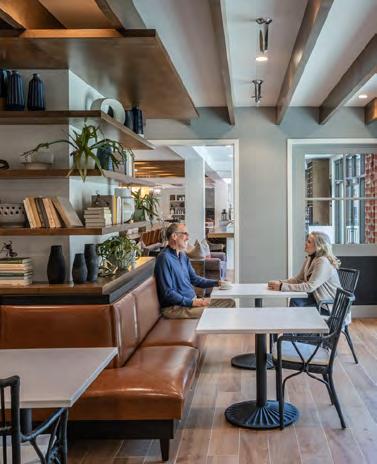

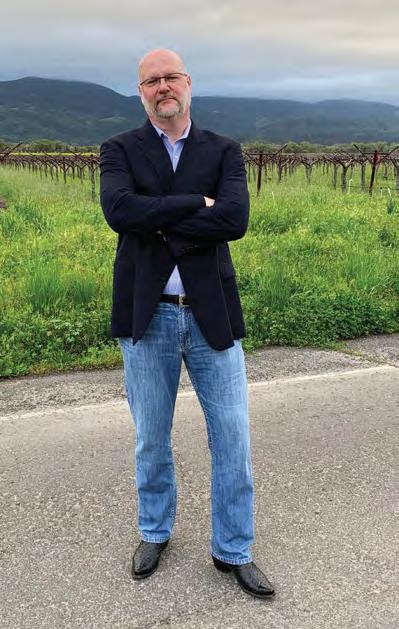
While the word harvest is defined simply as “the gathering of crops,” in Napa Valley it represents far more—it is a season of celebration, reflection, and community. The term encapsulates the essence of an entire year of dedication, teamwork, vision, and hope, all balanced by the unpredictability of climate. Ultimately, it is the moment that defines a vintage.
During harvest, the valley comes alive with celebrations, events, and the beauty of autumn weather. It is a cherished time when people unite, share stories, and honor the traditions that bind them together.
In this issue of Napa Valley Life, we explore the efforts of those committed to not only growing exceptional wines but also protecting the environment. Here, sustainability is not just a buzzword—it is a way of life. In Napa Valley, sustainability extends beyond environmental stewardship to encompass thoughtful farming practices, responsible business, and the long-term preservation of a cherished way of life.
We also turn our focus to the Los Carneros AVA, a region with the rare distinction of spanning two counties. Known primarily for its outstanding Chardonnay and Pinot Noir, rather than Cabernet Sauvignon, Los Carneros continues to shape Napa’s diverse winemaking story.
This issue pays homage to Altaf Amlani, owner of Blue Diamond Jeweler. Renowned for helping others celebrate life’s most meaningful moments, Amlani lives by his “Four C’s” philosophy—caring, collaboration, character, and charity. Few realize that each purchase made at his store also helps fund the Nia Foundation, a nonprofit organization making a real difference for those less fortunate. His philanthropy and humility are both remarkable and inspiring.
For Napa Valley Life, this harvest carries an additional layer of meaning. As the valley’s wineries celebrate, we too mark a transition of our own. After seven years of leadership, Editor Laura Larson has retired and relocated to South Carolina. Throughout her tenure, she made an indelible impact—not only as the second of two editors in the magazine’s 25-year history, but also as a dedicated community leader. Her vision, integrity, and tireless commitment to Napa Valley Life will be remembered and carried forward with deep respect and gratitude.
As we look ahead and begin the search for a new editor, we do so with appreciation for the foundation Laura has built and the standards she upheld. Her influence will continue to guide the magazine into its next chapter.
Until the next issue, may you enjoy the harvest season and the stories, traditions, and connections that make it so meaningful. Moving forward, we will be eliminating this editor’s letter to make room for more content on the exciting things happening in and around Napa Valley.
Cheers!

Kevin Evans President

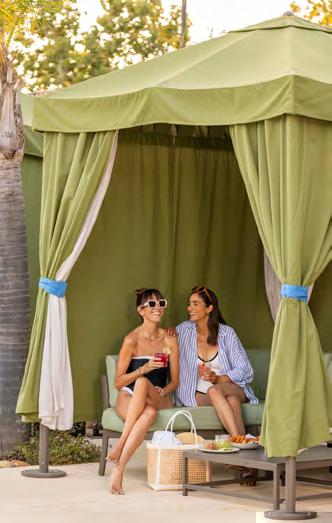
INTRODUCING NA PA VALLEY’S NEWEST LIFESTYLE MEMBERSHIP AT SI LVERADO RESORT
INTRODUCING NA PA VALLEY’S NEWEST LIFESTYLE MEMBERSHIP AT SI LVERADO RESORT
InvitationalSport&SocialMembershipbenefitsinclude:
InvitationalSport&SocialMembershipbenefitsinclude:
Full access to spa facilities, including lap pool, fitness center, and wellness areas
Full access to spa facilities, including lap pool, fitness center, and wellness areas
Preferred pricing on dining, retail, accommodations, catering, and spa services
Preferred pricing on dining, retail, accommodations, catering, and spa services
Entry to members-only clubhouse, social activities and events
Entry to members-only clubhouse, social activities and events
Priority access and reservations for racquet sports
Priority access and reservations for racquet sports
Complimentary group fitness classes
Complimentary group fitness classes
Golf access with green fees
Golf access with green fees
And more...
And more...
1600 Atlas Peak Road, Napa, CA 94558 A Destination For
SCHEDULE Y OUR T OUR (707) 257 5448 | membership@silveradoresort.com
SCHEDULE Y OUR T OUR (707) 257 5448 | membership@silveradoresort.com
Silverado Resort
Silverado Resort
1600 Atlas Peak Road, Napa, CA 94558
Property ownership is not required. All are welcome to live the Napa Valley Lifestyle.

CHIEF EXECUTIVE OFFICER
Derek Wright
PRESIDENT
Kevin Evans
VICE PRESIDENT OF OPERATIONS
Nicole Branning
INTERIM EDITOR
Kevin Evans
CREATIVE DIRECTOR
Erin Hayden Seal
ADVERTISING SALES
Doris Hobbs doris.hobbs@napavalleylife.com
CONTRIBUTING WRITERS
Fran Miller
Layne Randolph
Jillian Dara
Melissa Vogt
Laurie Jo Miller Farr
Mallory McEligot
CONTRIBUTING PHOTOGRAPHERS
Art & Clarity – Lowell Downey
Correlation Photo Co – Wesley Steffens
ABOUT THE COVER
Altaf Amlani, owner of Blue Diamond Jeweler, standing in front of his Napa store
Photo by Wesley Steffans, Correlation Photo Co

Napa Valley Life Magazine is published six times a year.
We have four quarterly publications and two annual publications.
Copyright 2025 by Napa Valley Life Magazine. All rights reserved. No part of this publication may be reproduced without the written permission of the publisher. Subscriptions are available for $12/year by visiting napavalleylife.com and clicking on subscriptions at the top.
Corporate Headquarters: 314 E. Highland Mall Blvd., Suite 125, Austin, TX 78752
/NVLife @napavalleylifemag


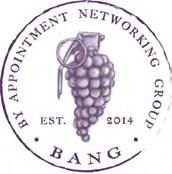
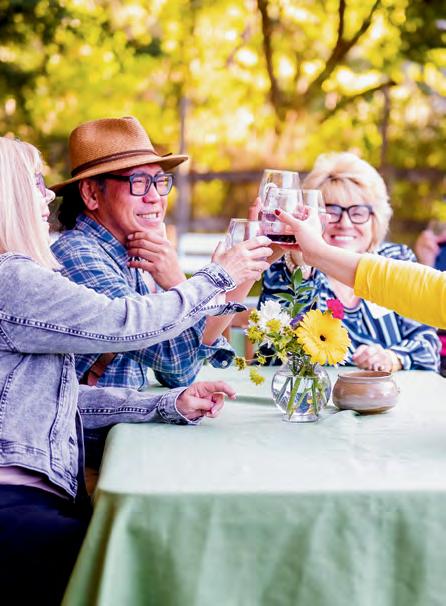
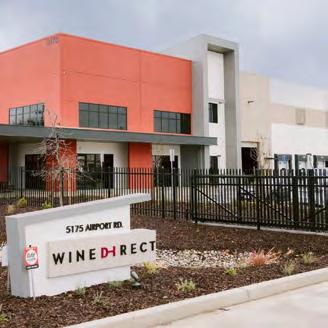
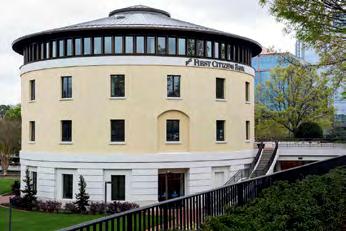
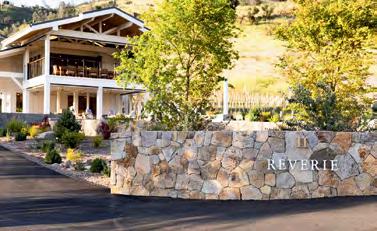

WineDirect Fulfillment is the leader in direct-to-consumer (DTC) wine logistics, exceeding the industry standard for seamless, efficient, and reliable service. We specialize in best-in-class fulfillment solutions, cutting-edge technology integrations, and meticulous wine care to ensure every bottle reaches customers in perfect condition.
We've been helping families and businesses make more of their finances for 125 years. We've shared their dreams, helped make budgets work harder and built financial plans to last them the rest of their lives. And in that time, we've built a solid track record of service, stability and reliability.
Reverie Winery Estate spans 26 acres of pristine hillside, where sweeping vineyards and the majestic Mayacamas Mountains create a breathtaking backdrop. In 2017, Grant and Megan Long discovered this historic property and transformed it into the heart of Reverie—a place where vision meets legacy.
Where Napa’s wine and hospitality community comes together, one pour at a time.
The By-Appointment Networking Group (BANG) was established in April 2014 by Mallory McEligot with the vision of creating a dedicated network for professionals working exclusively at by-appointment wineries. Over time, the network has grown to include local tour guides, luxury hotel groups, caterers, and vendors ancillary to the wine industry. Members share a passion for participating in highly curated and targeted networking events. BANG organizes private industry events at member properties, inviting select businesses to showcase their offerings to an exclusive group of industry professionals. This proven model fosters meaningful inter-winery relationships and establishes lasting connections with key trade partners. Through our extensive network, members collaborate to generate new business opportunities and drive revenue by referring highly qualified clientele. Join BANG now! www.bangwinecountry.com
# PHOTOS COURTESY OF HERITAGE FIRE
On August 17, Charles Krug Winery hosted Heritage Fire, an all-inclusive culinary celebration that brought together local restaurants, talented chefs, and passionate food lovers. Guests enjoyed a walk-around feast featuring a diverse lineup of creative bites from some of the region’s most acclaimed kitchens, paired with a curated selection of beverages. While attendees cast their votes for the favorite bite of the day, the true highlight was the shared experience—savoring bold flavors, raising a glass, and celebrating the Napa Valley culinary community in a lively, welcoming atmosphere. // www.heritagefiretour.com
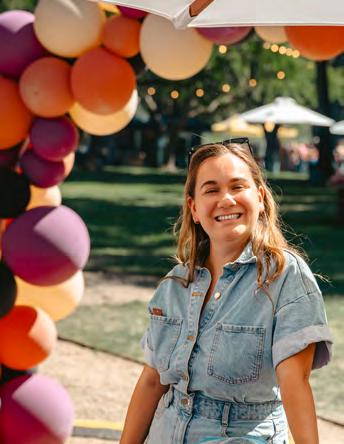
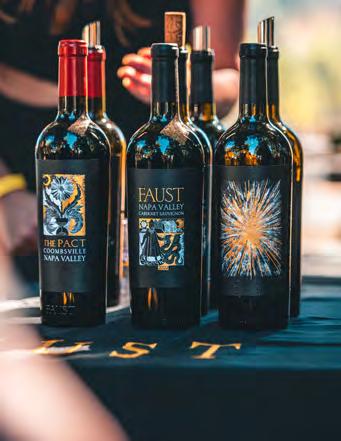

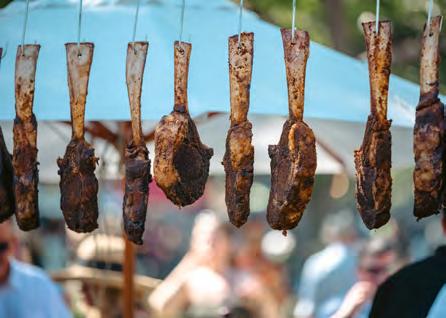
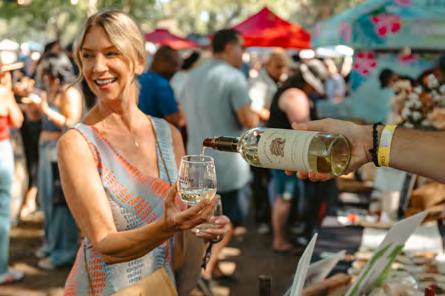
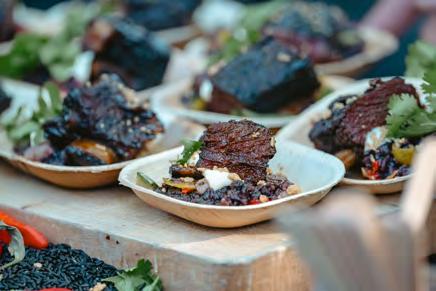
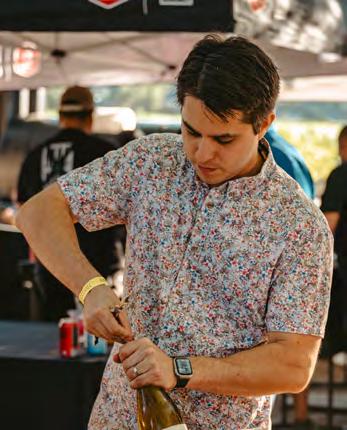
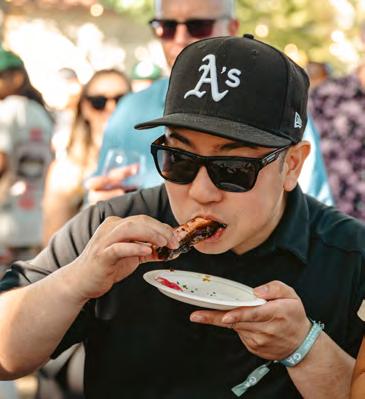
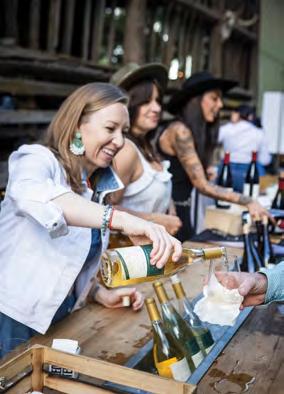
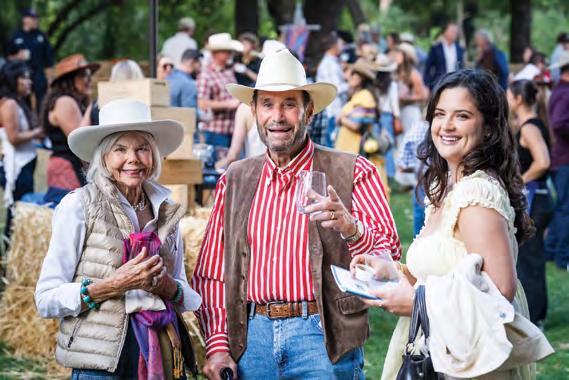
# PHOTOS BY SUZANNE BECKER BRONK PHOTOGRAPHY COURTESY OF HARVEST STOMP
The Napa Valley Grapegrowers and Napa Valley Farmworker Foundation announced that the 2025 Harvest STOMP® raised over $2.7 million to support vineyard education, innovation, environmental stewardship, and programs benefiting farmworker families. Held August 23 at the Hoxsey Family’s historic Yountville property, the sold-out event welcomed 500 guests. Highlights included a lively Live Auction, a curated eAuction featuring rare wines and exclusive experiences, and a performance by country artist Tyler Rich. Presented by John Anthony Vineyards and PV 365 Winery, alongside additional premier partners, this year’s Harvest STOMP® reaffirmed its place as one of Napa’s most impactful fundraising celebrations. // www.harveststomp.com
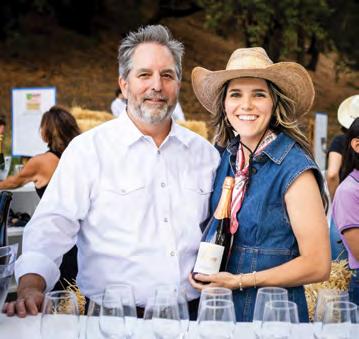
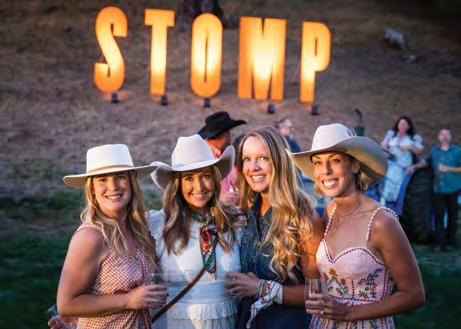
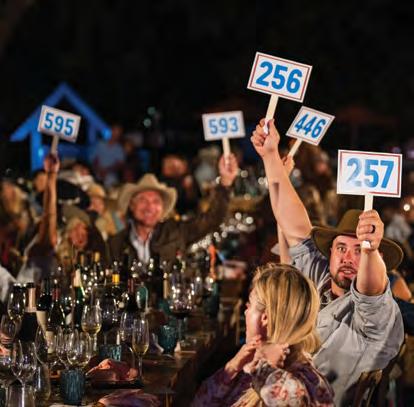
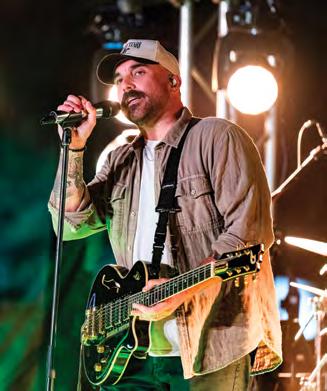
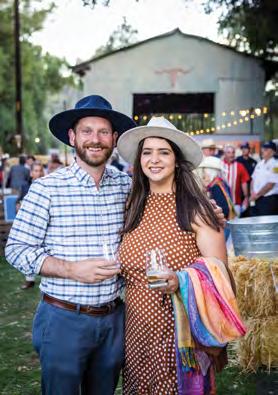
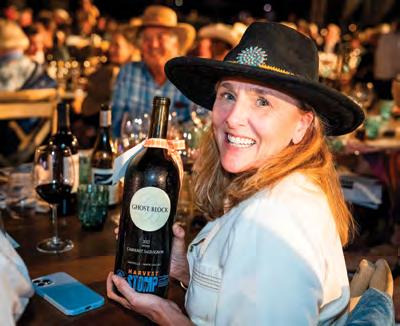
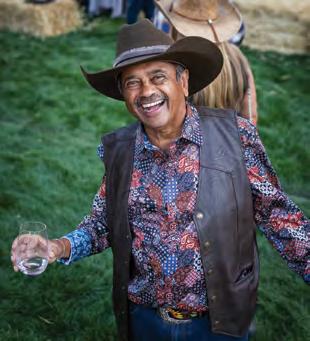
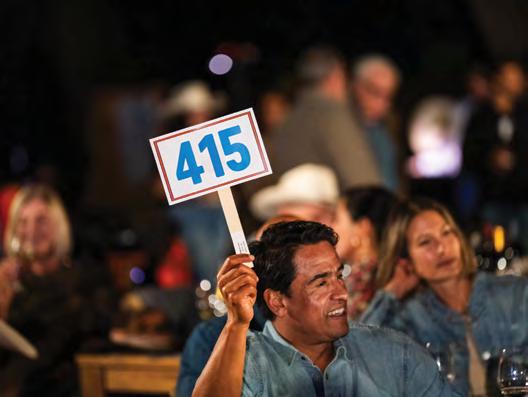

# PHOTOS COURTESY OF VISIT CALISTOGA
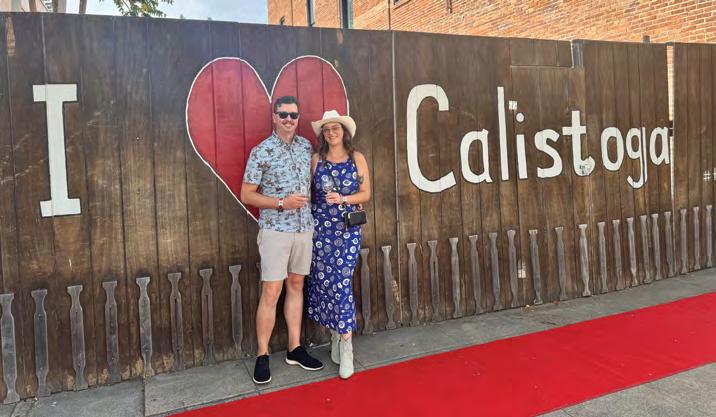
Calistoga’s Lincoln Avenue came alive on September 7 as the Calistoga Harvest Table once again transformed downtown into a 1,000-foot-long communal table celebrating the best of food, wine, and community. Guests enjoyed specially curated menus from 12 local restaurants paired with wines from 12 acclaimed Calistoga wineries, creating an unforgettable evening under the stars. New this year, full table purchases with VIP perks allowed groups to dine together in style, while individual ticket holders joined in the festive atmosphere with first-come, first-served seating. With lively conversation, delicious flavors, and the warm spirit of harvest season, the 2025 Calistoga Harvest Table was a true showcase of the town’s culinary and winemaking excellence. // www.visitcalistoga.com/harvest-table/
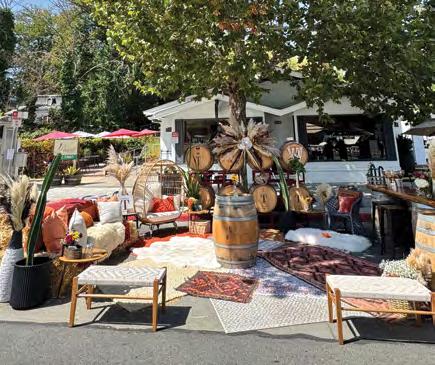
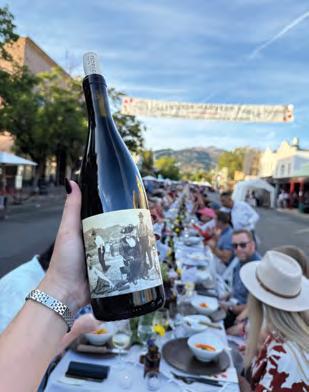
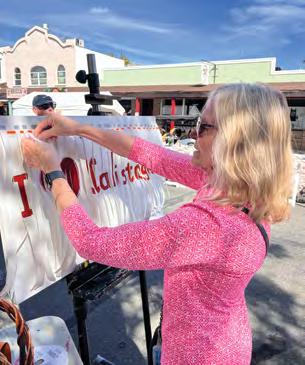
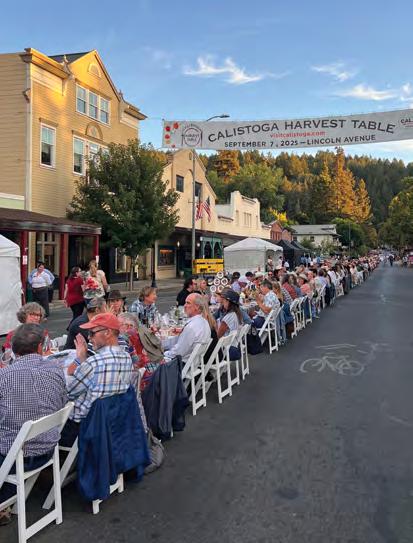
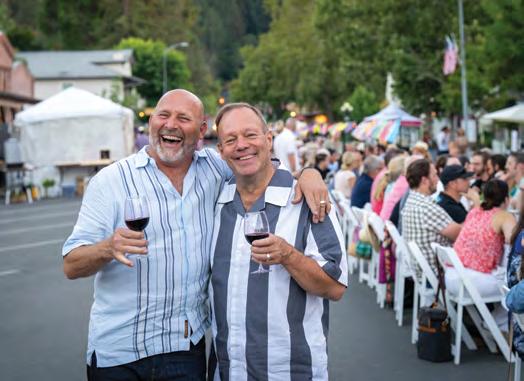


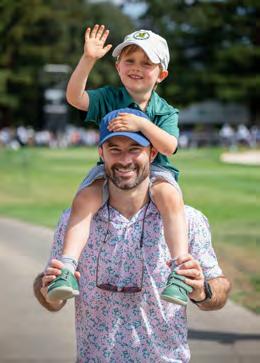
# PHOTOS COURTESY OF PROCORE CHAMPIONSHIP
The 2025 Procore Championship brought world-class golf back to Silverado Resort’s North Course in Napa Valley on September 11th – 14th. Featuring one of the strongest fields in tournament history, ten members of the 2025 U.S. Ryder Cup Team — including Scottie Scheffler, Justin Thomas, Patrick Cantlay, and Collin Morikawa — joined major champions, veterans, and rising stars for four days of thrilling competition. Scottie Scheffler emerged as the 2025 champion, clinching the title with a final score of -19. With dramatic play and an electric atmosphere, the event once again showcased Napa Valley as a premier destination for golf fans and PGA TOUR talent alike. // www.procorechampionship.com
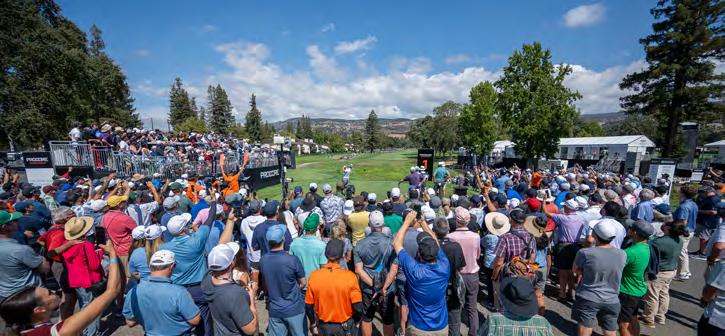



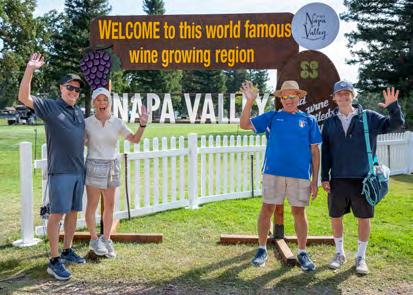


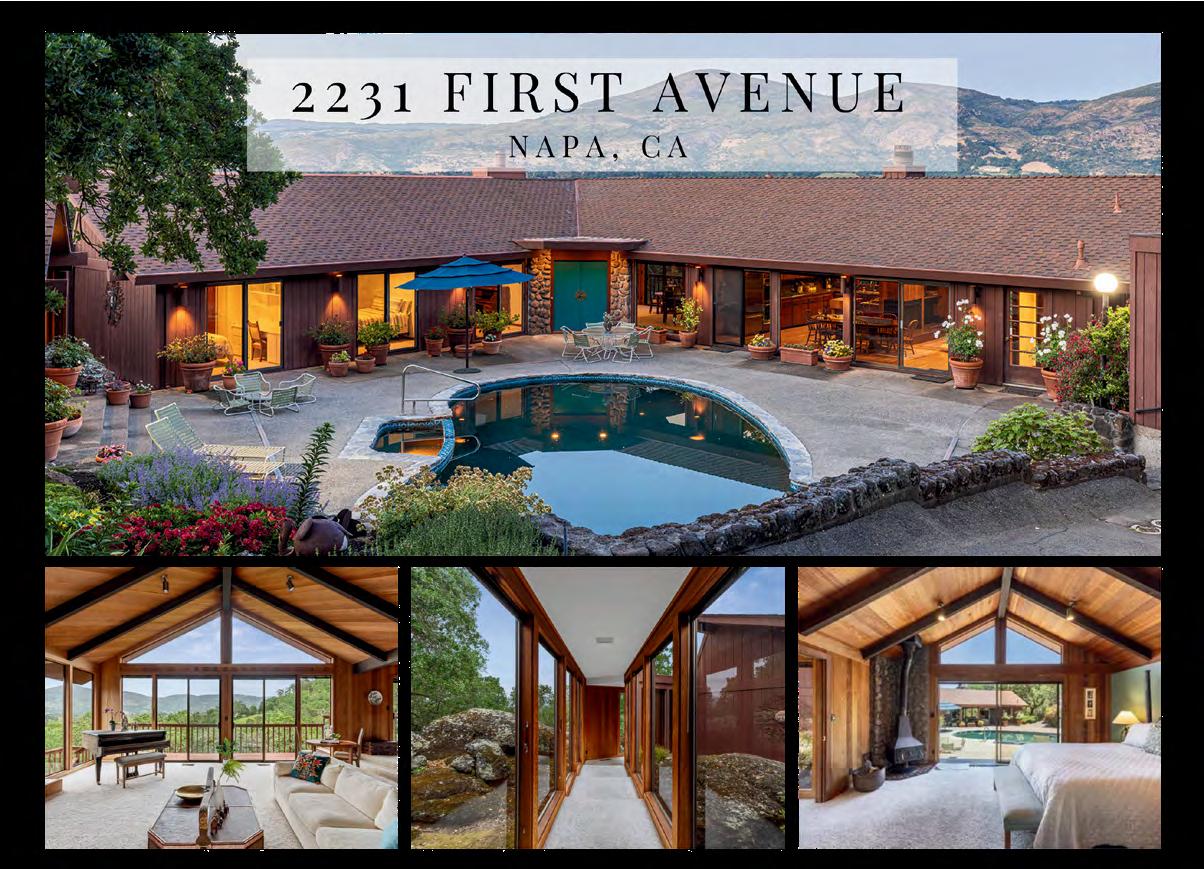



Event dates subject to change. Please check event websites for current schedules.
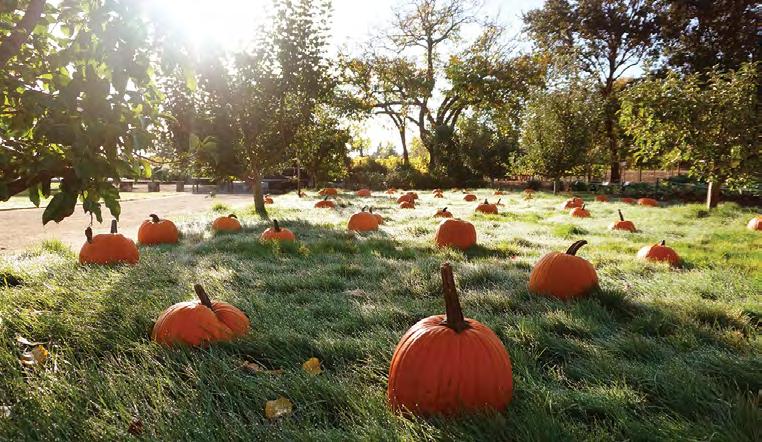
October 2025 through March 2026
NAPA COUNTY HISTORICAL SOCIETY PRESENTS THE VALLEY BEAUTIFUL: ART
Opening in October at the historic Goodman Library in downtown Napa, The Valley Beautiful: Art invites the public to explore how fine art and public art have captured, enhanced, and celebrated the beauty of Napa Valley. On view through March 28, 2026, the exhibit offers a rich perspective on the region’s landscapes and culture through the eyes of artists past and present. www.napahistory.org/events/
October 26
PUMPKIN CARVING + BRUNCH AT LONG MEADOW
Long Meadow Ranch invites guests to its annual Pumpkin Carving & Brunch at Farmstead in St. Helena. From 10:30am to 1:00pm, families can wander the apple meadow to pick the perfect pumpkin, carve a festive masterpiece at the hay bale stations, and display it while enjoying a seasonal brunch. Tickets are $85 for adults and $45 for children, with wine, beer, and cocktails
available for purchase, and each guest takes home their finished pumpkin— just in time to delight trick-or-treaters. www.longmeadowranch.com/event/ pumpkin-carving-brunch-2025/
November 1
Beringer Vineyards will transform its historic wine caves into a spooktacular setting for a Halloween Silent Disco from 6 to 9pm. Guests can dance the night away to eerie beats while sipping a complimentary glass of wine, with additional wines and delicious food available for purchase. Costumes are encouraged for this hauntingly fun celebration, with tickets priced at $45 per person and $36 for members. www.beringer.com/pages/winery-events
November 8
Chimney Rock Winery will host an intimate Harvest Winemaker Dinner in their barrel room, where Winemaker

Elizabeth Vianna and Assistant Winemaker Laura Orozco will guide guests through a four-course dinner perfectly paired with Chimney Rock wines. This enchanting evening will showcase freshly harvested flavors, fine wines, and the warm glow of fall, creating a convivial and memorable experience. www.chimneyrock.com/events/ Harvest-Winemaker-Dinner
8
The Culinary Institute of America at Copia in Napa will host the Howell Mountain Harvest Celebration, a rare opportunity to taste and order wines from over 40 Howell Mountain wineries, many of which are not open to the public. Guests can enjoy world-class wines paired with gourmet small bites prepared by CIA chefs, and bid on rare wines and exclusive winery experiences in the silent auction. Tickets are $175 in advance and $350 at the door—reserve early to secure your spot at this one-of-a-kind tasting event. www.howellmountain.org/events/ howell-mountain-harvest-celebration/
November 9
Raymond Vineyards invites guests to its Life in Red Art Series – Sip & Paint in The Grove, a creative outdoor experience blending art, nature, and wine. Set in the serene beauty of The Grove, this hands-on class is guided by a professional artist from Nimbus Arts and designed for all skill levels, offering a fun and welcoming atmosphere where creativity can flourish. All painting materials are provided, and each reservation includes a glass of Raymond wine, with additional pours available for purchase. Tickets are $95 per person or $75 for members, and participants will leave with their own vineyard-inspired masterpiece. www.raymondvineyards.com/ events/life-in-red-art-series-sipand-paint-the-grove-nov
15
ZD Wines will host its 2025 Harvest Celebration at their Rutherford Estate, featuring awardwinning wines paired with dishes by Winery Chef Jill deLeuze Billeci. Guests can enjoy live music, barrel samples, and a raffle hosted by the deLeuze Family Charitable Foundation, with 100% of ticket proceeds benefiting the Teen Center at the Boys & Girls Clubs of Napa Valley. www.zdwines.com/events/ harvest-celebration
29
Markham Vineyards invites you to embrace the holiday spirit with a festive Winter Wreath Class led by Napa native floral designer Chloe Vanessa. Guests will enjoy expert guidance in crafting a lush, fragrant holiday wreath while sipping on a complimentary glass of Markham wine, including their beloved Merlot. Tickets include all materials and tools, with special member pricing at $65 and non-member pricing at $80. Reservations must be made by November 22, and members can access their discounted rate by signing into TOCK with their wine club email. www.markhamvineyards.com/ event/winter-wreath-class/
Every Sunday, from 10am to 4pm, step into a little slice of French elegance at the JCB Salon in St. Helena. Their chic brunch experience includes a curated flight of sparkling wines paired with elevated bites—think signature caviar service and smoked salmon bagels with a luxe twist—beautifully presented on a tower for two. // 1320 MAIN ST, ST HELENA
WWW.JCBCOLLEECTION.COM/EVENTS
Announcing The Crush Pad, ONEHOPE’s Wine & Pickleball Club. Join the fun on the first Thursday of each month and gather with other locals to sip, rally, and unwind. Featuring ONEHOPE wines by the glass or bottle, pickleball, and games, golden hour vineyard views, and good vibes. Don’t forget to pre-order your choice of Chef Rafael’s woodfired pizza too! Complimentary entry ticket. // 8301 ST HELENA HWY., NAPA • WWW.ONEHOPEWINERY.COM
Napa Valley’s biggest holiday celebration transforms the Meritage Resort and Spa into a festive wonderland each year. Running from mid-November through early January, the event features an ice-skating rink, holiday lights, seasonal food and wine experiences, family-friendly activities, and special events that capture the spirit of the season in true Napa style. // 875 BORDEAUX WAY, NAPA
WWW.MERITAGERESORT.COM/EXPERIENCE/WINTER/
After a fresh remodel and exciting menu updates, Heritage Eats is thrilled to unveil its long-awaited brunch offerings. From indulgent chicken and waffles to Turkish eggs, classic benedicts, and a standout English muffin egg sandwich from Model Bakery, there’s something for every brunch lover. Join them weekends, Saturday and Sunday from 10am to 3pm, and make your mornings deliciously memorable. // 3824 BEL AIRE PLAZA, NAPA • WWW.HERITAGEEATS.COM
Join Markham Vineyards in St. Helena for their Third Thursdays series — a lively evening of live music, great company, and signature Napa Valley wines. Guests can enjoy performances from local musicians in a relaxed vineyard setting while sipping Markham’s acclaimed Cabernet and Merlot. Food trucks and light bites are often on hand. // 2812 ST HELENA HWY NORTH, ST HELENA WWW.MARKHAMVINEYARDS.COM/EVENTS/UPCOMING-EVENTS/
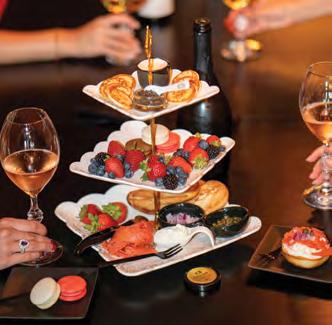

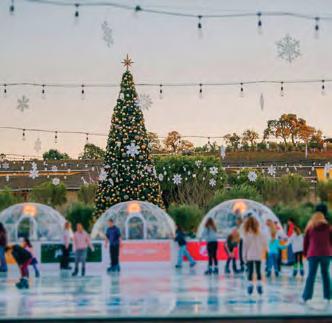
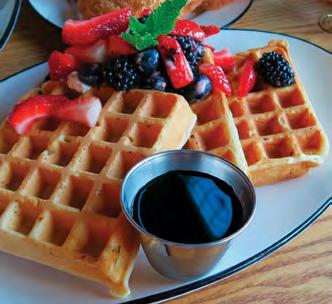
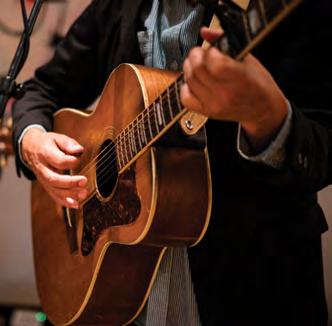
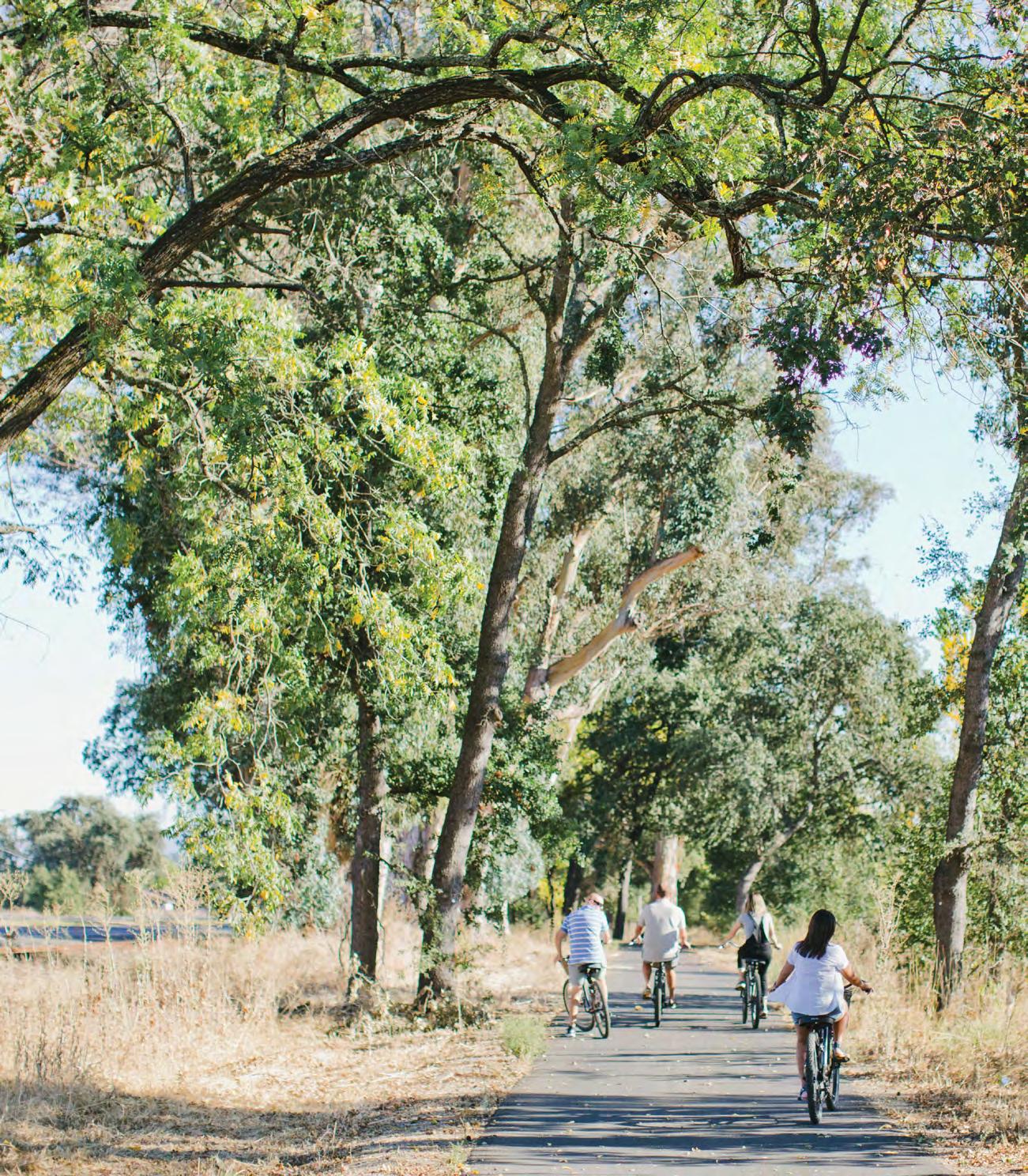
The recently debuted extension between St. Helena and Calistoga marks notable progress toward the dream of 47 miles.
BY JILLOIAN DARA
The Napa Valley Vine Trail Coalition is inching closer to their end goal of a 47-mile walking and biking trail that will meet their mission to “connect the entire Napa Valley—physically, artistically and culturally.”
“Today, there are 33 completed miles in three major sections used by 396,000 people annually,” shared Shawn CaseyWhite, executive director of the Napa Valley Vine Trail Coalition. There are 14 miles remaining to complete the dream of 47 miles—separate from cars—connecting Vallejo all the way to Calistoga along the main transportation artery of Highway 29.
As the Coalition looks toward the future, they’re also reflecting on how far they’ve come in less than two decades. The concept for the Vine Trail was the vision of the late wine industry executive Tom Shelton, who wished he could teach his children to ride their bikes on a safer route. At his celebration of life in 2008, the first $50,000 was raised to explore the feasibility of creating a bike route through the Napa Valley, and in 2009, the first phase of the trail debuted as the Yountville Mile Bike Lane.
“It’s an example of a successful privatepublic project that leverages private philanthropy and community support to unlock and secure federal and state transportation and safety grants set aside for projects exactly like this one.” —Shawn Casey-White
“The Vine Trail is collaboration in action,” said Casey-White, explaining how the Coalition works with every jurisdiction in the county—from American Canyon to the transportation authorities in Solano—as well as private landowners in Napa Valley who have donated easements to make the trail possible. “It’s an example of a successful private-public project that leverages private philanthropy and community support to unlock and secure federal and state transportation and safety grants set aside for projects exactly like this one.”
While the Vine Trail has served as an asset to the local community—increasing bike and pedestrian safety, providing alternative transportation choices, shifting cars off the highway, and reducing air pollution—Casey-White says her favorite part about the Vine Trail is how it connects
people in general, both the local community and visitors.
“Out on the Vine Trail, you might meet a teacher training for a marathon, a worldfamous winemaker out on a bike ride with his or her family, a Vallejo resident riding to work in Napa (the trail offers access to
EXISTING TRAIL
FUTURE TRAIL
VINETRAIL REST STOP SHELTERS
RAIL
NAPA RIVER
PUBLIC PARKS & POINTS OF INTEREST
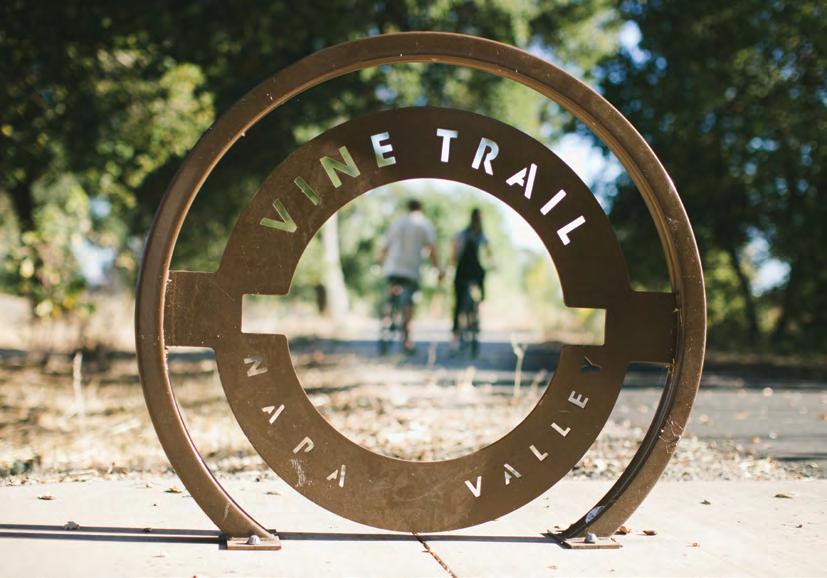
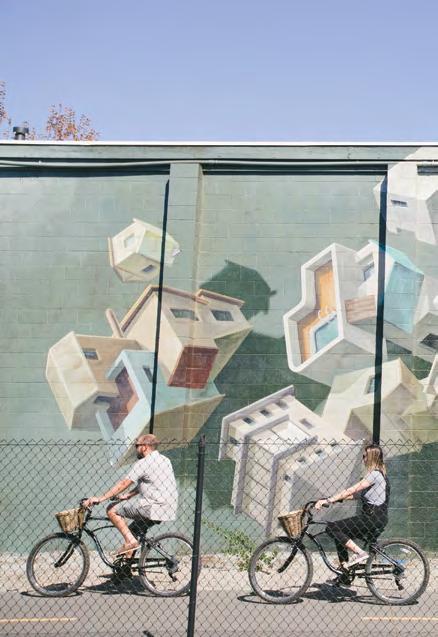
jobs at over 1,600 locations within half a mile along its corridor), a mom walking to the Farmers Market, a senior going to a doctor’s appointment, a formerly wheelchair-bound resident on his recumbent bike, an international visitor soaking in the Napa Valley, or even our very own U.S. Congressman Thompson out getting some exercise,” she says.
“Each section allows you to slow down and enjoy our valley at ground level.”
—Shawn Casey-White
For those unfamiliar with the trail, CaseyWhite likes to suggest picking one of the three main sections of the trail for a leisurely bike ride or walk “to get to know the trail” better. “It’s your Vine Trail,” she prefaced. If she had to choose a couple of her favorite routes, they’d be a longer ride along the 16-mile loop between St. Helena and Calistoga or a casual two-mile stroll from Bothe-Napa Valley State Park to Larkmead Vineyards. “You can leisurely walk along the vineyards through Twomey and Sterling Vineyards,” she added. For further inspiration, Casey-White suggested: “Ride your bike from American Canyon High School to the Vallejo Ferry next time you go to the SF Giants game.” Or rediscover the Rail-Arts District of Napa, a free outdoor contemporary art museum between Vallejo and Jefferson, then loop back for smoked brisket at Stateline Road Smokehouse. “Each section allows you to slow down and enjoy our valley at ground level,” said Casey-White.
FOR MORE INFORMATION www.vinetrail.org www.radnapa.org // www.napavalleybiketours.com
For visitors strapped for time, CaseyWhite summarized her top five highlights on where to stop along the Vine Trail, whether seeking exercise in between wine tastings or using the trail to connect vineyard experiences.
1 2 3 4 5
From St. Helena to Calistoga, you’ll ride through Bothe-Napa Valley State Park, a shaded respite with hiking trails, a welcoming picnic area, and even a spring-fed public swimming pool.
The Napa Valley Vintners created two one-mile walking routes to visit three wineries along the trail. The first route connects three famed St. Helena wineries: Charles Krug Winery, Ballentine Vineyards, and Markham Vineyards. The participating wineries all donated precious land to make this possible for visitors and locals alike.
You can rent a bike from Napa Valley Bike Tours at Charles Krug Winery. When you return, you can have one of their brick oven pizzas and a splash of Napa Valley wine.
Enjoy the urban art pieces along the trail from the Vallejo Ferry and look out for the ‘Trolls Under the Bridge,’ an artwork created by Vallejo artist Miro Salazar, displayed on the support beams beneath the Mare Island Causeway Bridge.
Ride a bike to the section of the Vine Trail that runs from Vallejo Street to Lincoln Avenue to view the newly displayed Quake Mosaic, a large-scale public artwork by Kristina Young. Over the past decade, Young collaborated with more than 2,000 community members to transform tons of broken household objects—donated after the 2014 earthquake and two devastating wildfires in 2017 and 2020—into a massive mosaic inspired by underground geological strata.
BY FRAN MILLER | PHOTO COURTESY OF RIDE NAPA VALLEY
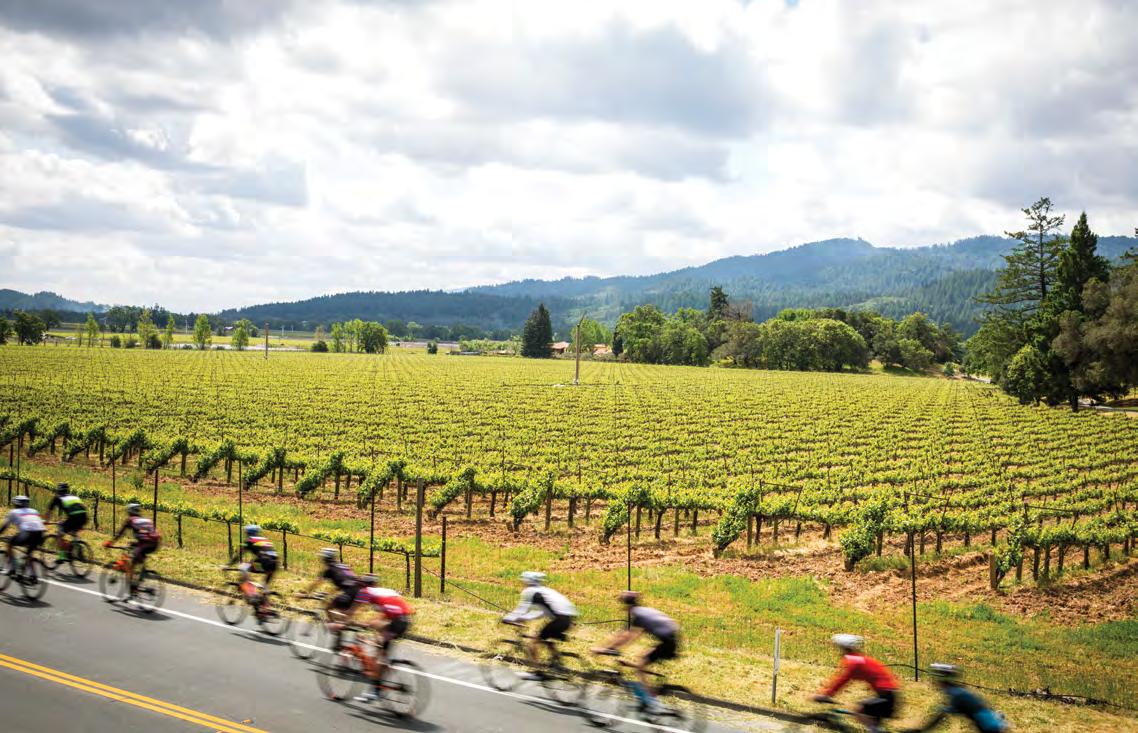
As the leaves turn and the vineyards blaze with fall color, there’s no better way to experience Napa Valley than on two wheels. October and November bring prime conditions for cycling: crisp air, quiet roads, and panoramic views stretching from sun-drenched hillsides to vine-lined lanes. But fall in Napa isn’t just scenic—it’s also a season for purposedriven pedaling.
On October 26, the second annual Going for Gold benefit ride returns to Napa, rallying support for the Napa County Bicycle Coalition (NCBC). The Coalition’s mission? To help Napa earn Gold-Level Bicycle Friendly Community status from the League of American Cyclists—a recognition reserved for places where biking is safe, convenient, and embraced by all.
The day kicks off with Riding for Gold, a morning ride led by cycling congressman Mike Thompson (CA-04) and Napa native/ former pro cyclist Lucas Euser. It’s followed by an afternoon mixer and speakers panel (4–6pm at The Fink in downtown Napa), spotlighting how advocacy, infrastructure, and education are shaping Napa’s cycling future. From green lanes and bike safety workshops to a human-powered street sweeper, NCBC is quietly transforming the region—pedal by pedal.
“We think of ourselves as a community within a community and are always welcoming locals and visitors alike.”
–Rebecca Kotch, founder Ride Napa Valley
Just up the valley, another celebration of cycling is set to debut. The inaugural Tour de Calistoga rolls into town the weekend of October 31, offering a full-bodied blend of world-class cycling, boutique wines, gourmet cuisine, and wellness. Hosted by Vine Trail Adventures in partnership with Ride Napa Valley, the Calistoga Chamber of Commerce, and chef/cyclist Matt Accarrino, this event promises a high-touch experience that merges athleticism with indulgence. Riders will traverse scenic backroads by day, then gather for evening feasts honoring Napa’s culinary culture—paired with wines from the Calistoga Wine Growers. Proceeds benefit both NCBC and the Boys and Girls Clubs of St. Helena and Calistoga.
Beyond these signature events, Napa’s cycling community thrives year-round. Whether you’re a casual cruiser or a serious roadie, the region offers routes for every level—and a growing network of locals who share the same passion. For those looking to ride beyond the season, Ride Napa Valley offers guided group rides and community events throughout the year, such as Rock the Ride, an annual bike ride and walk benefitting gun violence prevention. With the motto “serious fun about cycling,” the club is open to all. Discover new routes, make new friends, and toast each ride with a well-earned cup of coffee.
“It’s great to see the growing population of cyclists across the valley,” says Rebecca Kotch, founder of Ride Napa Valley. “Thanks in part to the work of the Napa County Bicycle Coalition, which focuses on infrastructure and safety, as well as the Napa Valley Vine Trail Coalition—with its game-changing class one bike trail down the spine of the valley—cycling has become more accessible for all levels of riders. We think of ourselves as a community within a community and are always welcoming locals and visitors alike.”
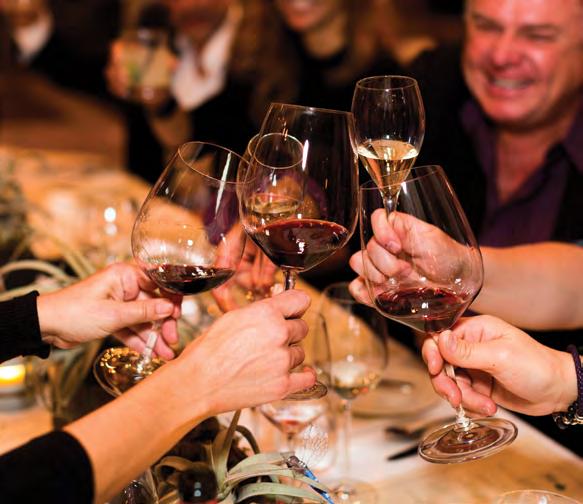
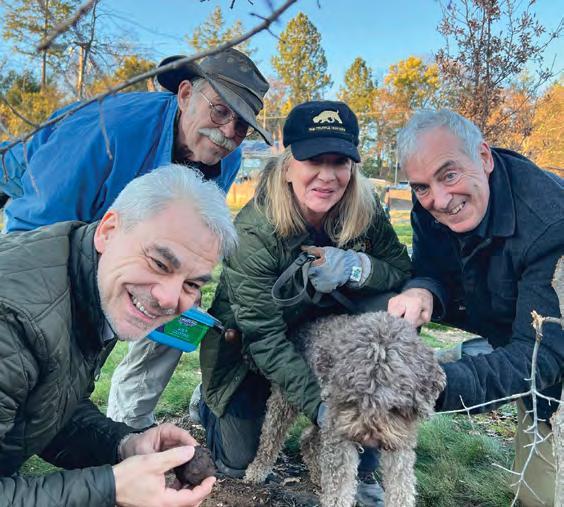
European-produced Périgord black truffles have long been considered the pinnacle of excellence. One of the world’s most expensive gourmet delicacies, these fantastic fungi command some of the highest prices of any truffle. But recently, Michelin-awarded American chefs have declared that American-produced Périgord truffles are every bit as good as those harvested in Europe.
For Robert Chang, Chief Truffle Officer of American Truffle Company® and founder of the popular Napa Truffle Festival, this acknowledgment is akin to the “Judgment of Paris,” referencing the 1976 Paris Wine Tasting when Napa wines ranked highest against French and European wines, forever changing the world’s perception of American wine.
Because truffles are highly perishable, with a half-life of only five days, domestically grown truffles—which can be harvested and served within hours rather than the many days it takes to meander through the supply chain from Europe—offer the optimum aroma and flavor prized by chefs and epicureans.
According to Chef Ken Frank of the highly acclaimed La Toque restaurant in Napa Valley, and one of the country’s

foremost culinary experts on truffles: “Freshness is the holy grail of quality with truffles. In fact, there is no difference in quality among Périgord black truffles grown anywhere in the world.”
In 2024, American Truffle Company® harvested its first icon-class truffle—among the top 2% of truffles harvested globally. One week later, another even bigger truffle was harvested. Chef Frank immediately served
both truffles at La Toque, marking the first time an American-produced Périgord truffle was served in his Michelin-awarded restaurant. The excitement continued into high gear in 2025 when Chef Frank and Michelin-star Chef Gabriel Kreuther of New York City both personally harvested large truffles from one of American Truffle Company®’s truffle orchards in Napa. These momentous harvests were reported in the media as “truffle treasures unearthed.”
“American-grown truffles have arrived,” says Chang. “As production continues to increase, our ultra-fresh truffles will be available to fine restaurants, as well as consumers directly, in a way that was never before possible.”
Foodies can taste and learn more about truffles at the Napa Truffle Festival, January 16–19, 2026. The weekend includes experiential truffle programs, extraordinary truffle meals, truffle dog demos, and one big free Truffle Marketplace at the Oxbow Public Market, featuring fresh truffles and exciting new truffle products for sale. Tickets available October 1, 2025 on the festival website, www.NapaTruffleFestival.com.
FOR MORE INFORMATION: www.AmericanTruffle.com // www.NapaTruffleFestival.com

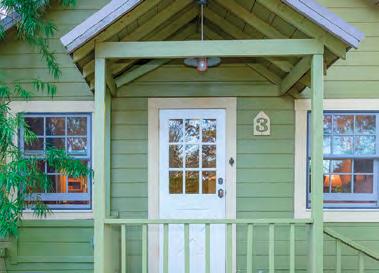
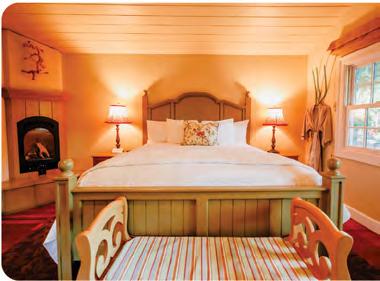
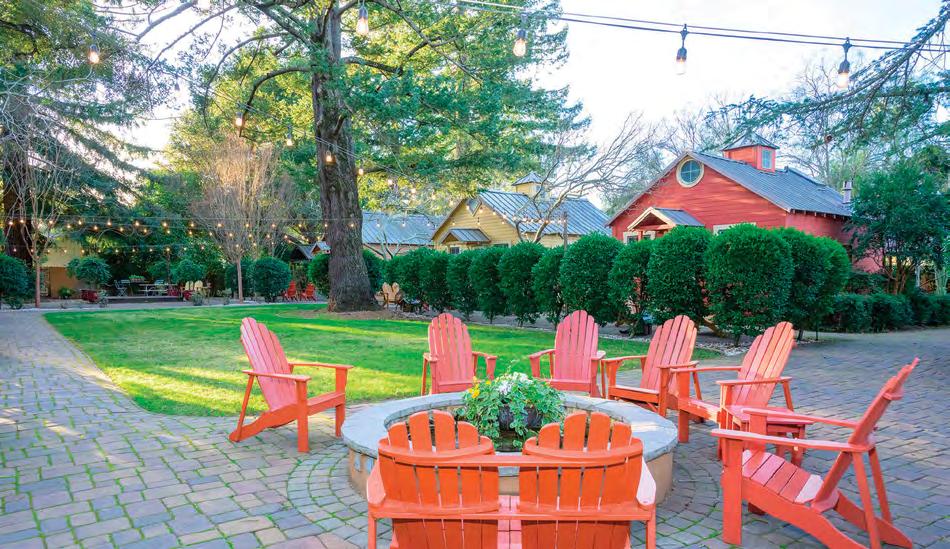
At The Cottages of Napa Valley, there’s more than just a beautiful place to stay; there’s a story of creativity, craftsmanship, and passion woven into every detail. That story belongs to Mike Smith, the owner and artistic genius who brings these enchanting cottages to life.
Just 3 miles from Yountville, this charming retreat is perfect for gathering loved ones over the holidays, treating yourself to a romantic staycation, or hosting corporate events.
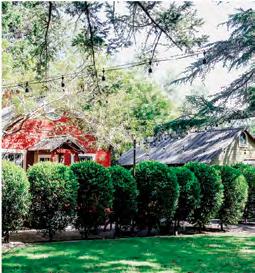
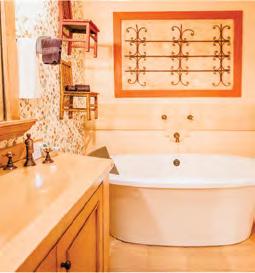

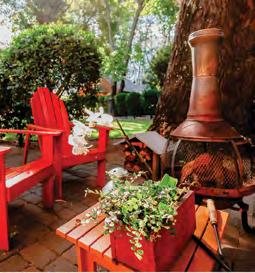


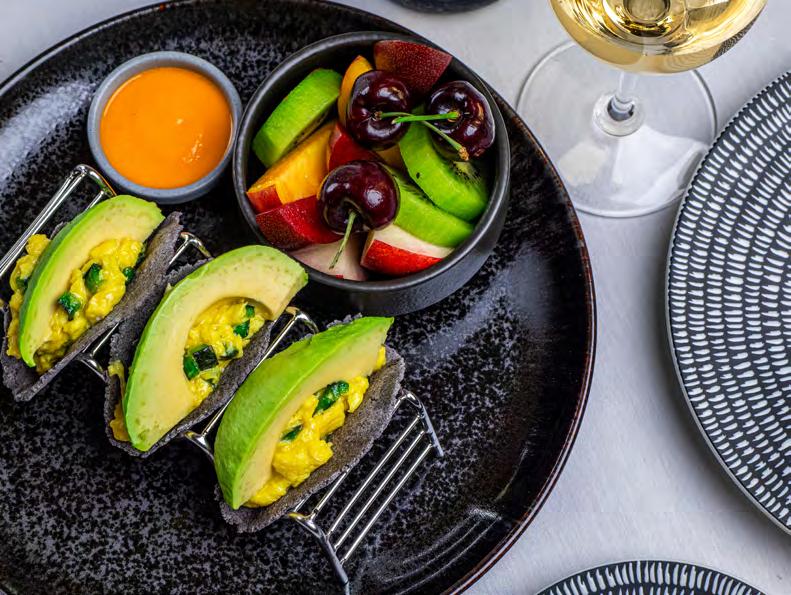
Eight North channels Alaskan heritage through a Napa lens, positioning itself as Calistoga’s living room—restaurant, bar, wine hub, and gathering place—under one roof. The Lawer family (Lawer Estates Winery) is reimagining the former Brannan’s Grill space on Lincoln Avenue as an all-day utility player for locals and visitors alike. Expect a seasonal menu from Chef Abby Burk, wines with a strong Calistoga/Napa accent (including Lawer), and a program that comfortably spans zero-proof, classic cocktails, and tasting-room flights. The intent is neighborly and celebratory: a venue for openings, club events, and “come-as-you-are” evenings after a day on the valley floor. Opening soon!
FOR MORE INFORMATION www.tasteeightnorth.com

TR Bar (the relaxed counterpoint to fine-dining sibling Ilora) is slated to bring laid-back luxury to downtown Calistoga in 2027. The vibe: a ranch-inspired brasserie in the historic Odd Fellows brick building on Lincoln Avenue—high ceilings, generous light, and patio energy for long afternoons. Theorem Vineyards and Theorem Ranch proprietors Kisha and Jason Itkin, with chef Erik Anderson (French Laundry, Coi alum), are aiming squarely at craveable comfort: smashburgers, steaks, and boozy shakes— executed with precision and a serious bar. Paired with Ilora’s 1880s landmark across the street, TR Bar is part of a twovenue push to raise Calistoga’s culinary profile well beyond resort dining.
FOR MORE INFORMATION www.theoremvineyards.com

Napa has made it explicitly illegal to cut through private property or parking lots to avoid stop signs, signals, or turn restrictions. The new municipal code §10.32.120 emphasizes pedestrian safety and business access; no posted signage is required for a violation. Fines escalate: $100 for a first citation, $200 for a second within 12 months, and up to $500 thereafter. Enforcement begins mid-September 2025. Bottom line: keep to public streets—“saving a minute” will cost you. FOR MORE INFORMATION www.cityofnapa.org
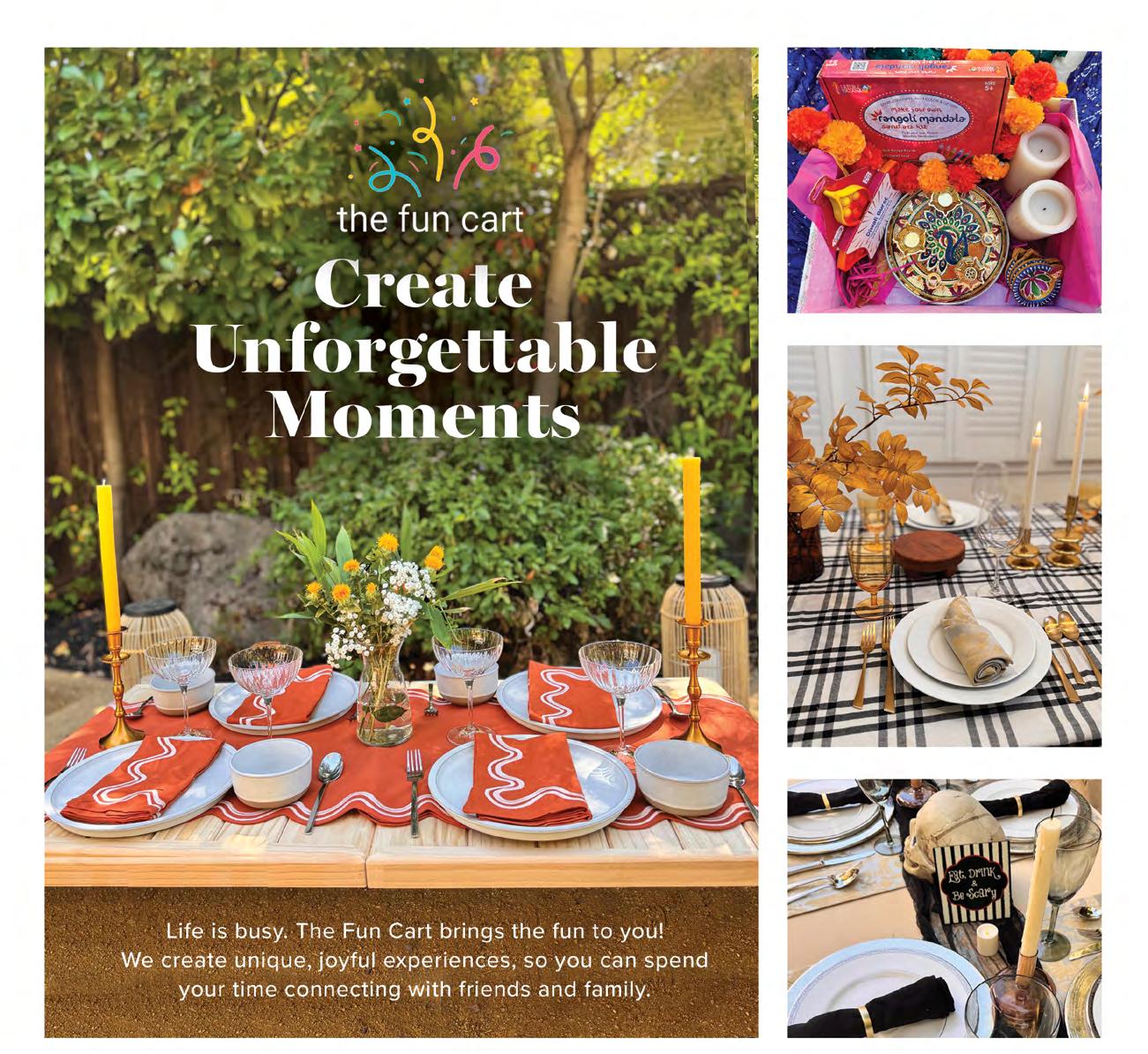

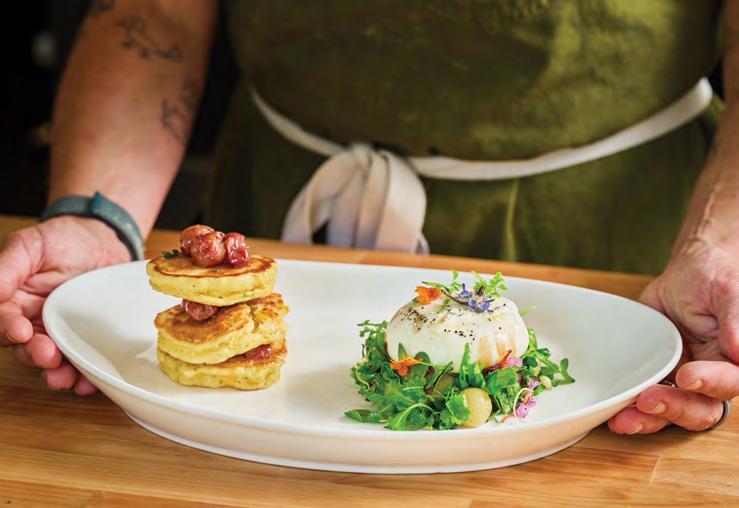
Clementine is the conversation piece of the moment in Yountville— bright, polished, and confidently rooted in Wine Country sensibilities. Executive chef Rebecca Weitzman steers a seasonal, Mediterraneanleaning menu that reads refined but unfussy: think mustard-crusted lamb, wood-grilled octopus with artichokes, and flatbreads topped with market-driven additions like zucchini blossoms or truffled burrata. The mood is “elegant casual,” with a citrus-forward bar program (Aperol spritzes, a Clementine Margarita, house limoncello) designed to play well with warm evenings and local bottles. Reservations are advisable; the opening buzz hasn’t let up. If you want something new that still feels Napa, this is the table to book.
FOR MORE INFORMATION 6525 Washington St., Yountville // www.clementineyountville.com

Mark Herold Wines has traded its Oxbow-district digs for a high-visibility Oakville address on St. Helena Hwy—the ivy-clad former Cosentino site now owned by vintner Brion Wise. The tasting room is open daily, 10am–4pm, with experiences that spotlight Herold’s Cabernet-driven portfolio alongside curated pours from B. Wise Vineyards. The move puts guests directly on Highway 29 with easy patio access and room for programming; it also signals a broader Wise-led investment in the property. The new location boasts a: bigger footprint, stronger traffic, and a tasting lineup that can go deep for serious Napa red fans.
FOR MORE INFORMATION 7415 St. Helena Hwy, Napa www.markheroldwines.com
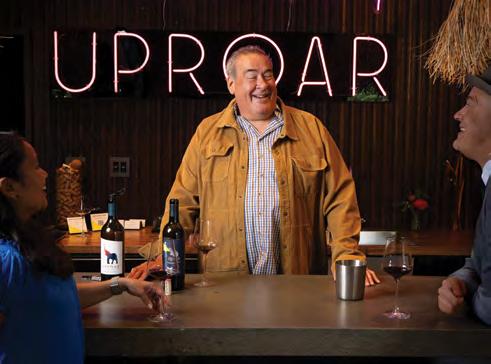
Wine Country’s events calendar just went glossier: Palm Tree Music Festival made its Napa debut on October 11, 2025 at The Meritage Resort & Spa. Co-presented by Another Planet Entertainment and Blue Note Napa, the one-day, 18+ event blended resort-level hospitality with a main-stage built for spectacle—Kygo and The Chainsmokers headlined, with support from Odd Mob, Vandelux (DJ set), Mia Moretti, and Goshfather. Sunset sets and vineyard-view staging delivered a polished, Hamptons-meets-WineCountry energy—exactly the kind of cultural flex Napa’s been courting.
FOR MORE INFORMATION The Meritage Resort and Spa 875 Bordeaux Way, Napa // www.palmtreemusicfestival.com/napa
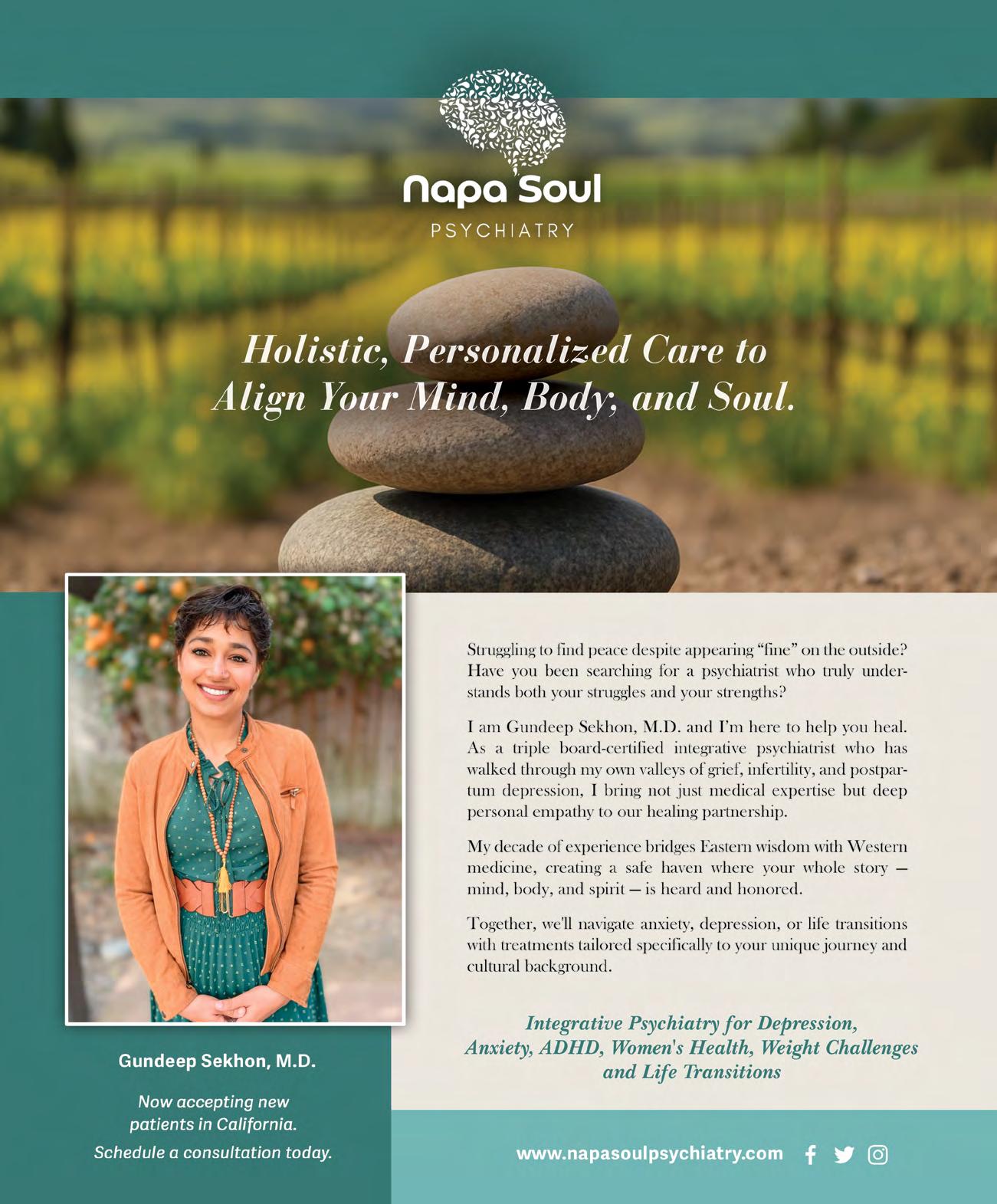
Napa Valley gift ideas for everyone on your list

A witty, wise memoir about trading boardrooms for barrel rooms, The Accidental Vineyard follows Silicon Valley executive Rich Moran as he unexpectedly becomes a winemaker. Perfect for dreamers and wine lovers alike, it’s a delightful reminder that it’s never too late to uncork a new chapter— and savor the unexpected.
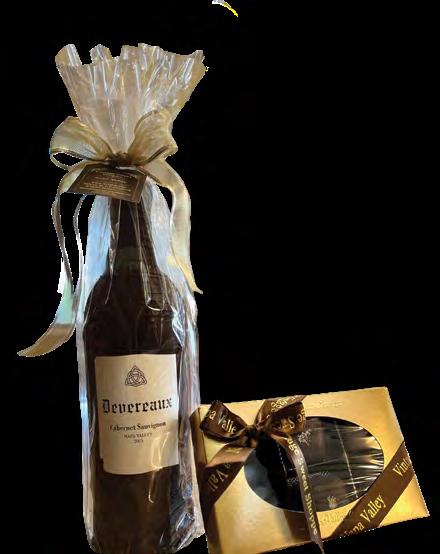
PRICE: $27 • WHERE TO BUY: WWW.SIMONANDSCHUSTER.COM/ BOOKS/THE-ACCIDENTAL-VINEYARD/ OR WHEREVER BOOKS ARE SOLD
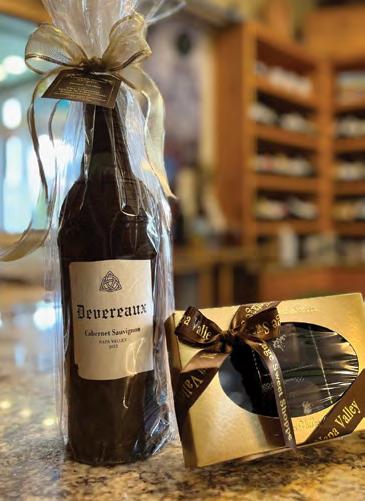
Aeration made beautiful. The perfect pour. Drip free elegance. TRIbella has been called the “Greatest aerator of all time,” and is an absolute joy to give- and receive. Complete the circuit of beauty from bottle to glass like never before.
PRICE: $40 • WHERE TO BUY: WWW.TRIBELLAWINE.COM OR AMAZON.COM/TRIBELLA
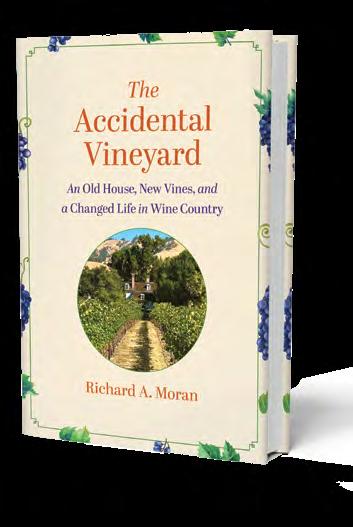
A full bottle of wine, shrink-wrapped, covered in rich chocolate, and beautifully gift-wrapped in cellophane, paired with Vintage Sweet Shoppe’s signature handmade dark sea salt caramels—some of the best you’ll ever taste. This unique gift is unforgettable. Some might even say it’s perfection. Custom orders available by phone.
PRICE: $48 – $200 • WHERE TO BUY: WWW.VINTAGESWEETSHOPPE.COM

This elegant collection of Padis 14K gold pendants showcases timeless charm with modern appeal. Each design is


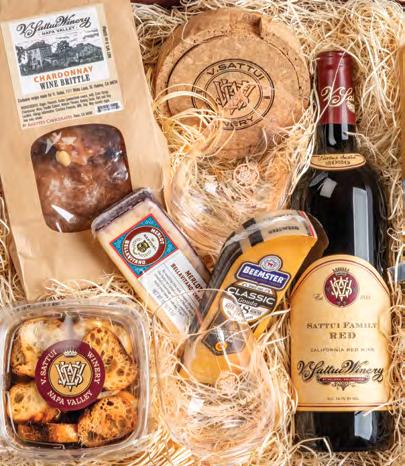
Your happy place, delivered! This festive collection features savory cheeses, crostini, and Chardonnay brittle, paired with stemless logo glasses, a cheese knife, and coasters. Customized with a choice of V. Sattui’s winery-exclusive wines, it’s the ultimate holiday gift of flavor and cheer.
PRICE: $137 – $165 WHERE TO BUY: WWW.VSATTUI.COM

Clif Family's Organic Extra Virgin Olive Oil is blended from handpicked olives grown in the sunshine of their organic farm in the Napa Valley. This unique blend of Arbequina, Manzanillo, Sevillano, Koroneiki and Mission varieties creates a wellbalanced, vibrant oil with subtle fruit flavors and hints of pepper.
PRICE: $35 • WHERE TO BUY: WWW.CLIFFAMILY.COM

Saddle up for a 45-minute, horseback ride through the historic Rapp Ranch vineyards at Shadybrook Estate Winery, guided by knowledgeable wranglers amidst stunning views and fragrant breezes. Then, unwind on the Grand Terrace for the Perfect Pairing Experience featuring a selection of Estate wines, cheeses, charcuterie and seasonal accompaniments – surrounded by Coombsville’s breathtaking hills. Gift Certificates Available.
PRICE: $250 PER PERSON • WHERE TO BUY: WWW.SHADYBROOKESTATE.COM/COLLECTION/ GIFT-CERTIFICATES/
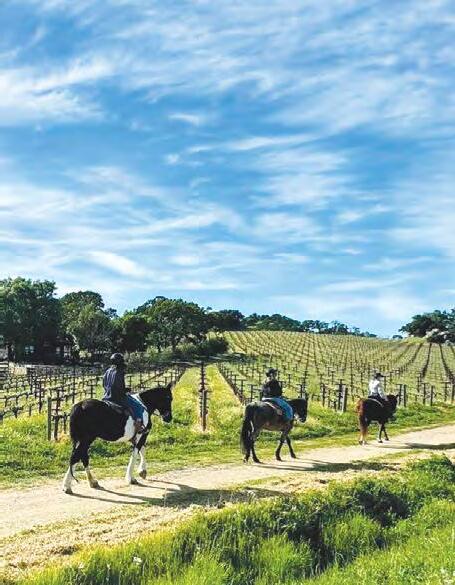
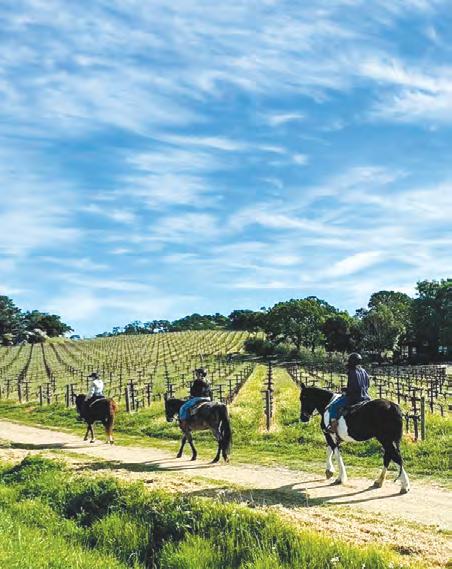

Give the gift of beauty and self-care this season. Whether it’s a holiday party, date night, or just a well-deserved moment of pampering, a gift card from Whirlwind is the perfect gift for everyone on your list (including yourself!).
PRICE: $25 AND UP • WHERE TO BUY: WWW.WHIRLWINDBLOWDRY.COM
For that fashionable friend who enjoys sipping in style, the Coupe de Rosé gift set features four flirty coupes with a vintage petal design in blushing pink, ready to be filled with the accompanying bottle of sophisticated Domaine Carneros 2021 Brut Rosé Sparkling Wine– brimming with notes of tangerine, peach, and rose petal.
PRICE: $110 • WHERE TO BUY: WWW.DOMAINECARNEROS.COM

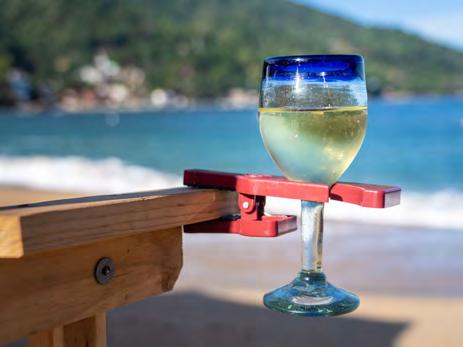

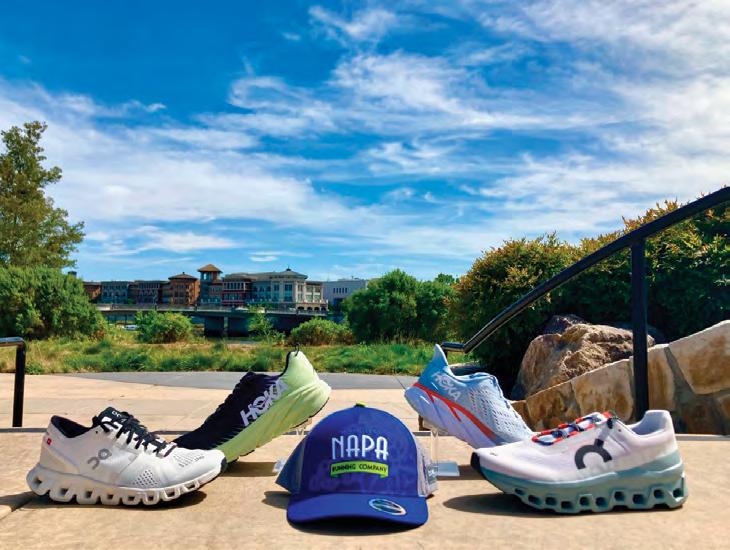
Give the gift of premium performance with HOKA and ON Running shoes –engineered for racing, training, and all-day comfort with superior cushioning and energy return. Not a shoe person? Napa Running Company has you covered with premium apparel from Vuori, Patagonia, Rabbit, and Janji. Complete the perfect runner’s gift with a stylish BOCO hat.
PRICE: $32 – $170 • WHERE TO BUY: WWW.NAPARUNNINGCOMPANY.COM
wineGrasp® keeps your drink safe and within reach. The strong grip allows attachment to surfaces up to one inch and the ergonomic design makes it easy to use. Fits most rounded stemware. A perfect take along and makes a great gift or stocking stuffer. Made in the USA. Wholesale pricing available.
PRICE: $9.99 // SET: $19.99 • WHERE TO BUY: WWW.WINEGRASPCO.COM
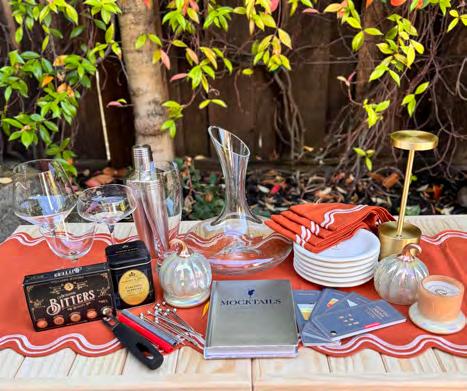
The Fun Cart, Napa’s Boutique Event Planning Company, is here to save the Holiday! The Fun Cart helps even the most prepared host get ready for and liven up the Holiday Season in style. Customized for any budget, these Holiday Host Kits come with a variety of tableware, furnishings, and activities to create memories that will last a lifetime.
PRICE: $75 AND UP • WHERE TO BUY: WWW.THEFUNCARTEVENTS.COM
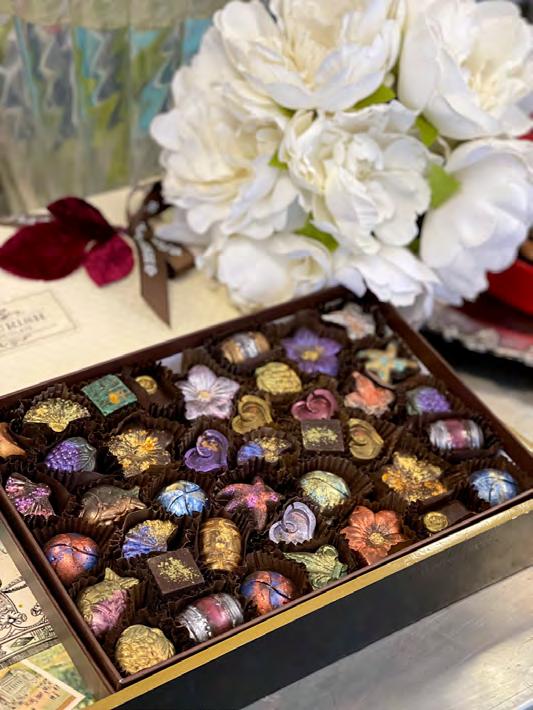

Introducing one of their most popular items—the diamond tennis bracelet. Available in one to ten-carat total diamond weight, white or yellow 14KT gold, with lab-grown or natural diamond. Blue Diamond Jeweler (formerly Napa Valley Jewelers) is celebrating 50 years of serving customers.
PRICE: STARTING AT $875 • WHERE TO BUY: WWW.BLUEDIAMONDJEWELER.COM
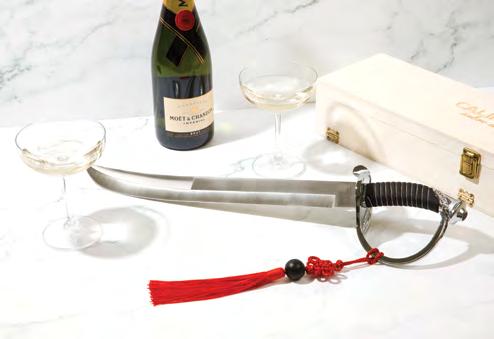
The perfect gift for anyone on your list, hese beautiful bonbons by Flourish Chocolate are handcrafted by Chef Holly Peterson in Calistoga. The Chef's selection of gems includes a multitude of shapes each filled with sumptuous and unusual ganache flavors from Blackcurrant Violet or Watermelon to Dark Chocolate Walnut or Tiramisu. Available in three sizes. Domestic shipping available
PRICE: $36 – $140 • WHERE TO BUY: WWW.FLOURISHCHOCOLATE.COM
This beautifully crafted candle from Golden Sunset Candles Co. is the perfect hostess gift or stocking stuffer. It features a sleek black glass jar with a rose gold lid for a modern, refined look. The "Cozy Fall" candle is made from all-natural soy and handcrafted with care. Its clean design, warm glow, and comforting scent make it a stylish accent while creating a cozy atmosphere –perfect for the fall and holiday season.
PRICE: $6 TO $38 • WHERE TO BUY: WWW. GOLDENSUNSETCANDLESCO.COM

Founded in 2013, California Champagne Saber Company specializes in producing handmade Champagne Sabers using Italian and French artisan manufacturing techniques. Each saber in their Le Sabre collection is made completely by hand before being packed in its trademark pinewood display crate. Each sabre can be personalized further via laser etching.
PRICE: $249.95 / $289.95 WITH PERSONALIZATION WHERE TO BUY: CALIFORNIACHAMPAGNESABERS.COM
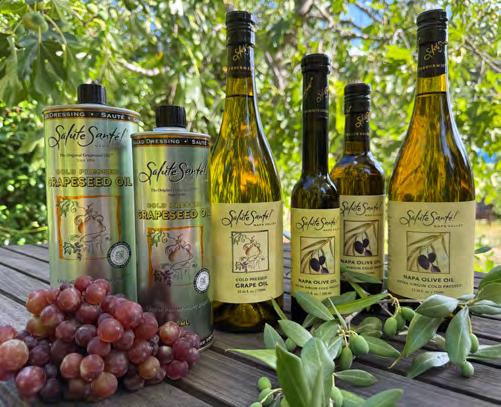
A new treasure alongside their AwardWinning Cold Pressed Grape Oil, this 2,777 bottle limited-edition Extra Virgin Cold Pressed Tuscan Cuvée Olive Oil is made right here in Napa Valley. It combines old-world craftsmanship with cutting-edge technology. Gift this delicious Olive Oil to yourself and your favorite foodie!
PRICE: $13.95 TO $35 • WHERE TO BUY: WWW.GRAPESEEDOIL.COM
BY FRAN MILLER | PHOTOS COURTESY OF BLUE DIAMOND JEWELER
When Altaf Amlani talks about diamonds, he rarely begins with carats or clarity. Instead, he talks about energy. Connection. Oneness. He quotes Socrates, invokes the Oracle of Delphi, and references physics professors. He reflects on a transformative moment from his childhood in England—standing outside a school building at age eleven, not knowing what his future held.
“That questioning—about the nature of life, the nature of people— became the seed of everything I do,” he says.
Today, that seed has blossomed into Blue Diamond Jeweler, a downtown Napa boutique specializing in bespoke wedding and engagement rings, a luxurious selection of bracelets and necklaces at a range of price points, high-end estate jewelry, and a curated inventory of certified pre-owned timepieces. The storefront at 1300 First Street—formerly home to Napa Valley Jewelers—has been completely reimagined. The ambiance feels more like a salon than a retail store: champagne in stemmed flutes, soft seating, and an unhurried invitation to linger.
“People come to Napa for special moments,” Amlani says. “Romance, cuisine, connection—it’s romantic here.
And we fit into that niche. We’re here for people ready to mark something meaningful. Napa is already the place to wine and dine. Now, it’s also the place to shine.”
Founded in 1974, Blue Diamond has long made its mark in Southern California, with locations in Manhattan Beach, Long Beach, and El Segundo. This Napa location, its first in Northern California, is equally a reflection of Amlani’s distinctive philosophy. It’s a boutique that functions not just as a jeweler, but as a vessel for shared humanity.
At Blue Diamond, bespoke is everything. From the initial consultation (often held over champagne) to the final unboxing, each ring is infused with narrative. Clients collaborate with Amlani, his staff, and his in-house manufacturing team to co-create pieces rooted in personal stories: an heirloom diamond reimagined, a stone sourced to honor a family tradition, or a wax model refined until it’s just right.
“We create the space where your inner artist can come out and play,” says Amlani.


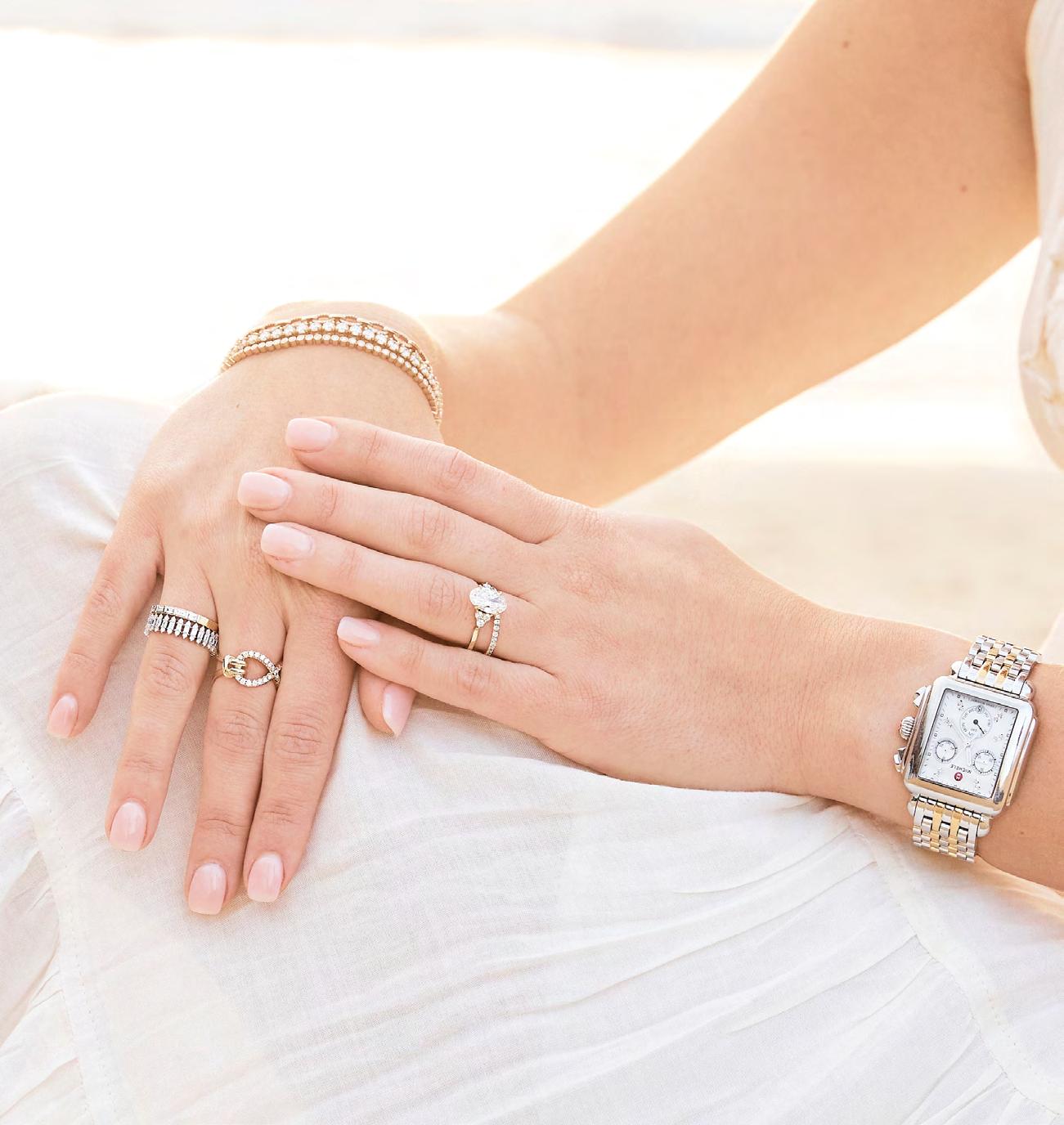
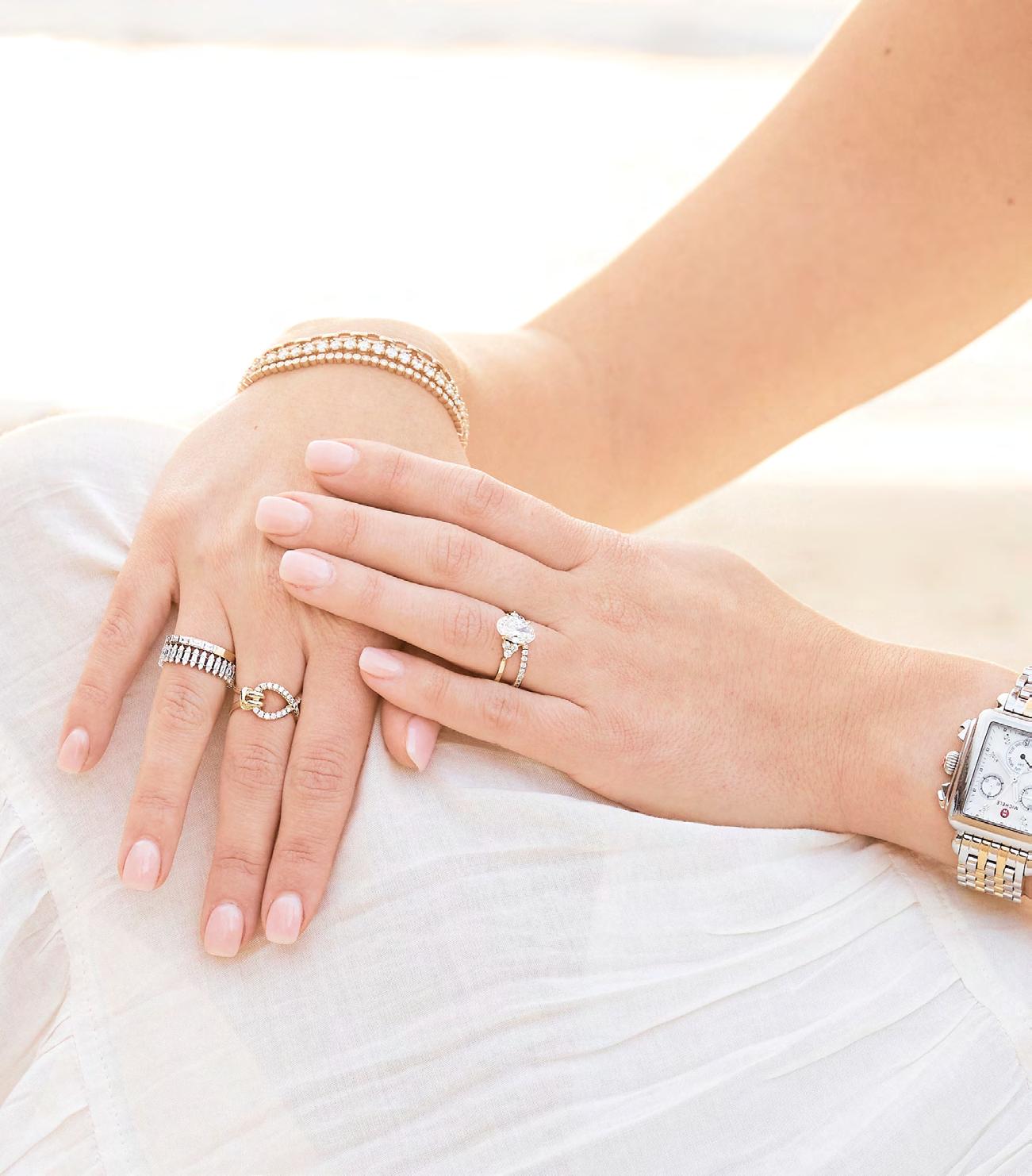


“From this space, the perfect ring will come out. Not perfect by some universal standard, but their perfect. A reflection of their relationship.”
Some patrons visit in person, drawn by the boutique’s intimate, creative energy. Others collaborate remotely via video, approving designs and selecting stones in real time before collecting the finished piece—often timed with a proposal at a nearby vineyard or dinner at one of Napa’s Michelin-starred restaurants.
Bespoke is only the beginning. The boutique also curates a rotating collection of estate pieces from legendary houses like Van Cleef & Arpels and Chanel, along with certified watches from Rolex, Cartier, Patek Philippe, and Chopard. Clients searching for something specific can access Blue Diamond’s exclusive concierge service, which leverages five decades of industry relationships to discreetly source exceptional pieces. Repair and restoration services are also robust, offering chain repairs, heirloom polishing, full watch movement overhauls, and
Amlani’s roots in the jewelry world run deep. Originally from Uganda, he grew up watching his father import and wholesale stones to jewelers around the world. As a teenager apprenticing in the family business, he observed the industry’s machinery—but felt a deeper calling. He didn’t just want to move inventory. He wanted to illuminate souls.
His philosophical leanings deepened in a college physics class, where a professor introduced the concept of a unified field of energy—the idea that, at the most fundamental level, everything is interconnected. That concept resonated with his spiritual and poetic sensibilities.

even a walk-in Jewelry Spa for cleanings and steam treatments—perfect after a wine tasting.
Amlani’s vision isn’t purely transactional. This boutique is built on relationships. The space feels like a salon with intention. People don’t just choose rings—they share their stories, fall in love all over again, and become part of the Blue Diamond family.
“From this space,” he says, “the perfect ring will come out. Not perfect by some universal standard, but their perfect. A reflection of their relationship. A ring is a very special creation—and even more so when it’s tied to a moment.”
“If that person opposite me is an extension of me, then how do I want to interact with them?” Amlani asks. He answers his own question: “With love. With compassion.”

From that realization, his business philosophy emerged. The boutique’s relationships, attention to detail, and joy of shared experience are all manifestations of this oneness.
Even the store’s logo holds deep meaning. The stylized “B” and “D” of Blue Diamond interlock like an infinity symbol, visually expressing the connectedness that drives Amlani’s mission.
“It’s a reminder,” he says, “that everything— people, purpose, energy—is intertwined.
When we recognize that, we treat others differently. We lead with care.”
This care extends far beyond the boutique. At Blue Diamond, each transaction is a conduit for transformation. With every engagement ring or wedding band sold, a full year of meals is donated via the Nia Foundation to a child in need. The couple even presses a button to send the funds in real time—a quiet but powerful ritual.
“They’re not just buying a ring,” Amlani says. “They’re making a difference. That becomes part of the memory. This acquisition changes a life’s trajectory and results in an offering of gratitude. And that gratitude is like incense—perfuming their life in a special way.”
connection are always present. Because when you move and act with love, the rest will follow.”
Blue Diamond’s arrival couldn’t be better timed. Downtown Napa is blossoming into a hub of curated luxury—anchored by boutique hotels like Andaz and Archer, galleries celebrating craftsmanship, and refined dining. In this environment, people seek experiences wrapped in meaning. Blue Diamond delivers exactly that: craft, story, and heart under one roof.
The boutique has quickly become a local favorite. Yelp reviews praise the attentive service, fast repairs, and the “dream ring” experience. One bride-to-be wrote, “Altaf made my vision come true and treated me like family.” It’s a sentiment that echoes the boutique’s core message: jewelry as a vessel for love.

Giving is also embedded in the boutique’s philosophy. Instead of the traditional Four C’s—Cut, Color, Clarity, Carat—Blue Diamond embraces Caring, Collaborate, Character, and Charitable. These pillars shape each interaction. It’s not about closing sales; it’s about opening relationships.
True to this belief, Amlani and his team stay in touch with clients—calling on anniversaries, sharing life updates, following how pieces age and stories evolve. It’s how they keep the connection alive.
“My goal is to raise the vibration in our stores,” he says. “To create an environment where love, thoughtfulness, and
“A ring is just a ring—until it’s tied to a moment,” Amlani muses. “And this town is full of moments waiting to happen.”
In Napa, people come for fine wines, unforgettable meals, and golden-hour memories. Blue Diamond adds a new dimension to the region’s romantic allure: meaning. Each handcrafted ring, each charitable gesture, each heartfelt follow-up—this is more than a boutique. It’s where the brilliance of gemstones meets the brilliance of human connection.
Napa has long drawn lovers with vineyard proposals, elopements, and honeymoons. Blue Diamond reflects and amplifies that spirit. With every ring created and relationship nurtured, Amlani channels his childhood curiosity, his philosophical wonder, and his belief in oneness into something tangible— sparkling beauty that echoes far beyond the wearer.
In the end, Blue Diamond helps its clients acquire beautiful pieces—but more importantly, it cultivates connection.“Our customers are our brand,” says Amlani.
FOR MORE INFORMATION www.bluediamondjeweler.com
With every engagement ring or wedding band sold, a full year of meals is donated via the Nia Foundation to a child in need.


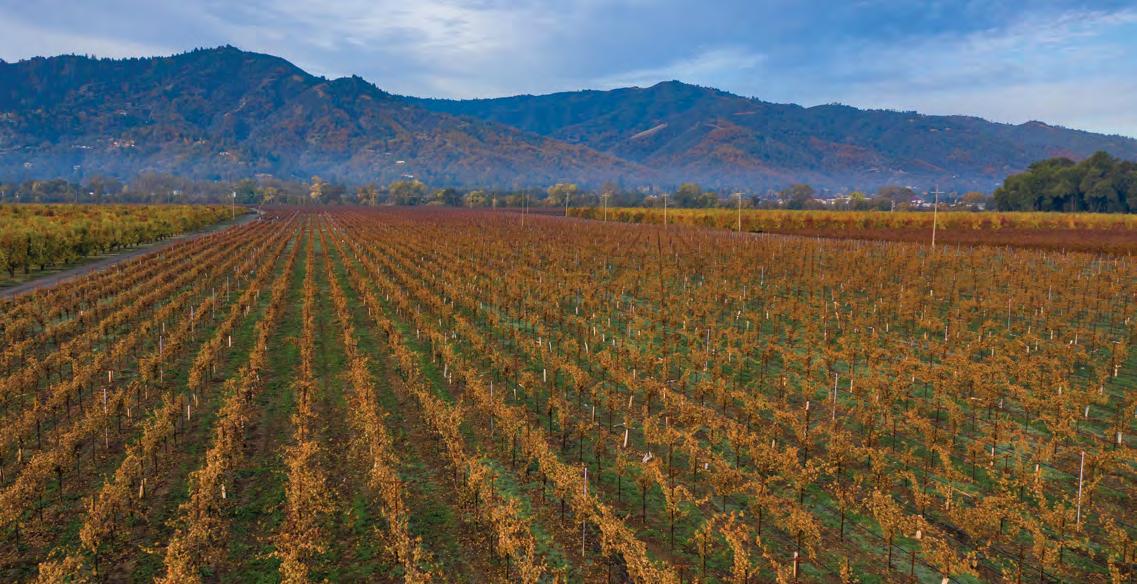
BY FRAN MILLER | PHOTO COURTESY OF BECKSTOFFER VINEYARDS
Each year, as the late-summer light slants across Napa Valley’s storied rows, a vintner’s thoughts turn to harvest. For Beckstoffer Vineyards—a name synonymous with some of California’s most prized vineyard sites—harvest is not simply a season. It’s the culmination of planning, precision, patience, and a union of agricultural intuition and data-driven discipline. Most of all, it’s a commitment to letting the land lead.
Founded in 1970 by Andy Beckstoffer, the company helped shift Napa Valley from blended wines to vineyard-designate excellence. Today, Beckstoffer Vineyards farms 4,000 acres across Napa, Mendocino, and Lake counties, including six heritage sites in Oakville, Rutherford, and St. Helena. The name has become shorthand for exceptional fruit that winemakers seek for its quality, character, and consistency.
In the early 2000s, Andy turned his eye to Lake County’s Red Hills and saw what others didn’t: the potential for serious, sitedriven Cabernet. His instincts proved prescient—Beckstoffer’s vineyard in Red Hills is now a regional benchmark. Years earlier, he recognized promise in Mendocino County, where cooler climates and welldrained soils proved ideal for Chardonnay with structure and freshness.
“We work hard to ensure our clients’ expectations mesh well with our philosophy.”
–Dave Michul
During harvest, the Beckstoffer sensibility becomes especially clear. While many focus solely on brix readings, the team analyzes sugar accumulation curves, microclimate shifts, and berry integrity. The goal: deliver fruit at its peak—not a day too early or too late.
“We know our vineyards and how to manage them to get the best quality out of every season,” says Dave Michul, Beckstoffer’s President of Farming Operations for the past 28 years.
That balance of experience and adaptability defines the company’s approach.
“I’d like to think our management sets us apart, but I’m not that full of myself,” Dave adds. “That being said, I do think we do a remarkable job managing our properties. Some—most notably, our six heritage ranches—are regarded as among the best locations in the world. That makes managing them more challenging, but also more rewarding.”
Technology supports the work, but so does a deep-rooted sustainability ethos. Beckstoffer Vineyards adheres to strict conservation practices, allowing vines to remain productive for decades—far longer than in conventional farming. It’s a quiet testament to long-term stewardship. Additionally, by placing nearly 500 acres of vineyard land into conservation easements that permanently prohibit nonagricultural development, Andy ensures the land remains agricultural—where development pressures might otherwise intrude.
Beckstoffer’s choice to farm rather than vinify has created a collaborative, businessto-business ecosystem.
“Everyone has a different agenda,” says Dave. “We work hard to ensure our clients’ expectations mesh well with our philosophy.”
That mutual respect has fostered lasting relationships—and some of the most respected wines in the country.
In a region where land is legacy and timing is gospel, Beckstoffer Vineyards is a touchstone. Harvest here is more than a race against ripeness—it’s an ongoing dialogue between grower, grape, and ground. A dialogue in which Andy and his team are more than fluent.
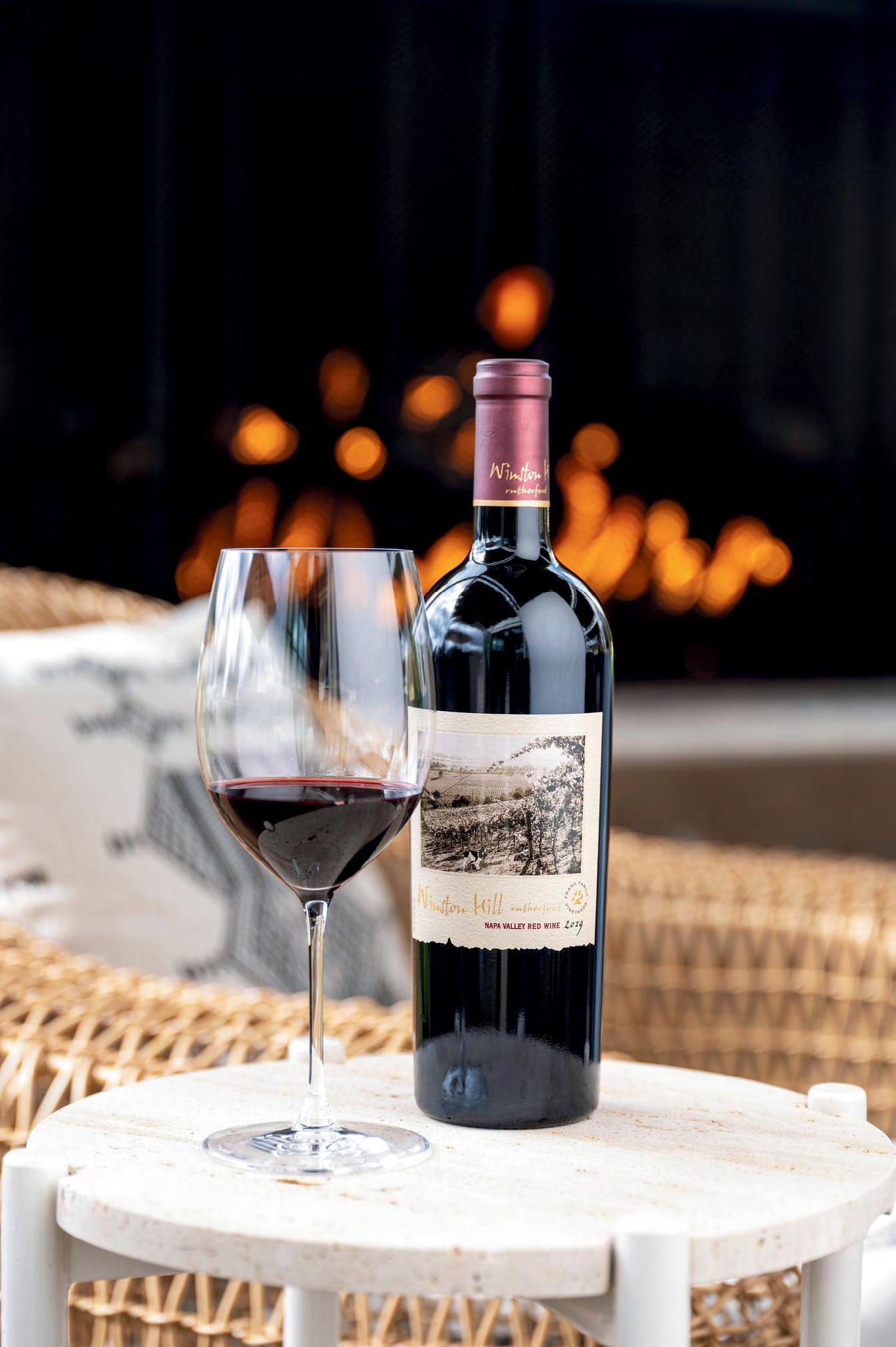



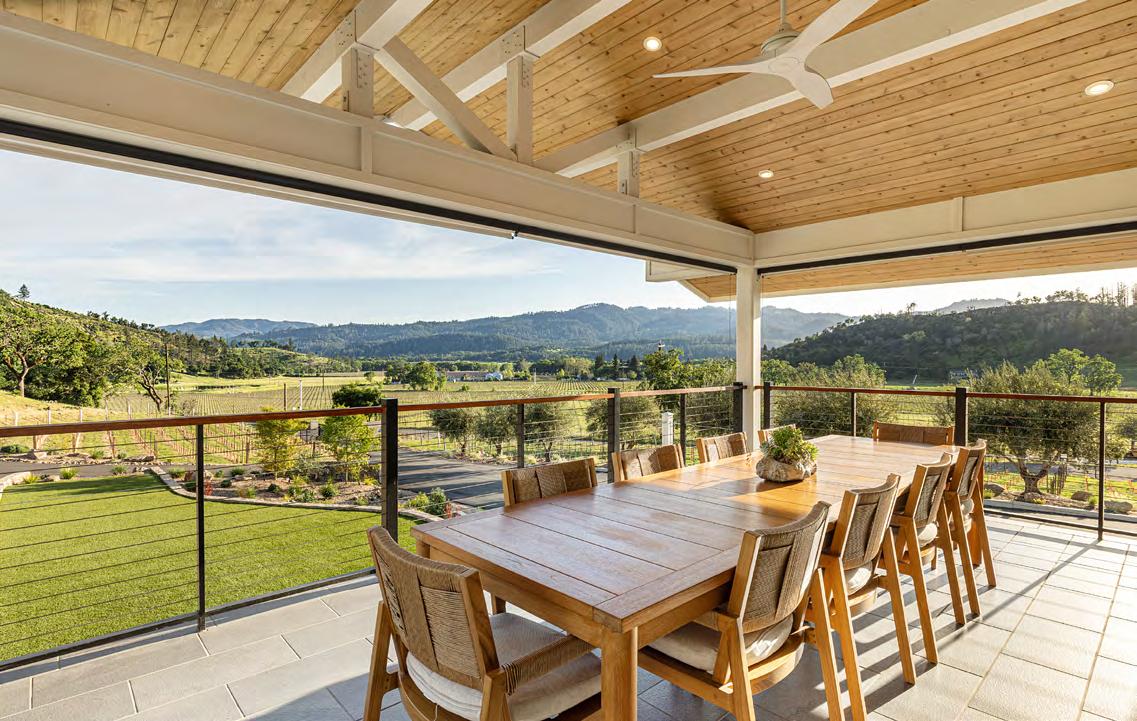
BY SUSAN L. RICHARDS | PHOTOS COURTESY OF REVERIE WINERY ESTATE
Napa Valley provides a bounty of wine tasting opportunities, but few offer the unique and intimate experience of the Reverie Winery Estate. Nestled at the western base of Howell Mountain, where Calistoga meets St. Helena, the newly renovated winery provides gorgeous vineyard views and the opportunity to taste small-production, single-vineyard wines.
Grant and Megan Long have owned Reverie Wines for over a decade, and they and their team have updated all aspects of the winery to modernize the winemaking process and create an exceptional visitor experience. At Reverie, the winemaking is dedicated to producing wines that reflect the terroir of the vineyard sites from which they come. Grant explains, “Our vineyards produce grapes that reflect the individual and unique aspects of each plot’s soils.”
Best known for its focus on singlevineyard growing sites, Reverie produces Bordeaux-style red wines from Cabernet Franc, Cabernet Sauvignon, and Merlot. Grapes are sourced from renowned vineyards, including Napa Valley’s Diamond Mountain and Atlas Peak. Additionally, they

produce wines from a handful of unique grapes rarely seen in Napa Valley, including Barbera, Tempranillo, and Grenache Blanc. Reverie wines are only available onsite, and visiting this small family winery surrounded by beautiful views and vineyards is the only way to experience them. The vision at Reverie Winery is to model the Napa Valley of the 1970s and ’80s, when tasting happened in the living room or at the winemaker’s kitchen table. It is about building a relationship with the customer and providing an experience that matches the quality of their wines.
Reverie specializes in small group tastings and curates each experience to meet the guests’ specific interests. During a visit to Reverie, guests are treated to a property tour followed by an informative yet relaxed tasting with time to enjoy and learn about each wine. Larger groups are welcome with advanced planning to create the best experience.
Those who appreciate the rarity and craftsmanship of Reverie’s exceptional wines can join the family of Reverie’s loyal supporters nationwide, who receive shipments of wine twice a year and are welcomed back for regular visits. The Estate allocation is focused exclusively on Napa Valley single-vineyard Bordeauxstyle wines: Cabernet Franc, Cabernet Sauvignon, and Special Reserve Cabernet Sauvignon. The Estate selection highlights Napa Valley vineyards’ bold structure and refined complexity.
To book a private tasting, visit the winery website.
FOR MORE INFORMATION www.ReverieWinery.com

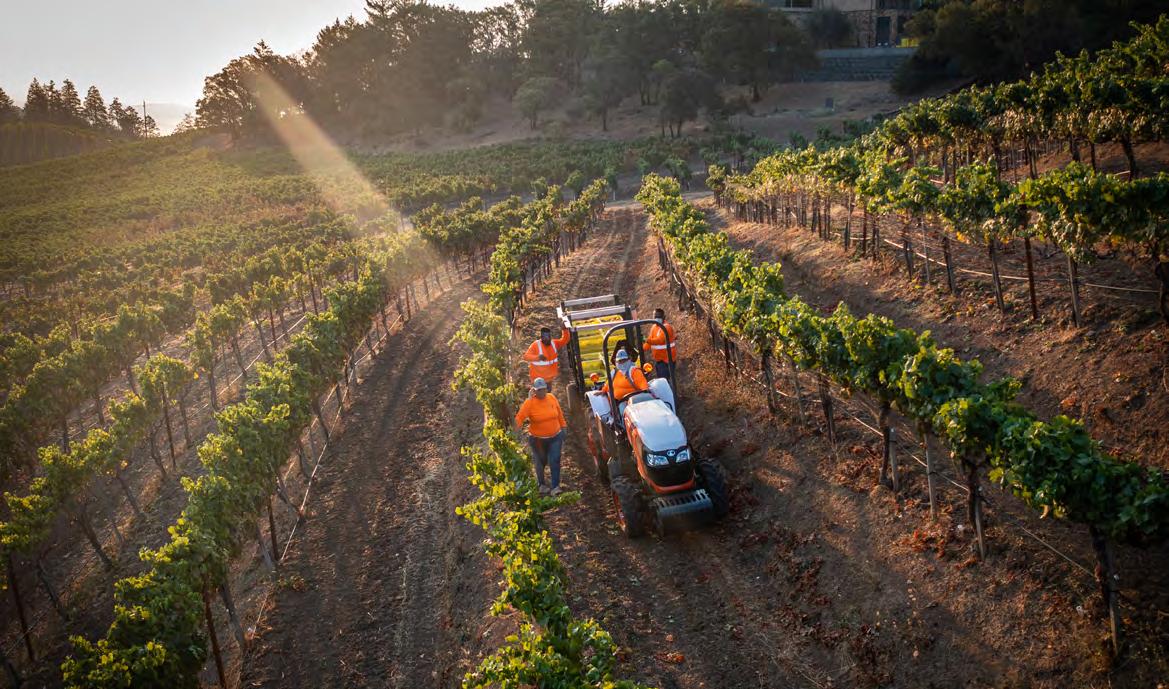

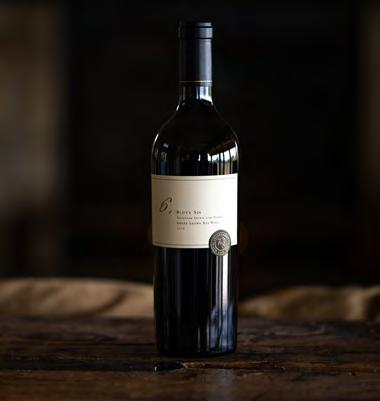
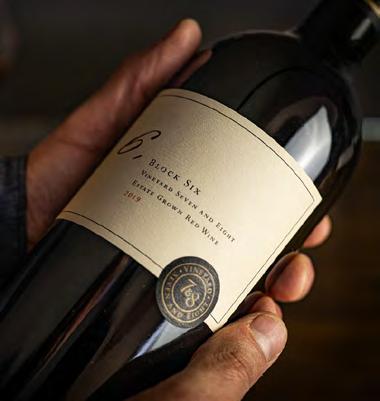

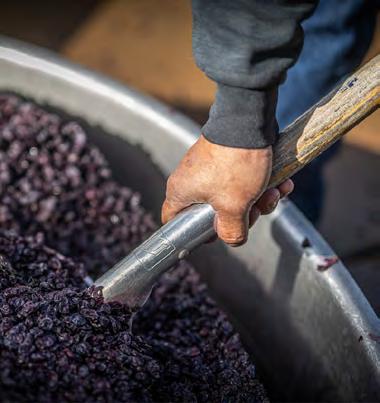
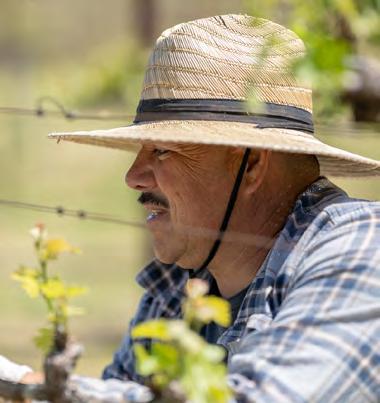
St. Supéry’s limited-time tours and tastings give visitors an inside look at their busiest season.
BY JILLIAN DARA | PHOTO COURTESY OF ST. SUPÉRY
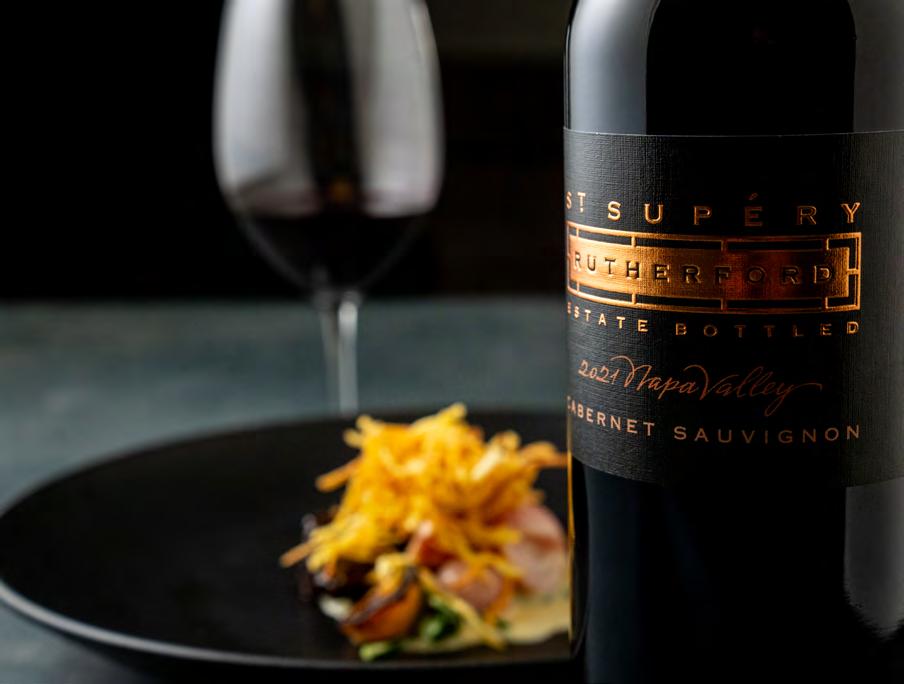
Afall visit to Napa Valley likely means overlapping with harvest season.
At Rutherford’s St. Supéry Estate Vineyards & Winery, they embrace the season with a seasonal tour and tasting that highlights their favorite time of year.
The Harvest LIVE! Tour and Tasting ($87) is a communal experience that begins at 10:15am. Guests are led through the vineyard and winery while learning about the picking process, fruit sorting, crushing, pressing, native yeasts, and fermentation. It is as interactive as it is educational and certainly provides a peek into a day in the life of a vintner, which hopefully translates to further appreciation upon the tasting of four wines following a tour of the estate vineyards to view the progression of the grape ripening, watch the sorting table in action, or smell (and maybe even taste) fermenting Sauvignon Blanc juice from a tank. Expect to spend up to two hours enjoying this harvest-season-only tour and tasting.
The Harvest LIVE! experience only runs through mid-November, or when all the fruit is picked, sorted, and punched down. However, for guests unable to make the autumn happenings, St. Supéry adds another special behind-the-scenes opportunity for their winter lineup.
The Cellar Tour and Tasting Experience ($87) also starts at 10:15am, leading guests through a custom cellar tour, seated tasting of three estate wines, and a rotating special
fourth wine selection. This two-hour experience focuses on the daily decision process of St. Supéry’s winemaking team, from fermentation to aging duration for each harvest block, so that no two tours are ever the same.
“Enjoyment of wine and education in a fun and inviting way is a hallmark of our hospitality. Harvest is so exciting, and happens just once a year. We love to welcome our wine club members and new fans each fall. It’s our opportunity to show the best of what we do and hopefully create fans for life,” stated Jamie Jamison, Director of Hospitality.
Rutherford Estate Vineyard Sauvignon Blanc among white wines.
“Our winemakers love a palate of blocks to work with each vintage. Their ability to create limited-edition wines that are offered to our wine club members and winery visitors exclusively is a real treat. These wines show the depth of our three estate vineyards and how the winemakers choose between blocks, fermentation methods, and aging,” noted Jamison.
St. Supéry says these wines are perfect for fall flavors, especially the Dollarhide Elevation Cabernet Sauvignon, which complements a number of savory and umami
“Harvest is so exciting, and happens just once a year. We love to welcome our wine club members and new fans each fall. It’s our opportunity to show the best of what we do and hopefully create fans for life.” –Jamie Jamison
The winery also embraces this time of year with exclusive fall-featured wines, which will only be available to taste at the winery: 2019 Dollarhide Estate Vineyard Malbec and Elevation Cabernet Sauvignon for reds, and 2022 Dollarhide Estate Vineyard Semillon and their 2024
There’s no more time of tractors rolls through harvest isn’t
For guests who harvest tastings offer a rare fermentation tanks bubbling It’s interactive, immersive,
spices and flavors. In particular, they recommend their recipe for Koji Roasted Carrots (creamy, tangy, and slightly sweet) or a hearty fall Rib Eye with Hen of the Wood Mushrooms (rich and savory).
Harvest is fleeting, but in the fall, there’s
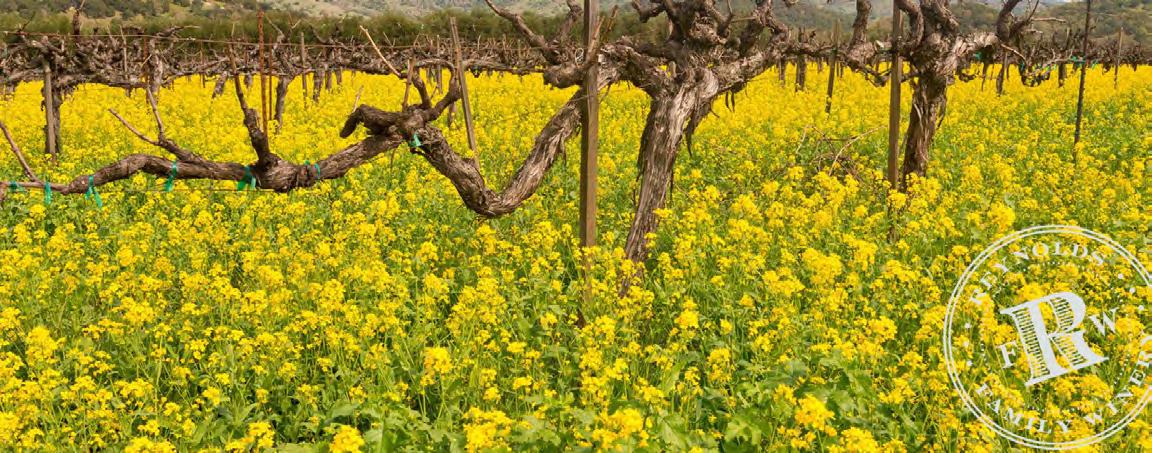
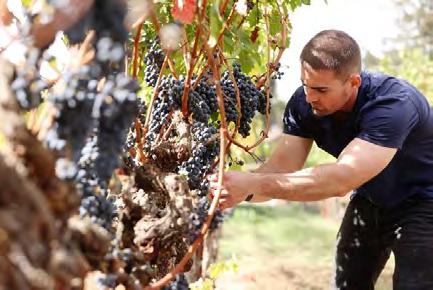

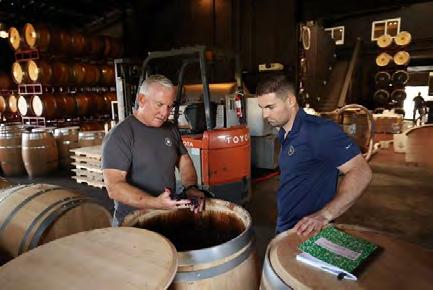


There’s no more time alive in Napa Valley than harvest. The air is filled with the scent of ripe grapes, the hum of tractors rolls through the vineyards, and every winery is buzzing with anticipation. At Reynolds Family Winery, harvest isn’t just our favorite part of the year — it’s the heartbeat of everything we do.
There’s no more time alive in Napa Valley than harvest. The air is filled with the scent of ripe grapes, the hum of tractors rolls through the vineyards, and every winery is buzzing with anticipation. At Reynolds Family Winery, harvest isn’t just our favorite part of the year — it’s the heartbeat of everything we do.
There’s no more time alive in Napa Valley than harvest. The air is filled with the scent of ripe grapes, of tractors rolls through the vineyards, and every winery is buzzing with anticipation. At Reynolds Family harvest isn’t just our favorite part of the year — it’s the heartbeat of everything we do.
There’s no more time alive in Napa Valley than harvest. The air is filled with the scent of ripe grapes, the hum of tractors rolls through the vineyards, and every winery is buzzing with anticipation. At Reynolds Family Winery, harvest isn’t just our favorite part of the year — it’s the heartbeat of everything we do.
There’s no more time alive in Napa Valley than harvest. The air is filled with the scent of ripe grapes, the hum of tractors rolls through the vineyards, and every winery is buzzing with anticipation. At Reynolds Family Winery, harvest isn’t just our favorite part of the year — it’s the heartbeat of everything we do.
alive in Napa Valley than harvest. The air is filled with the scent of ripe grapes, the hum the vineyards, and every winery is buzzing with anticipation. At Reynolds Family Winery, isn’t just our favorite part of the year — it’s the heartbeat of everything we do.
For guests who visit during this season, it’s an experience unlike any other. Our behind-the-scenes harvest tastings offer a rare glimpse into the real work of winemaking. You might witness punchdowns in progress, fermentation tanks bubbling to life, or the moment freshly picked clusters arrive straight from the vineyard. It’s interactive, immersive, and as close to the craft as you can get without picking up a pair of shears.
visit during this season, it’s an experience unlike any other. Our behind-the-scenes rare glimpse into the
For guests who visit during this season, it’s an experience unlike any other. Our behind-the-scenes harvest tastings offer a rare glimpse into the real work of winemaking. You might witness punchdowns in progress, fermentation tanks bubbling to life, or the moment freshly picked clusters arrive straight from the vineyard. It’s interactive, immersive, and as close to the craft as you can get without picking up a pair of shears.
For guests who visit during this season, it’s an experience unlike any other. Our behind-the-scenes harvest tastings offer a rare glimpse into the real work of winemaking. You might witness punchdowns fermentation tanks bubbling to life, or the moment freshly picked clusters arrive straight from the vineyard. It’s interactive, immersive, and as close to the craft as you can get without picking up a pair of shears.
For guests who visit during this season, it’s an experience unlike any other. Our behind-the-scenes harvest tastings offer a rare glimpse into the real work of winemaking. You might witness punchdowns in progress, fermentation tanks bubbling to life, or the moment freshly picked clusters arrive straight from the vineyard. It’s interactive, immersive, and as close to the craft as you can get without picking up a pair of shears.
Harvest is fleeting, but its magic lasts all year in every wine we produce. If you’ve never experienced Napa in the fall, there’s no better time — or place — than right here at Reynolds Family Winery.
For guests who visit during this season, it’s an experience unlike any other. Our behind-the-scenes harvest tastings offer a rare glimpse into the real work of winemaking. You might witness punchdowns in progress, fermentation tanks bubbling to life, or the moment freshly picked clusters arrive straight from the vineyard. It’s interactive, immersive, and as close to the craft as you can get without picking up a pair of shears. Harvest is fleeting, but its magic lasts all year in every wine we produce. If you’ve never experienced Napa in the fall, there’s no better time — or place — than right here at Reynolds Family Winery.
Harvest is fleeting, but its magic lasts all year in every wine we produce. If you’ve never experienced in the fall, there’s no better time — or place — than right here at Reynolds Family Winery.
Harvest is fleeting, but its magic lasts all year in every wine we produce. If you’ve never experienced Napa in the fall, there’s no better time — or place — than right here at Reynolds Family Winery.
but its magic lasts all year in every wine we
Harvest is fleeting, but its magic lasts all year in every wine we produce. If you’ve never experienced Napa in the fall, there’s no better time — or place — than right here at Reynolds Family Winery.
If you’ve never experienced Napa there’s no better time — or place — than right here at Reynolds Family Winery.





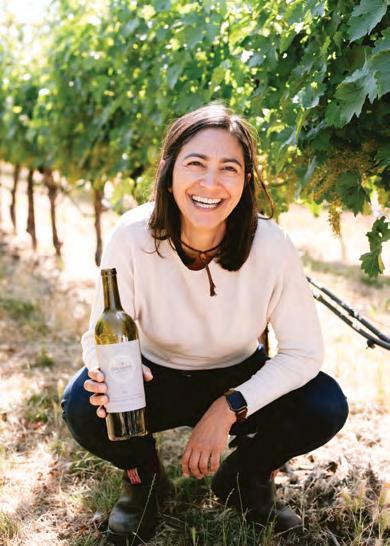
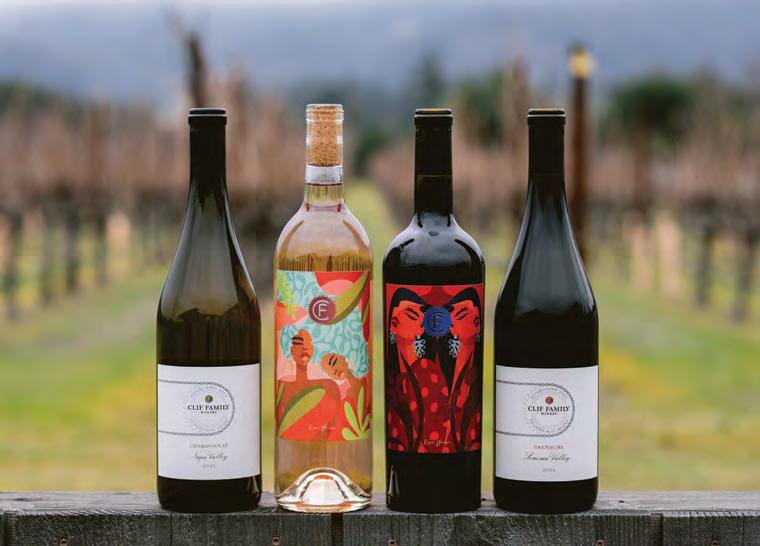
BY FRAN MILLER | PHOTOS COURTESY OF CLIF FAMILY WINERY & FARM
At Clif Family Winery & Farm, sustainability isn’t a side project or a marketing angle—it’s the foundation. Long before buzzwords became industry staples, this St. Helena-based winery was quietly cultivating a different kind of legacy—one rooted in stewardship, innovation, and the belief that great wine begins with respect for the land.
It’s easy to toss around terms like “green,” “organic,” and “sustainable.” Much harder is walking the walk—or in this case, farming the farm. Clif Family’s estate vineyards are CCOF-certified organic, meaning no synthetic pesticides, no chemical fertilizers—just living, breathing ecosystems designed to support not only grapevines but also bees, birds, and the soil itself.
The team employs regenerative practices that go a step further, including pollinator habitats, cover cropping, and composting programs that enrich the land while reducing waste. A reflection of these efforts is Clif Family’s status as a Certified B Corporation—one of only four in Napa Valley. This designation recognizes companies that meet rigorous standards for social and environmental performance, accountability, and transparency.
“Sustainability isn’t a trend for us—it’s the way we’ve always done business,” says Linzi Gay, President of Clif Family. “It shapes every decision we make, from how we farm to how we package. We believe great wine starts with respect for the land, and in a place like Napa, we have a responsibility to lead by example and prove that quality and environmental stewardship can go hand in hand.”
As a Napa Green Certified Vineyard, Clif Family doesn’t just follow environmental guidelines—they help set them. Energy efficiency, water conservation, and climatesmart farming practices aren’t afterthoughts—they’re embedded in every aspect of production.
The winery’s water-smart approach includes precise drip irrigation, soil moisture sensors, and planting methods that conserve every drop while boosting longterm soil health.
Even the bottles tell a story. The winery uses lighter-weight glass for all its wines—a small shift with a big impact on carbon emissions. For local wholesale partners, they go a step further by offering reusable stainless-steel
kegs. Labels and shipping materials include post-consumer recycled content. Inks are non-toxic. Reusable shipping options are also currently being explored.
Perhaps most impressive is the winery’s commitment to transparency. Clif Family accounts for packaging in its Scope 3 emissions—those indirect, supply-chainrelated emissions many companies prefer to sidestep. That data drives real targets and measurable actions.
There’s a refreshing humility in Clif Family’s sustainability mission. They’re not claiming perfection—they’re modeling progress. Their efforts serve as a reminder that responsible farming and mindful business practices can (and should) coexist with top-tier winemaking.
And in a region as influential as Napa, that kind of leadership has the power to ripple far beyond their own estate.
In the glass, you’ll taste the terroir. But behind the bottle lies something even more lasting: a deep-rooted respect for land, legacy, and the generations yet to come.

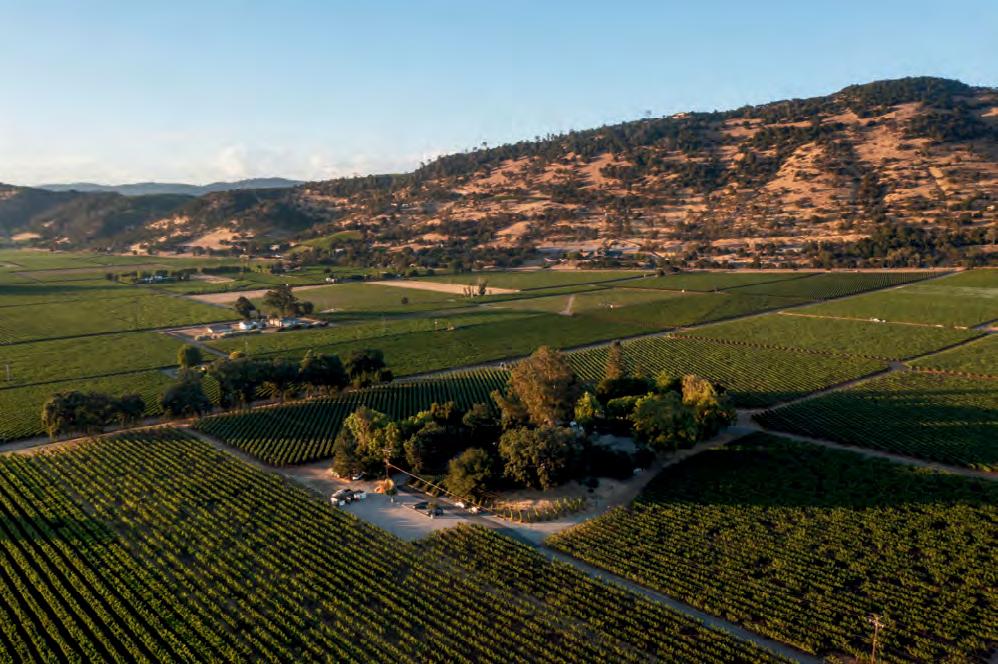
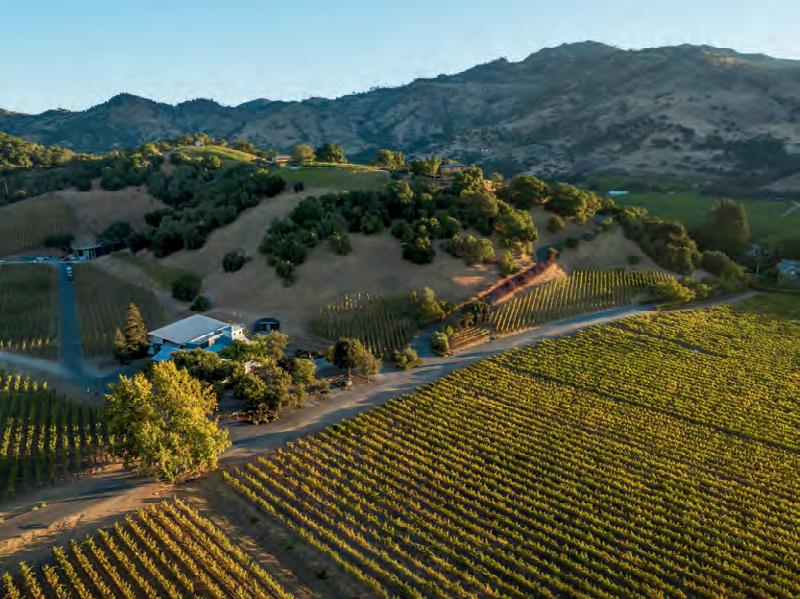





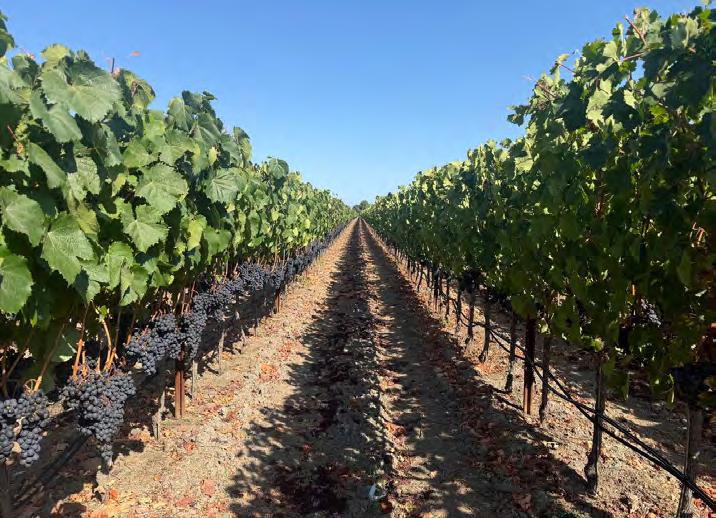
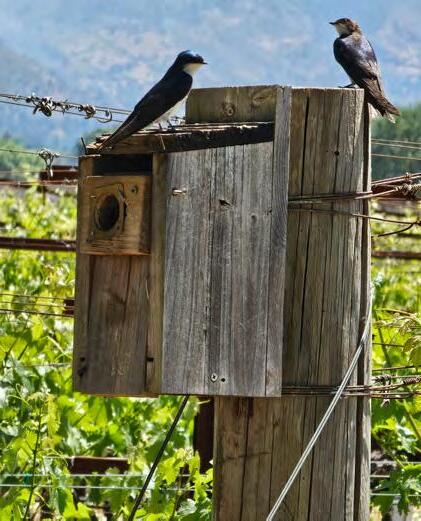
BY FRAN MILLER | PHOTOS COURTESY OF FORTUNATI VINEYARDS
The name Fortunati carries a sense of serendipity. Derived from the Italian word for “fortunate,” it reflects not only the personal story of Gary and Ellen Luchtel but also the philosophy behind their wines. What began as a hobby has grown into a small but ambitious estate in Napa Valley’s Oak Knoll District, where sustainability is woven into every aspect of life among the vines.
Gary, known by his nickname “Lucky,” and Ellen, whose Italian and German heritage infuses the brand’s identity, left San Francisco to pursue the craft of winemaking full time. Since establishing their vineyard in 2003, the couple has carved out a reputation for their limitedproduction wines, shipped directly to clients across the country. Their unusually diverse portfolio makes their subscription program very popular. It includes Syrah, Malbec, Cabernet Franc, Bordeaux blend, Viognier, Rosé, Cabernet Sauvignon, Reserve Cabernet Sauvignon, and sourced varietals like Zinfandel from Rockpile AVA, Chardonnay (and a new Reserve Chardonnay) from Oak Knoll District AVA, and Pinot Noir from Santa Rita Hills (and a new Reserve Pinot Noir). Occasionally, they also produce a portstyle dessert wine.

For the Luchtels, the story of Fortunati is as much about stewardship as it is about wine. Living on the property, they view the land not as a resource to be used but as a partner to be respected. Their vineyard practices are measured, thoughtful, and designed to ensure that the soil, vines, and ecosystem thrive for generations to come. Solar panels provide nearly all of the property’s electrical needs. Vineyard management is left in part to nature: western bluebirds, California quail, bats, and barn owls serve as guardians, keeping vineyard pests in check. Bird and owl boxes dot the property.
After harvest, the land is further replenished with cover crops of peas, legumes, and clover. These plantings act as natural fertilizers, enriching the soil with nutrients while
protecting against erosion. In spring, the vines awaken into healthier, more vibrant growth thanks to this cycle of renewal. The Luchtels prefer a hands-off approach, allowing the vines to express the unique character of the Oak Knoll District while preserving balance in the environment. Even the tools of daily farming reflect this ethic: electric-powered carts reduce emissions and noise, a small but meaningful adjustment in keeping with Fortunati’s philosophy.
Ellen often describes the winery as “tiny,” yet its impact on both the land and its devoted wine club is significant. Production typically ranges between 100 and 350 cases per varietal, a scale that allows Gary to personally walk the rows, observe each vine, and tailor his winemaking to the subtleties of each vintage. Ellen, in turn, brings her energy to the winery’s community of customers, ensuring that Fortunati’s wines remain not only carefully crafted but also personally shared.
For the Luchtels, good fortune is not simply in the name. It is in the opportunity to care for their land, create wines of integrity, and sustain the environment that makes it all possible.

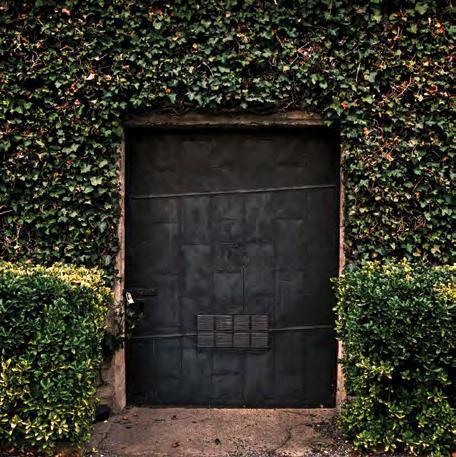
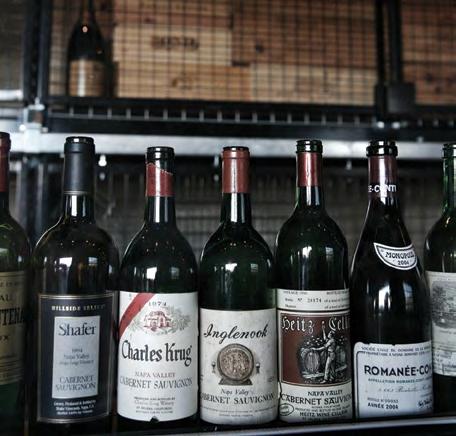
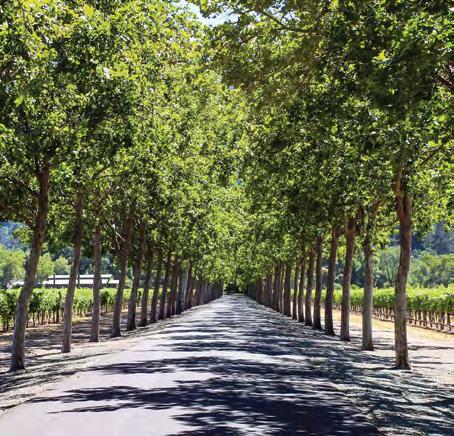
Discover the finest and most unique wine storage facility serving Napa, Sonoma, and the greater San Francisco Bay Area. Rutherford Wine Vault is located in the historic Beaulieu Vineyard champagne department - a meticulously transformed 110 year-old space. The vault features storage solutions for individual wine collectors and small vintners. Each locker is equipped with custom designed seismically independent racking systems, lockable private steel storage enclosures, redundant temperature and humidity controls, and more than five layers of state-of-the-art security systems.
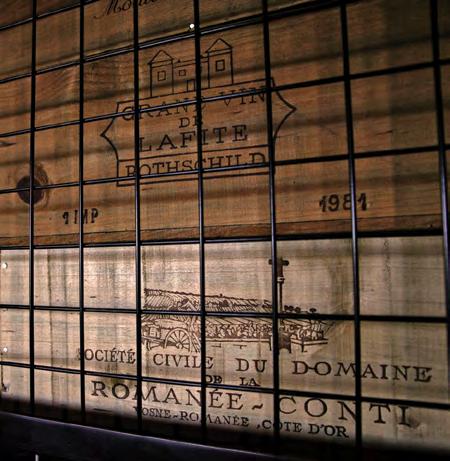
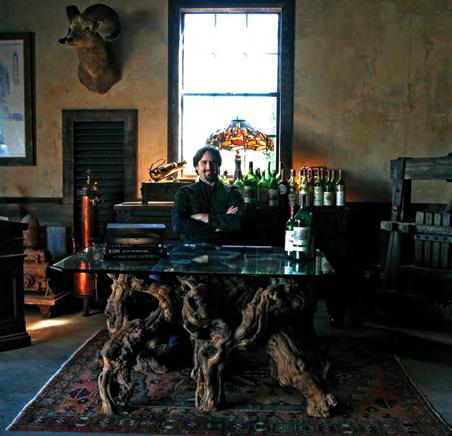

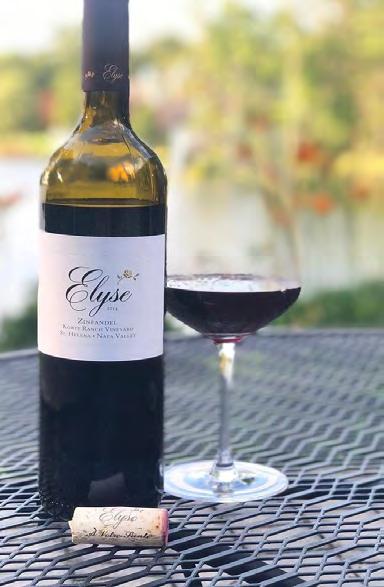
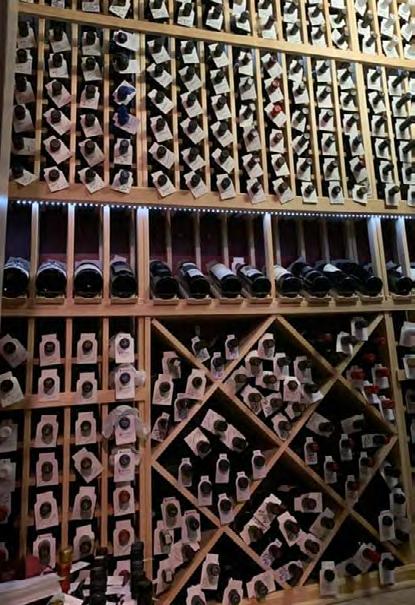
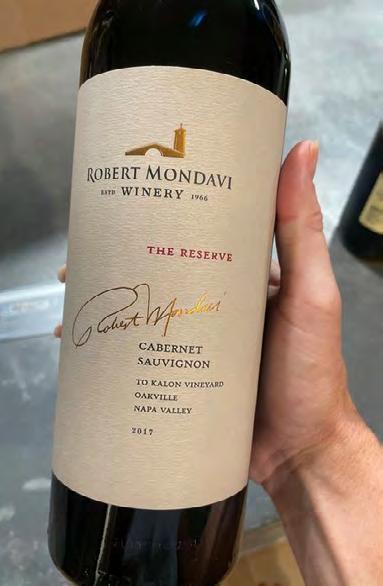
BY FRAN MILLER | PHOTOS COURTESY OF WINE SPIES
or nearly two decades, Wine Spies has operated in the shadows. Not with trench coats and code names (well, maybe a few), but as discreet allies to boutique wineries and collectors. Each day, these self-proclaimed “agents” uncover a single wine worth investigating—then dispatch it to their loyal network of operatives (also known as customers) at a price that would make any bargain-hunter raise an eyebrow. And in a moment of disruption across the wine industry, their mission has only grown more urgent.
“The wine industry is facing some tough headwinds,” says CMO Mike Meisner (aka Agent Rhone ). “But that could actually be good news for consumers—and for the brands.”
Between shifting economic conditions, tightening wallets, and a few high-profile bankruptcies, even top wineries are facing backstock and cash flow challenges. Wine Spies offers a stealthy solution—one that doesn’t require blowing a brand’s cover.
“There’s a common perception among brands that if we sell their wine at a discounted price, we’re eroding their brand
value,” says Rhone. “But I think it often works out in the opposite way.”
According to company intel, Wine Spies’ core buyers aren’t deal-chasers with burner phones—they’re seasoned collectors with cellars full of classified files.
“The same people in our Facebook group who buy these wines have massive collections,” says Rhone. “They spend hundreds on bottles and have no problem paying full price. If anything, our platform should be viewed as a marketing channel. Brands get instant exposure to tens of thousands of potential buyers. These are the same people who visit wine country, join wine clubs, and go on to buy direct from these producers if they like the wine. Getting that initial taste is often the push they need to seek out more—either direct or through other distribution channels.”
Call it a soft launch with high-value targets. Boutique producers can move inventory quickly and discreetly, gaining access to a highly engaged consumer base that often ends up planning winery visits based on what they discover through a Wine Spies drop.
And the daily format keeps things exciting. Each offer is live for just 24 hours, with no subscriptions, no fine print, and no unnecessary middlemen. Wine Spies agents vet every wine, tasting hundreds of samples each month to ensure only quality selections make the cut.
Launched in 2007—long before most wineries had even considered selling online—Wine Spies is the oldest online wine retailer in the country. Yet despite its longevity, the company still operates with the energy (and irreverence) of a brand that knows how to have a little fun with a serious product.
As traditional channels tighten and consumers grow more selective, Wine Spies offers a rare blend of value, access, and integrity. This covert operation is giving producers a smarter way to stay visible—and wine lovers a compelling reason to check their inboxes every morning.
It’s a model that rewards both sides. And in today’s market, that kind of win-win is worth decoding.
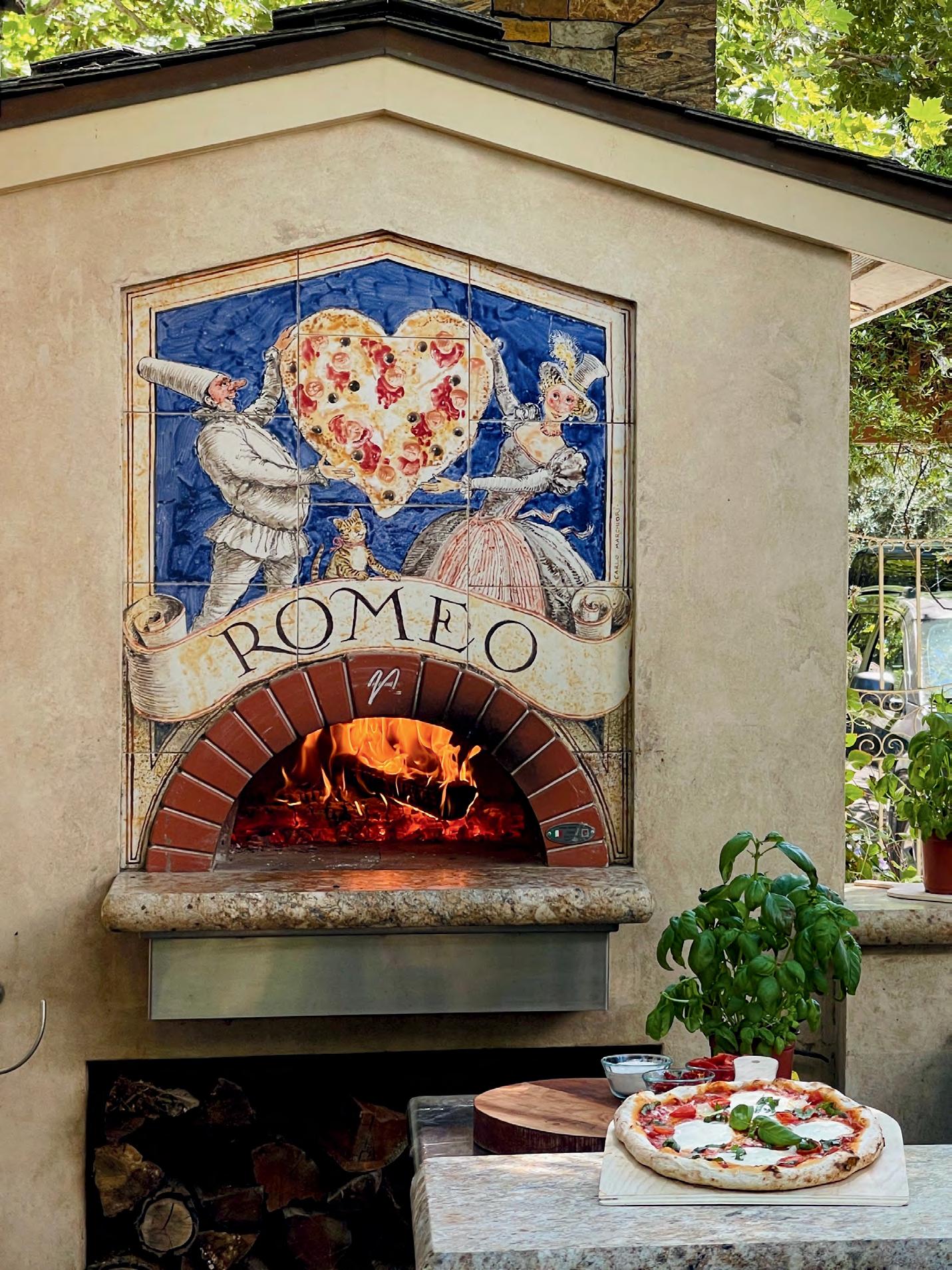
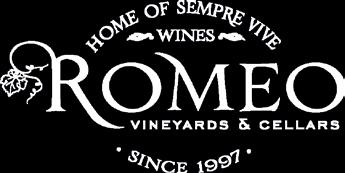
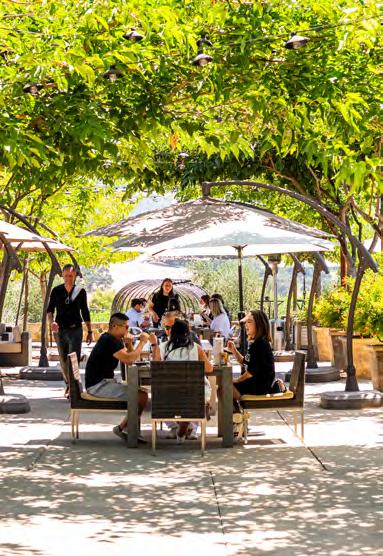
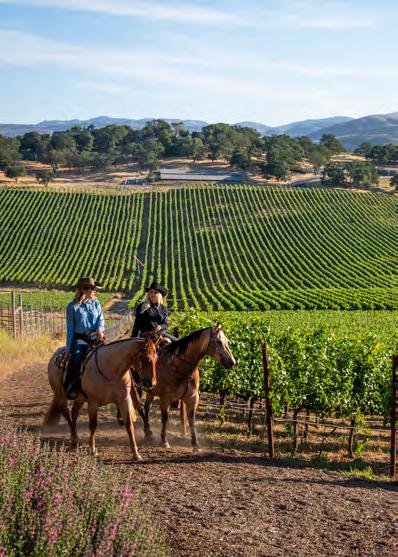
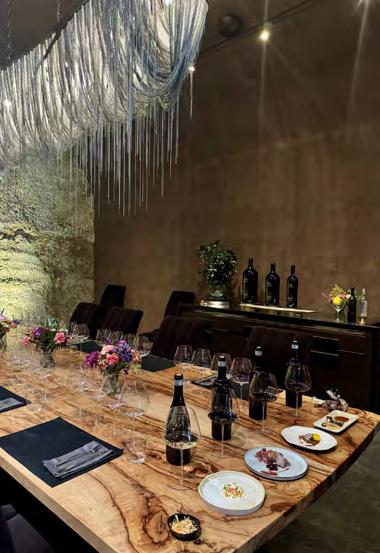
n Napa wine country, where the views are iconic and the vintages rare, Shadybrook Estate Winery manages to surprise. Located just ten minutes from downtown Napa, this refined, family-owned estate in the Coombsville AVA offers tasting experiences that are personal, immersive, and undeniably transportive.
At the heart of it all is the winery’s Overlook Experience, set on a sunlit rise above the vineyards, with sweeping vistas of the rolling Coombsville hills. Guests are welcomed into a private cabana, where five small-production wines—primarily estategrown Bordeaux varietals—are poured alongside a curated selection of cheeses, charcuterie, and seasonal accompaniments. The pairings are thoughtful, the pace is leisurely, and the ambiance is quietly luxurious. It’s the kind of setting that encourages guests to slow down and savor both the wines and the view.
The Overlook, however, is just one of several experiences that make Shadybrook unique. For those curious to go deeper, the estate features its Cave Series Experience, a
BY FRAN MILLER | PHOTO COURTESY OF SHADYBROOK ESTATE
limited offering centered around the launch of their new Cave Series wines. Hidden in the hillside behind The Overlook, the 16,000-square-foot cave is both a working barrel room and an atmospheric tasting venue. Led by a dedicated ambassador, guests begin with a barrel sampling of future vintages before moving into a private tasting space, where a multi-course wine and food pairing awaits, curated in partnership with winemaker Rudy Zuidema and famed Chef Ken Frank of La Toque.
Guests looking for a more casual introduction to Shadybrook’s portfolio may opt for The Perfect Pairing Experience, a hosted tasting of the guest’s selection of Shadybrook Estate or Rapp Ranch wines, served with their seasonal board on the Grand Terrace. It’s ideal for first-time visitors, larger groups, or anyone simply craving a view with their vino.
True to its ranching roots, Shadybrook also offers a handful of outdoor adventures with Napa Valley Trail Rides. The Ultimate Ranch Experience begins with a guided horseback ride through estate vineyards,
followed by a seated tasting on the terrace. For couples, the Ultimate Romance Experience adds an intimate twist—offering the choice of a private firepit or cabana seating after a scenic trail ride, including a curated flight of wines and a sweet local dessert to finish. And for those planning life’s biggest question, the Ultimate Proposal Experience offers an unforgettable setting. A private horseback ride winds toward Proposal Hill, where panoramic views set the stage for the moment itself, captured discreetly by a professional photographer. Afterward, the couple enjoys a celebratory tasting by the firepit, complete with a bottle of Shadybrook Cabernet Sauvignon (signed by the winemaker), two logoed Riedel glasses, and a custom cake for two.
At Shadybrook, wine is just the beginning. Whether you come for the views, the horses, or the perfectly chilled glass of Platine, you’ll find that hospitality here runs deeper than the caves, and lingers long after the last sip.


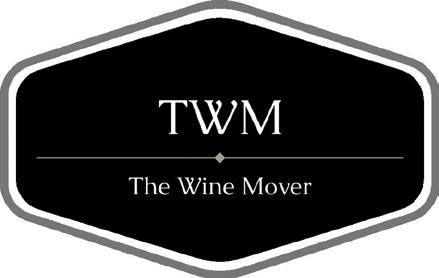
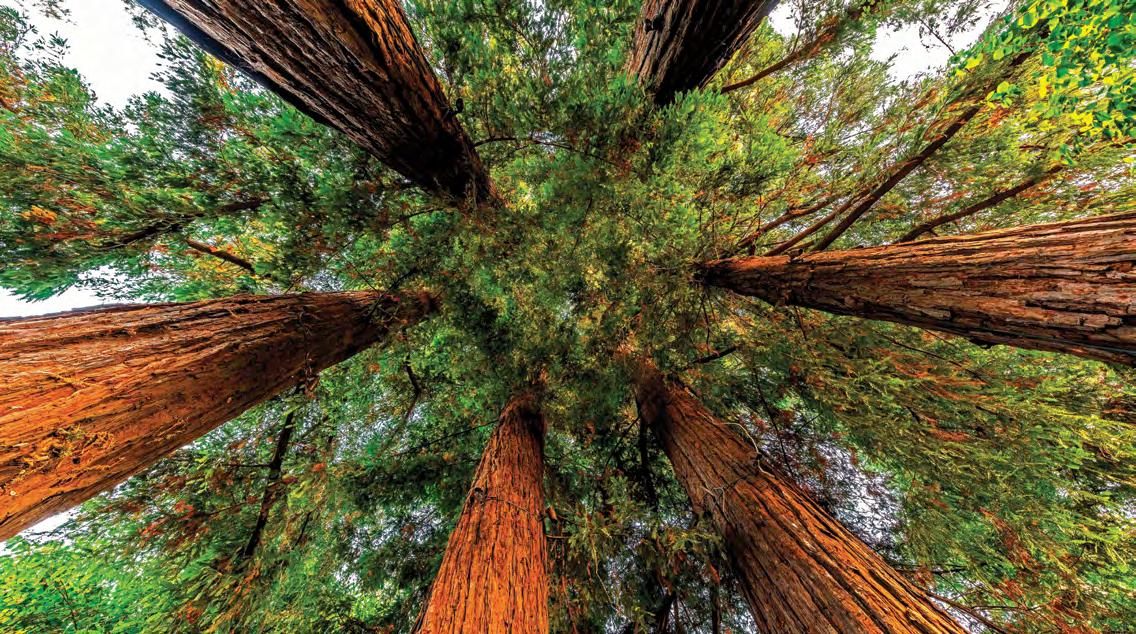
The ancient redwood trees on Sequoia Grove’s Rutherford property aren’t simply the inspiration for the winery’s name—they help shape the winery’s values. With their remarkable strength and longevity, these trees serve as both symbol and guide for Sequoia Grove’s long-term vision: to craft exceptional wines while protecting the land for generations to come.
Here, sustainability isn’t just for show; it’s a deeply held value.
“Sustainability isn’t a trend or a checklist,” says Jonathan Wendorf, Director of Consumer Sales & Marketing. “It’s how we show respect—for the land we steward, the community we’re part of, and every guest who walks through our doors.”
That philosophy runs through every corner of the winery’s operations. Guests may not notice every water sensor or composting system during a visit—but that’s intentional. Sequoia Grove’s commitment to sustainability isn’t flashy. It’s foundational.
The winery is proudly certified under the Napa Green Winery & Land program and was one of the first five wineries to meet its most rigorous, updated standards. This third-party certification evaluates performance across climate action, water efficiency, soil health, and social equity.
In the vineyards, Sequoia Grove lets nature support nature. Soil-specific cover crops
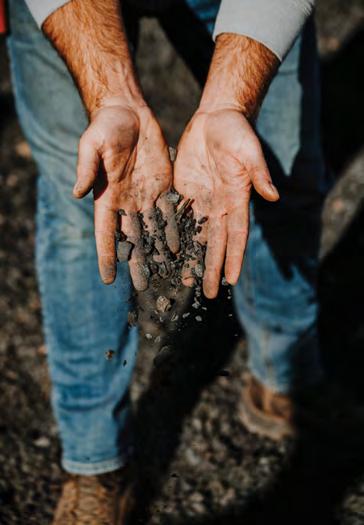
and mulching practices reduce the need for synthetic fertilizers while enhancing biodiversity and carbon sequestration. Precision irrigation conserves water, and integrated pest management replaces chemicals with hand-weeding and natural pest control.
Inside the winery, energy efficiency drives every decision. Lighting and cellar systems are managed with digital controls to minimize usage. The grounds are landscaped with drought-tolerant plants, water usage is monitored monthly, and stormwater is filtered through bioswales. Even packaging reflects the mission—favoring postconsumer materials, curbside-recyclable components, and compostable options.
Through its partnership with Marin Clean Energy’s Deep Green program, the winery now runs on 100% renewable electricity. It is also a Certified Napa Green Business, further underscoring Sequoia Grove’s commitment to reducing its carbon footprint—without compromising wine quality.
Sequoia Grove’s environmental stewardship extends beyond its own property. As a proud member of 1% for the Planet, the winery donates to vetted nonprofits focused on climate and conservation. Among the recipients is the Save the Redwoods League, a century-old organization dedicated to preserving California’s iconic redwood forests—a meaningful partnership for a winery so deeply rooted in these towering symbols of resilience.
Even the shipping process embodies this ethos. All orders ship carbon-neutral, with drain-safe gel packs for temperature control and plantable seed paper liners included in six- and twelve-bottle shipments.
From soil to cellar, from bottle to box, Sequoia Grove is proving that sustainability and luxury winemaking are not at odds—they are inherently intertwined.
“We believe great wine should do more than taste exceptional,” Wendorf says. “It should do good.”
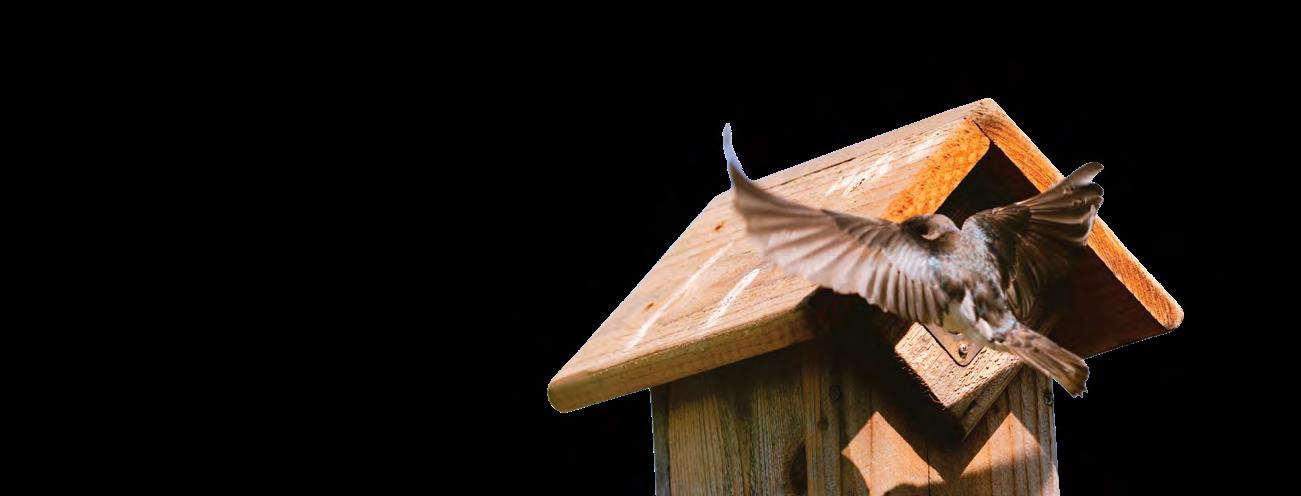
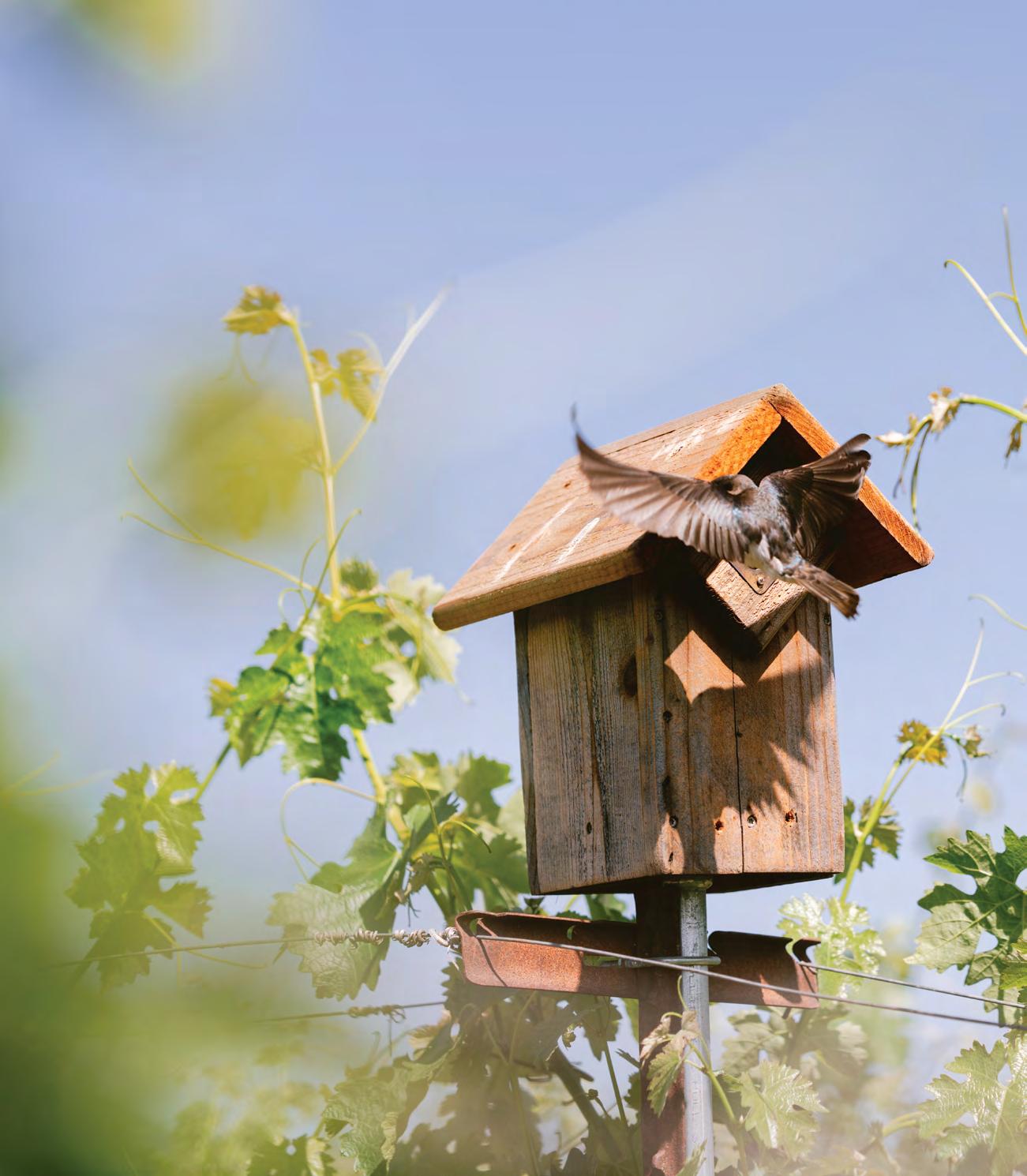
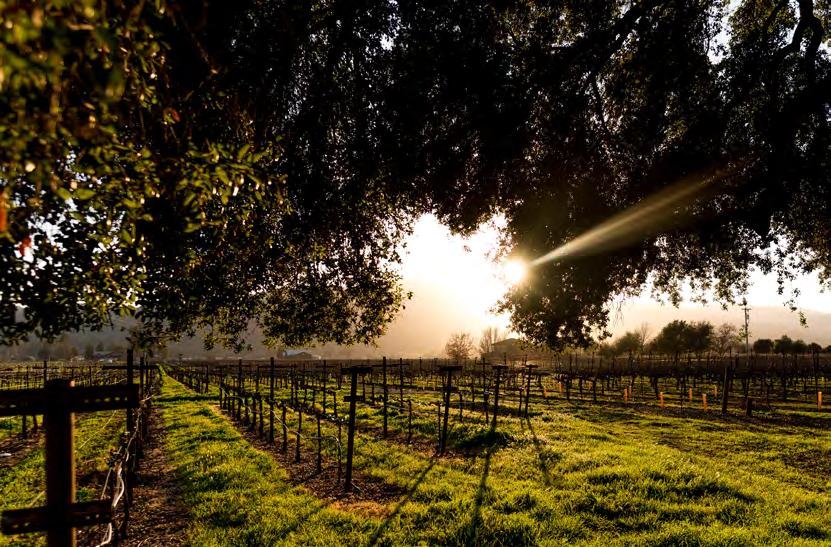
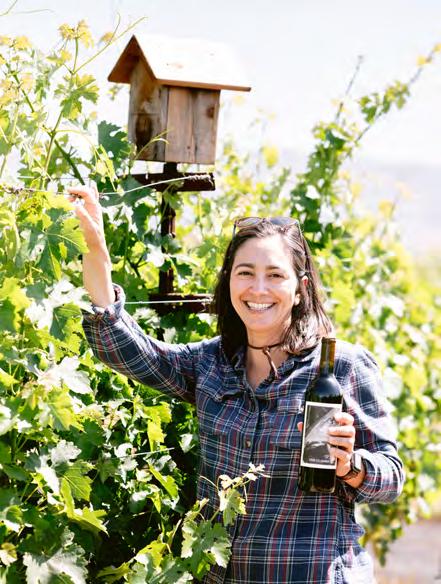
In Napa Valley, sustainability has evolved from a niche aspiration into a central ethos for many winemakers. It’s no longer about checking a box or following a trend. For a growing number of wineries, it’s a guiding principle that shapes every decision—from vineyard practices to packaging choices, and from community engagement to long-term stewardship of the land. It’s about keeping the valley’s beautiful landscape vibrant and productive for generations to come while producing wines that reflect not just terroir, but responsibility.
One illustrative example comes from Clif Family Winery & Farm. Their CCOFcertified organic vineyards avoid synthetic pesticides and fertilizers, focusing instead on living ecosystems that support soil health, bees, and birds. Regenerative practices like pollinator habitats, cover cropping, and composting enrich the land while minimizing waste. Sustainability extends beyond the vineyard: lighterweight glass, non-toxic inks, reusable kegs, and careful consideration of packaging reflect a commitment to reducing carbon emissions. “Sustainability isn’t a department at Clif Family—it’s the backbone of the entire business,” says Linzi Gay, President of Clif Family Winery & Farm. “Every decision, whether it’s how we grow
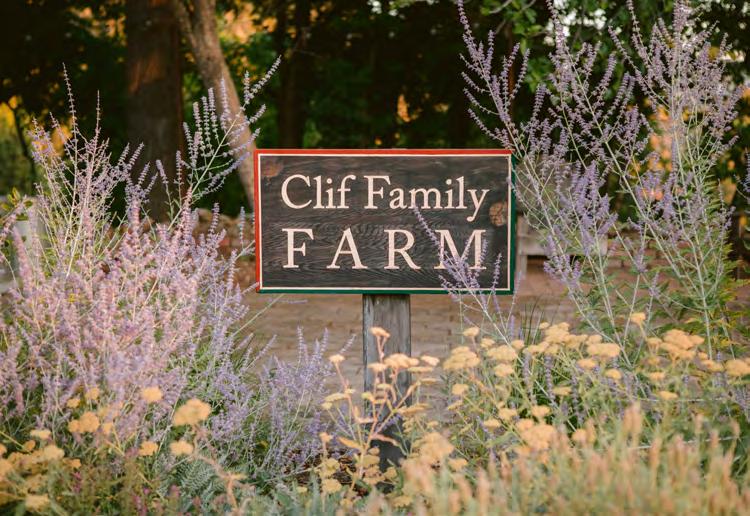
Ask a Napa winemaker to define sustainability, and you’ll hear answers that go beyond environmental protection. The conversation often begins with soil and water, the raw materials of wine, but quickly extends to biodiversity, climate action, energy use, packaging, labor welfare, and community engagement. Here, sustainability is as much about social responsibility as it is about ecological stewardship. In practice, this means thinking in decades, not vintages. A sustainable approach considers the long-term health of the land, the people who work it, and the community it supports. It’s not just avoiding harm, but actively creating conditions where all can thrive.
grapes or how we ship wine, reflects our values. We’re constantly asking: how can we do better for the planet, our community, and future generations? That mindset isn’t just good for the world; it makes us a stronger, more resilient company.”
The vineyard is the heart of any sustainability effort. Napa’s winemakers have increasingly embraced methods like organic and regenerative farming, which focus on building soil health rather than simply treating problems as they arise. Cover crops, from mustard to clover, help prevent erosion, fix nitrogen, and provide habitat for beneficial insects. Integrated Pest
Management (IPM) minimizes chemical use by relying on natural predators and targeted interventions. Many vineyards also maintain buffer zones of native plants to support pollinators and wildlife, a strategy that doubles as a defense against erosion during heavy rains. Drip irrigation systems and moisture sensors reduce water use—an increasingly urgent concern as drought cycles lengthen. On some estates, sheep graze between the vines, reducing the need for mowing and returning nutrients to the soil. These visible measures are just part of a larger system designed to keep the vineyard in balance with the surrounding ecosystem.
Sequoia Grove in Rutherford offers a compelling example of sustainability in action. Here, the presence of ancient redwoods is more than symbolic—it informs the winery’s long-term approach. The winery integrates sustainability throughout every aspect of its operations, from precision irrigation and soil-specific cover crops in the vineyards to energyefficient lighting and cellar systems. Its
reused for irrigation. Some wineries capture and store rainwater for non-potable uses, easing the strain on municipal supplies.
Packaging choices also play a role. Lightweight bottles lower transportation emissions, while alternatives like recycled cardboard for cases and compostable tasting-room materials help reduce landfill waste. Even natural corks, sourced from endlessly regenerating cork bark in forests that are biodiversity hotspots, can be part of the sustainability story.
For consumers, winery claims of sustainability can be hard to verify without benchmarks. That’s where certifications come in. Napa Green, one of the valley’s most recognized programs, offers separate certifications for vineyard and winery operations, each requiring rigorous environmental and social responsibility standards. Other certifications include Fish
“Every decision, whether it’s how we grow grapes or how we ship wine, reflects our values. We’re constantly asking: how can we do better for the planet, our community, and future generations?”
— Linzi Gay, President of Clif Family Winery & Farm
Napa Green Winery & Vineyard certification underscores the winery’s commitment to climate action, water efficiency, soil health, and social equity. Sequoia Grove also runs on 100% renewable electricity by opting into MCE’s Deep Green program and participates in the 1% for the Planet initiative, donating a portion of revenue to environmental nonprofits including the Save the Redwoods League.
Sustainability doesn’t stop at harvest. Once grapes reach the winery, resource management shifts to energy, water, and waste. Many Napa wineries have installed solar arrays, harnessing California’s abundant sunshine to power operations. Energyefficient lighting and climate control systems reduce electricity use without compromising wine quality. Water recycling is another cornerstone. After cleaning equipment and barrels, wastewater can be treated and
Friendly Farming, which focuses on protecting waterways and riparian habitats, and the California Certified Sustainable Winegrowing program, which takes a statewide approach to resource stewardship. While these certifications are voluntary, they signal to buyers—and to the community—that a winery is committed to measurable, ongoing improvement.
“We know that we have to do more than sustain, we have to regenerate,” says Anna Brittain, Executive
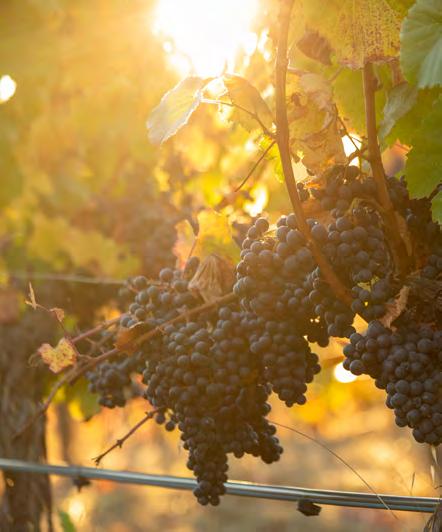
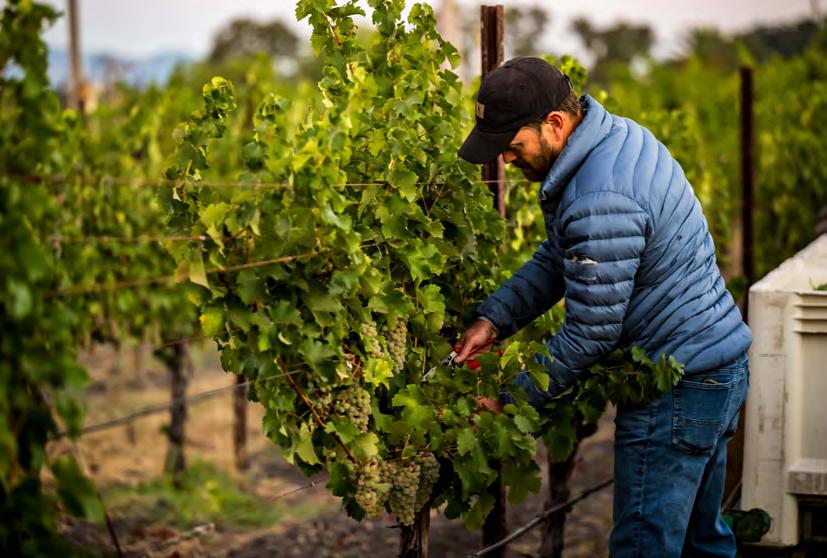

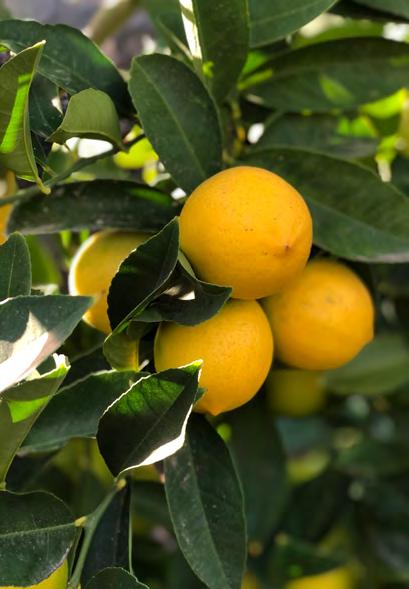
Green. “That’s why we redeveloped our Napa Green Vineyard certification to be the first sustainable winegrowing program focused on regenerative farming, climate action, and caring for people. It’s also why we’ve worked to set the highest standard for sustainability, taking a whole system approach across six pillars, including water, energy, supply chain, soil health and biodiversity, and social stewardship, all under the umbrella of climate action and regenerative agriculture.”
“ We know that we have to do more than sustain, we have to regenerate. That's why we redeveloped our Napa Green Vineyard certification...”
—Anna Brittain, Executive Director of Napa Green
If sustainability in Napa once felt like a choice, climate change has made it a necessity. Warmer summers can shift harvest dates and affect grape ripening patterns, while erratic weather brings the risk of heat spikes, heavy rains, and frost events. More troubling still are the increasing threats of wildfire and smoke taint, which have upended harvests and challenged winemaking in recent years. Sustainability measures can’t halt these changes, but they can help vineyards adapt. Healthy soils retain more water and better withstand drought. Biodiverse landscapes are more resilient to pests and disease. Energy efficiency and renewable power reduce greenhouse gas emissions. In short, sustainability strengthens the system’s ability to withstand shocks.
Sustainability is also human-centered. Fair labor practices, competitive wages, training programs, and worker safety protocols are integral parts of the equation. Many wineries extend their commitment to local sourcing for goods and services, bolstering the regional economy. Community engagement—from educational programs in local schools to land conservation partnerships— reinforces the idea that wineries are not just private enterprises but stakeholders in the valley’s collective future.
Napa Valley’s sustainability journey is still evolving. New technologies in vineyard mapping, data analytics, and precision agriculture promise even more efficient use of resources. Advances in packaging could further reduce carbon footprints. And as younger generations take the helm at family wineries, many bring a heightened awareness of climate issues and an eagerness to innovate. What remains constant is the understanding that sustainability is not a static achievement but a continuous process. Each growing season presents new challenges—and new opportunities to do better.
Napa Valley’s wines are admired worldwide, but the region’s sustainability efforts show that its greatest achievement may be preserving the land and community that make those wines possible. Whether through cover crops in a single vineyard row or valley-wide adoption of renewable energy, the message is clear: the future of Napa depends on the choices made today. Here, sustainability is not a marketing angle. It’s the quiet, deliberate work of ensuring that in 50 or 100 years, someone else can stand in the same early morning light, look across healthy vines, and know the land is still giving back. It’s about respecting the earth, the community, and future generations while continuing to craft wines of excellence. In the glass, that philosophy is reflected subtly yet unmistakably; the terroir tastes better when the land is cared for.
Adds Brittain, “As we work in collaboration with nature, increasing soil health, animal and plant diversity, storing carbon and reducing emissions, we create vineyards and businesses that are more resilient, and ultimately, make the highest quality wines.”
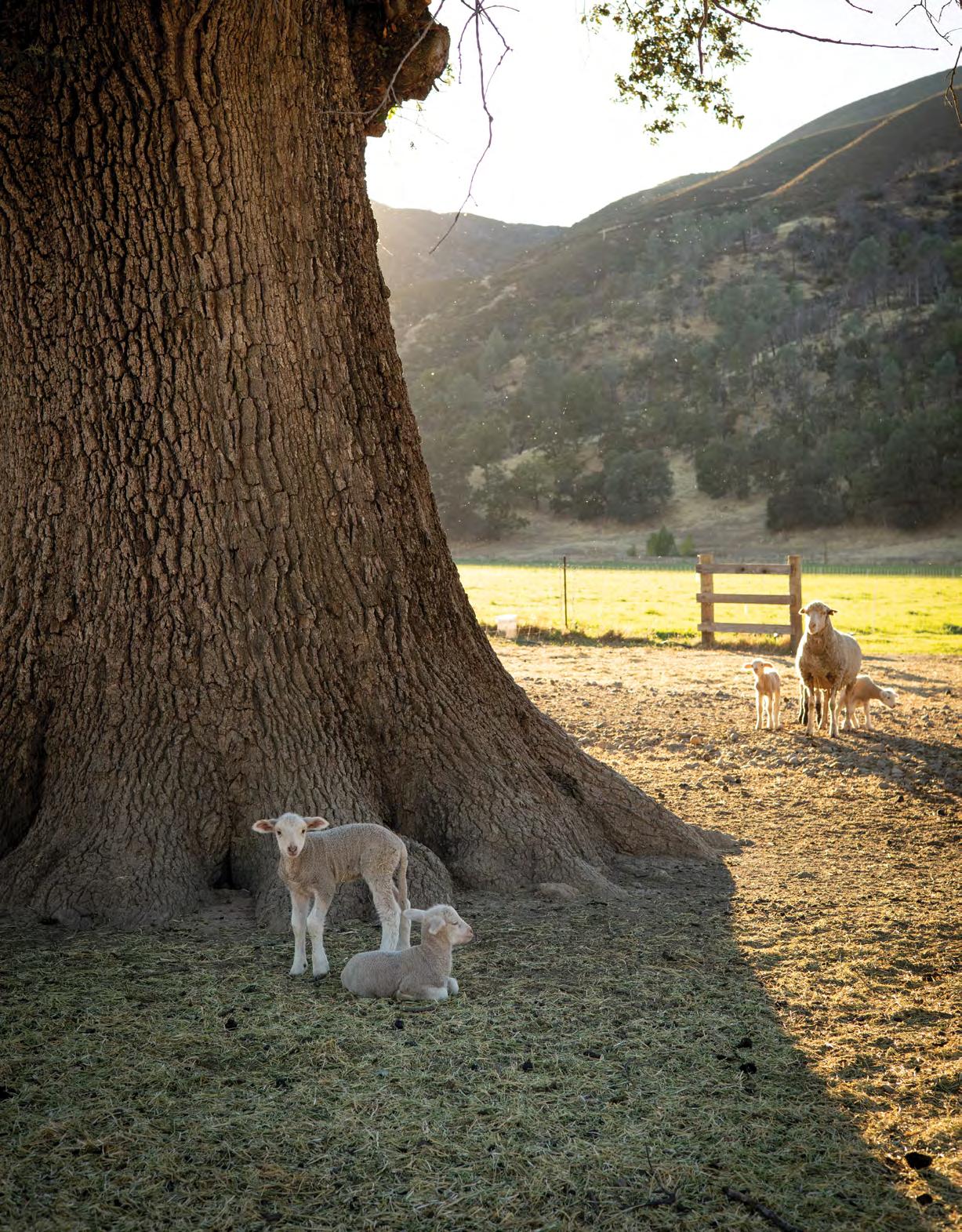
It’s biodynamic, natural, and the sheep are happier, too.
BY LAYNE RANDOLPH | PHOTOS COURTESY OF SHANNON FAMILY OF WINES
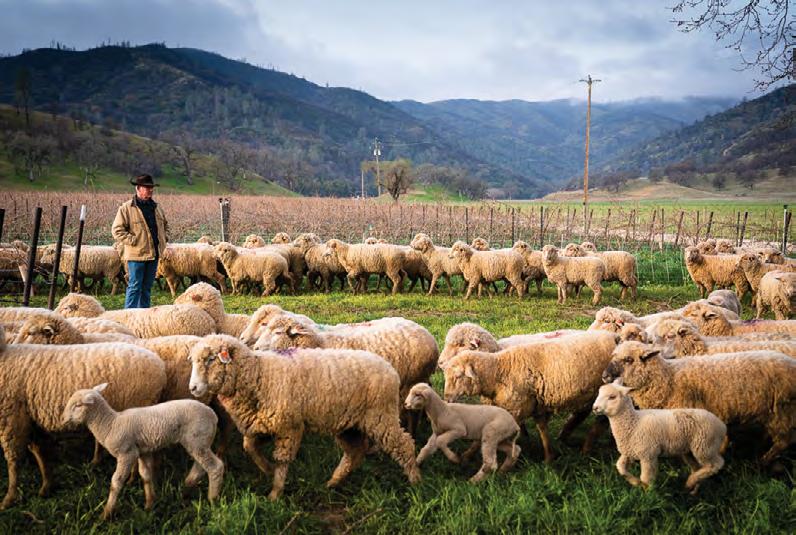
It’s one of the cutest trends in viticulture today: the return of sheep to the vineyards. It brings back an ancient practice that fell out of use in the twentieth century, as post-industrialization shifted its focus from nature to science.
Robert Irwin, founder of Kaos Sheep Outfit, is considered “the sheep guy” by many in Northern California. He is one of the first to reintroduce sheep to the local vineyards, a move that wasn’t universally embraced. Irwin explained, “My grandfather was a really good vet, and I took him out to see what I was doing with the sheep in the vineyard. And, he said, ‘When I was your age, this was a shootable offense. First, they shot the sheep, and then they shot the herder.”
Still, Irwin persisted. “My life for like, 10 years, was figuring out how to get sheep in vineyards. That’s all I ever thought about. Back then, it was just me, and everybody was waiting for it to come down in a big ball of flames. Now, I’ll bet you 150 wineries are using sheep grazing, maybe 200. Everybody’s doing it or thinking of doing it. Even the people who were telling me that there would be soil compaction and all this other stuff—they’ve all flipped over. “
Sheep in vineyards once belonged to the past—part of a mixed-farm toolkit as old as wine itself. Roman agronomists wrote about flocks manuring orchards and vine-planted hillsides; shepherds across the Mediterranean practiced transhumance, wintering animals through fields, orchards, and terraces that needed grazing and fertilization.
Sometimes I pinch myself, because there are now like 30 companies that are grazing vineyards [in Northern California]. I joke around, but there’s a movie line, ‘well, that escalated quickly,’ but it really did.”
According to Luisa Amorim of Portugal’s Herdade Aldeia de Cima winery in Alentejo, sheep grazing in vineyards
Sheeping the vineyards fulfills a lot of needs. It offers numerous benefits, too, fitting seamlessly into organic and biodynamic systems.

The practice receded with the advancement of tractors and herbicides, and the desire to increase yields over flavor prevailed. Today, from Portugal to California, sheep are back—closing nutrient loops, tamping down fire fuels, and, in some places, even doing canopy work.
Farming costs also play a role. Irwin shared, “With the rising prices of diesel, equipment, and inflation, sheep grazing is now cheaper than tractor mowing. I think the green movement, and being more sustainable, has really helped out. But when diesel got to four bucks [per gallon], that’s really when they said yes to me going into a vineyard.”
has deep historical roots in the region’s agricultural traditions. Herdade Aldeia de Cima utilizes a 1500-head White Merino flock, “one of the oldest sheep breeds in Iberia, first introduced by Phoenicians, Greeks, and Carthaginians during their trading voyages,” according to Amorim.
Sheep do more than graze—their activity supports regenerative agriculture by delivering natural fertilization, weed suppression, reduced chemical inputs, and helps biodiversity thrive among the vines. In southern Portugal, the traditional Montado method is practiced—an integration of humans, nature, and animals, including animal grazing, to enhance biodiversity.
“In the Montado landscape, their role is equally vital: they maintain soil health, support the natural regeneration of cork oaks, preserve local biodiversity, and, during the hot Alentejo summers, help prevent wildfires.”
In Lake County, California, Angie Shannon of Shannon Family of Wines has been living this return to the sheep with her husband, Clay, for decades. Their ranch lies on the wind-swept heights above Clear Lake, where agriculture meets the edge of the wild. Geography is the first argument in favor of hooves over horsepower.
As Angie put it, “It’s tough to farm because some of our grades are up to 40 percent. But sheep will terrace the side of our mountain slopes. They go crosswise in groups; this helps with erosion when there is heavy rain, because the rain will stop on the terraces. And sheep help immensely with fire prevention.”
For many estates returning to mixed agriculture, organics and livestock go hand in hand: animals serve as a labor force, a fertilization program, and a fire crew. In the best cases, they’re also a creative solution to vineyard chores usually left to machines or expensive handwork.
“We call it Project Ovis – that’s Latin for sheep.” Leaf removal—done by hand—can be a pricy line item in certain vintages. “Paying someone to go pull leaves costs $500-$600 an acre, but we can throw our sheep in there.” That’s the labor side of the balance sheet. On the soil side, the animals leave behind what vines crave. “They leave pellets that get ground up in the dirt, full of nitrogen and phosphorus. It’s extremely healthy, so you don’t have to worry about adding anything.”
The Shannon ranch operates a rigorous grazing program—centered on protection, rotation, and timing. Predators are part of

The proof is visible from the ridge. A place that once looked barren now stands shaggy with life. “We had this really windy top of our ranch at 2400 feet, that when we bought the property 25 years ago, never had grass. And the sheep would run straight to the top of the hill to group together and sleep, using it as a lookout. And now we grow grass 4 feet tall there.”
That living system meshes with Shannon’s philosophy. “Our ranch is entirely organic. We don’t use any herbicides or pesticides. We’re trying to do a whole closed system. So, we’re not buying anything, not even organic [farming] products. We went totally certified organic eight years ago.”
the landscape, so the team designs with wildlife in mind. “We use mobile electric fences because we have a lot of predators. You gotta protect the sheep from bears, coyotes, and eagles. In the summer, you can’t turn on the electricity because it could cause a fire, so we also have 12 guardian dogs, Pyrenees and Anatolians. We’ll put a few heads in with the sheep to protect them. We also have three border collies.”
Other grazing animals can be used, but for many reasons, sheep are preferred. “Cows end up going straight up a hill and creating erosion problems. Goats are great if you want to knock down your brush, but they’ll be climbing onto your house. But sheep are very gentle on the land.”

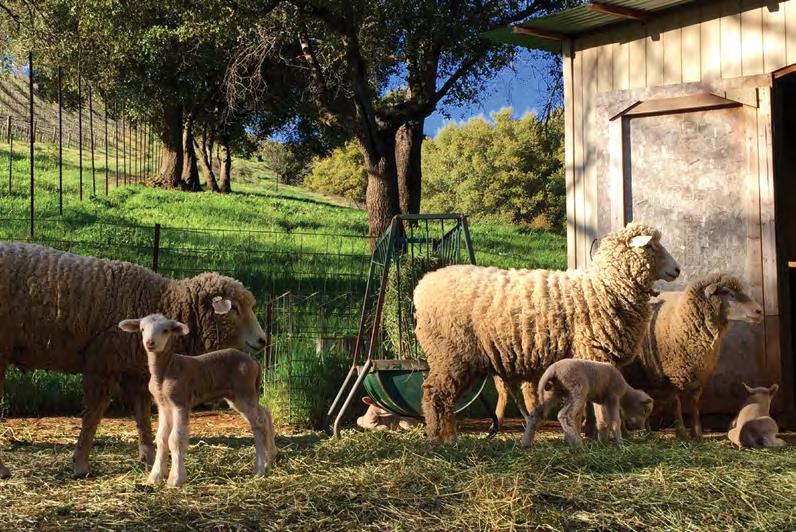
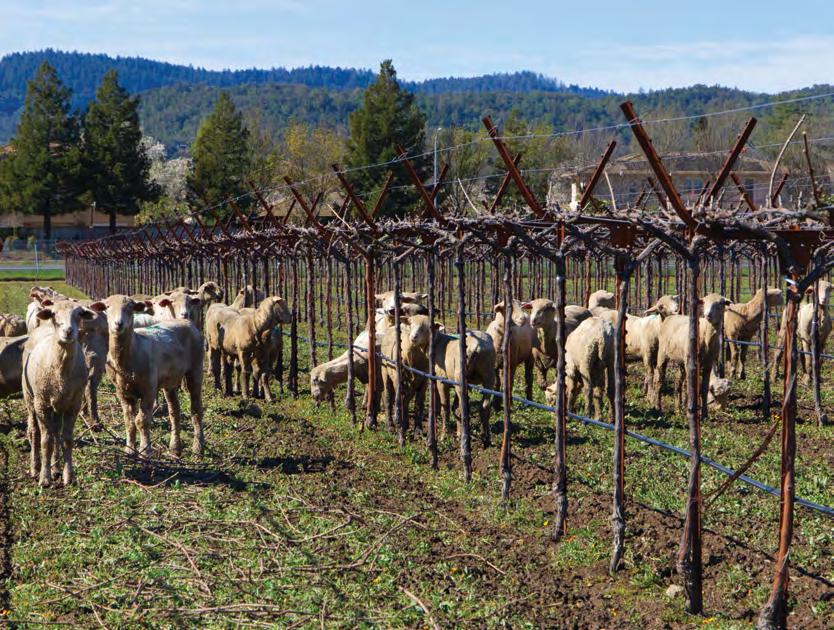
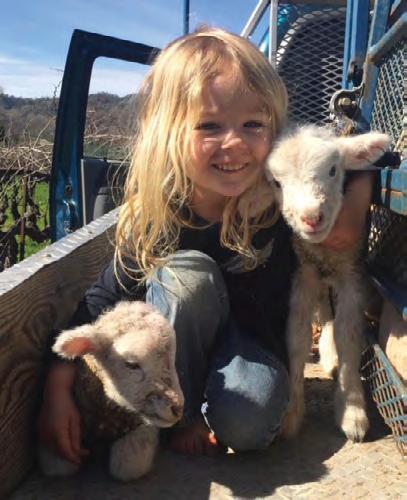
That gentleness—plus their flocking instinct— lets a crew steer hundreds of animals and hold them in precisely the block that needs eating. The result is a moving, munching cover-crop mower that fertilizes as it goes.
It’s a misnomer that sheep don’t eat the fruit, though; it’s all in the timing. Angie Shannon shared, “Up to veraison, when the grapes are pea-sized, hard, and sour, the sheep don’t like them. They also don’t have upper teeth, so they go for the soft grape leaves instead, which are extremely high in protein and very sweet for the animals.”
Amorim follows a similar rotation. “Our White Merino flock lives in free range in the estate and is guided seasonally: they are introduced to vineyards mainly during dormancy or when cover crops need to be managed and carefully withdrawn once there is risk of vine damage. It is a process of balance and respect for both the vines and the animals.”
That’s a recurring theme—the respect for the animals and the land. Angie reiterated this point. “My husband and I say if you’re going to do this, you have to love the animals, because it’s so much work.”
Sheep-grazing is making a return in Napa Valley, Sonoma, Mendocino, and Lake Counties, partly because the ground needs to be kept clean for fire
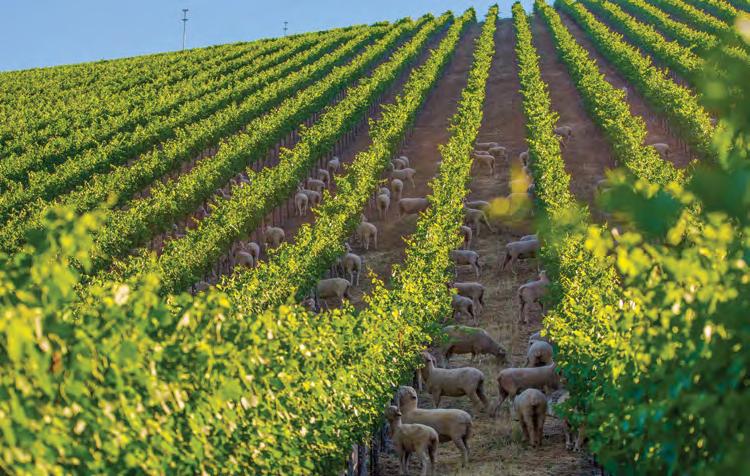
“Clay calls it ‘sheeping’—they remove all the leaves in the fruit zone, so we don’t have to pull leaves for ripening. But after verasion, they can’t be in the vineyard.”
“We practice intentional grazing rotation, so you don’t overgraze any area and can use them seasonally. So, in spring, they’ll clear out the cover crop in the vineyard in seconds. In the summer, we’ll place them in a non-crop area when the fruit is ripe. And in the winter, once we get rain, they’re everywhere, because there’s green grass.”
“They will clean that vineyard postharvest, too. And they’ll eat anything that’s on the ground. Because of them, we’ve noticed such a massive influx of fertility in our vineyard. Nutrients and microbes in the soil are 100 times better than those in soils that were not grazed.”
protection, partly because labor is expensive and scarce, especially for repetitive, backbreaking chores like suckering and leaf-pulling, and more recently because consumers—and the winemakers who serve them—are increasingly fluent in soil health, biodiversity, and the flavors that come from living earth.
Sheeping the vineyards fulfills a lot of needs. It offers numerous benefits, too, fitting seamlessly into organic and biodynamic systems. Still, it has a pragmatic place in farms that aim for fewer tractors and reduced chemical use.
And they’re pretty cute, too.
“My sheep are all going across California in about 10 days. And I won’t get them back until a little after Thanksgiving,” Irwin said with pride. “And then they’ll have babies and wonderful lives, outside, natural.”
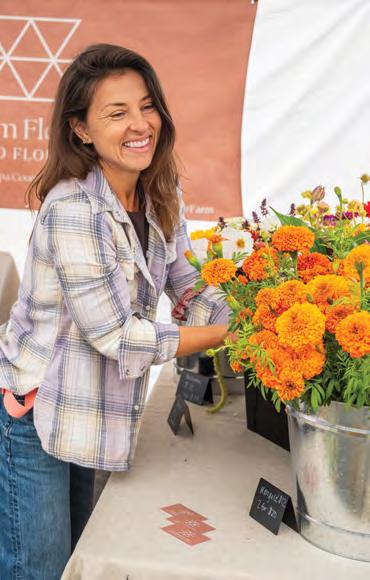
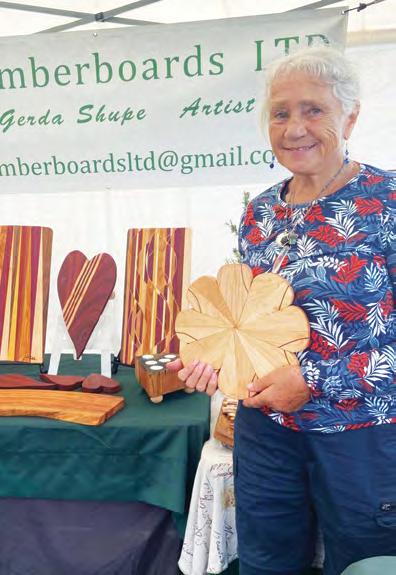
Every Saturday morning—and on Tuesdays from April through December—a parking lot in downtown Napa transforms into a vibrant hub of color, conversation, and community. This is the Napa Farmers Market, a year-round gathering that prioritizes local produce, sustainable practices, and small business visibility. From heirloom tomatoes to handcrafted wooden cutting boards, the market offers more than groceries and gifts—it offers a genuine sense of connection, where everyone is welcome.
The market takes place at 1100 West Street, in a city parking lot. It’s open from 8am to 12pm, rain or shine. Saturdays are the busiest, drawing both locals and weekend visitors. Tuesdays are more relaxed, with plenty of time to chat with farmers and vendors. Parking is free and easy—though arriving early ensures the best availability— and the energy is always palpable.
Founded in 1986, the Napa Farmers Market is now one of the largest in the North Bay. At peak season, it features more than 70 vendors, including sustainable farms, small-batch food producers, and local artisans. Everything sold must be grown or made in California, and most vendors hail from within a 60-mile radius.
At the heart of the market are the farmers, many from multigenerational,
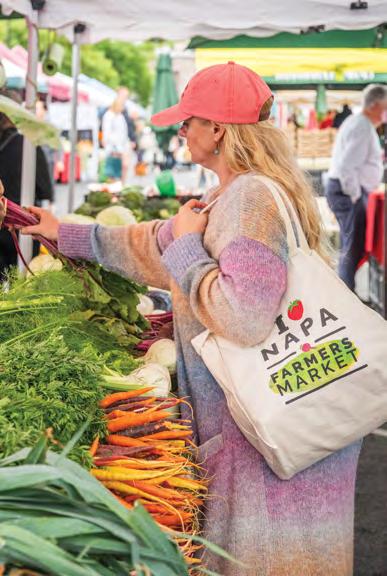
BY FRAN MILLER | PHOTOS COURTESY OF NAPA FARMERS MARKET
“Yes, we are a market, but more so, we are a community connector. We are proud to be a welcoming and accessible place for everyone.”
–Cara Mae Wooledge
family-run operations. They arrive early, unloading crates of just-picked stone fruit and baskets of eggs still warm from the morning’s gathering. Customers browse, sample, and engage—building relationships based on trust and transparency. Beyond produce, small-batch food makers and artisans bring another layer to the experience. Every item is handmade by local businesses. One booth showcases unique cutting boards and wooden serving pieces. Others feature handmade jewelry, soaps, and vibrant, hand-dyed clothing. There’s locally roasted coffee, fresh-baked goods, and a tempting array of hot food options. The mix changes weekly, but the quality never wavers.
But the market isn’t just about food— it nourishes community. Relationships
blossom, conversations flourish, and people stay connected to their food and each other. The Market Match program, for example, helps low-income shoppers stretch their food assistance dollars by doubling CalFresh benefits—a tangible effort to make farm-fresh, healthy food accessible to more people.
For many, the market is a weekly ritual. It’s a place to meet the farmer who grew your peaches, to learn how to keep greens fresh longer, or to plan dinner based on what looks best that day. It’s also a social hub—where neighbors run into each other, sip coffee, and catch up.
Operated as a nonprofit, the Napa Farmers Market is managed by a small team, with help from community partners and volunteers. Their mission is simple and powerful: support local agriculture, promote healthy living, and build community through direct exchange.
“Yes, we are a market, but more so, we are a community connector,” says Executive Director Cara Mae Wooledge, who notes the market is an ideal destination for holiday shopping and is stocked with all the essentials. “We are proud to be a welcoming and accessible place for everyone.”

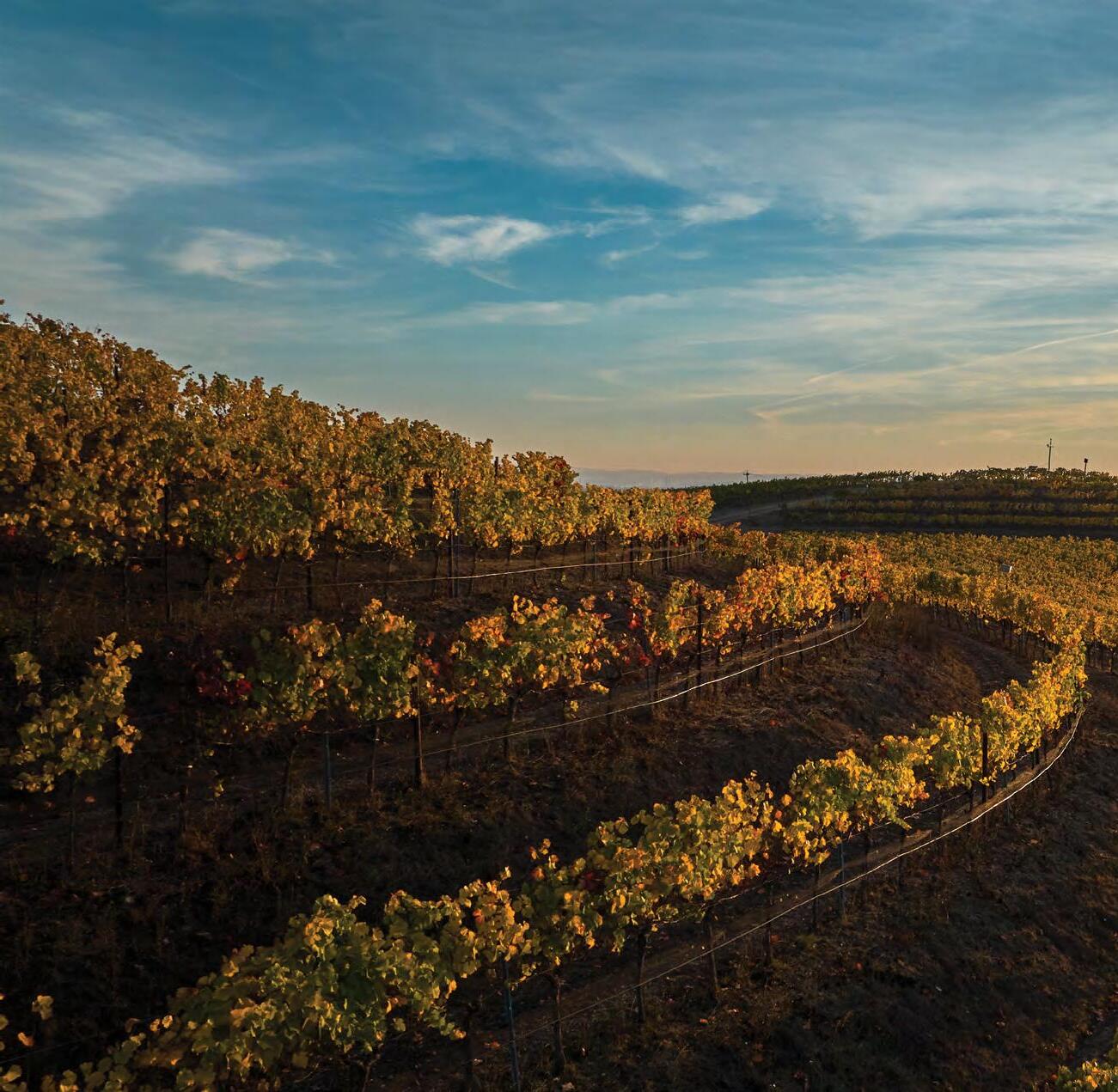
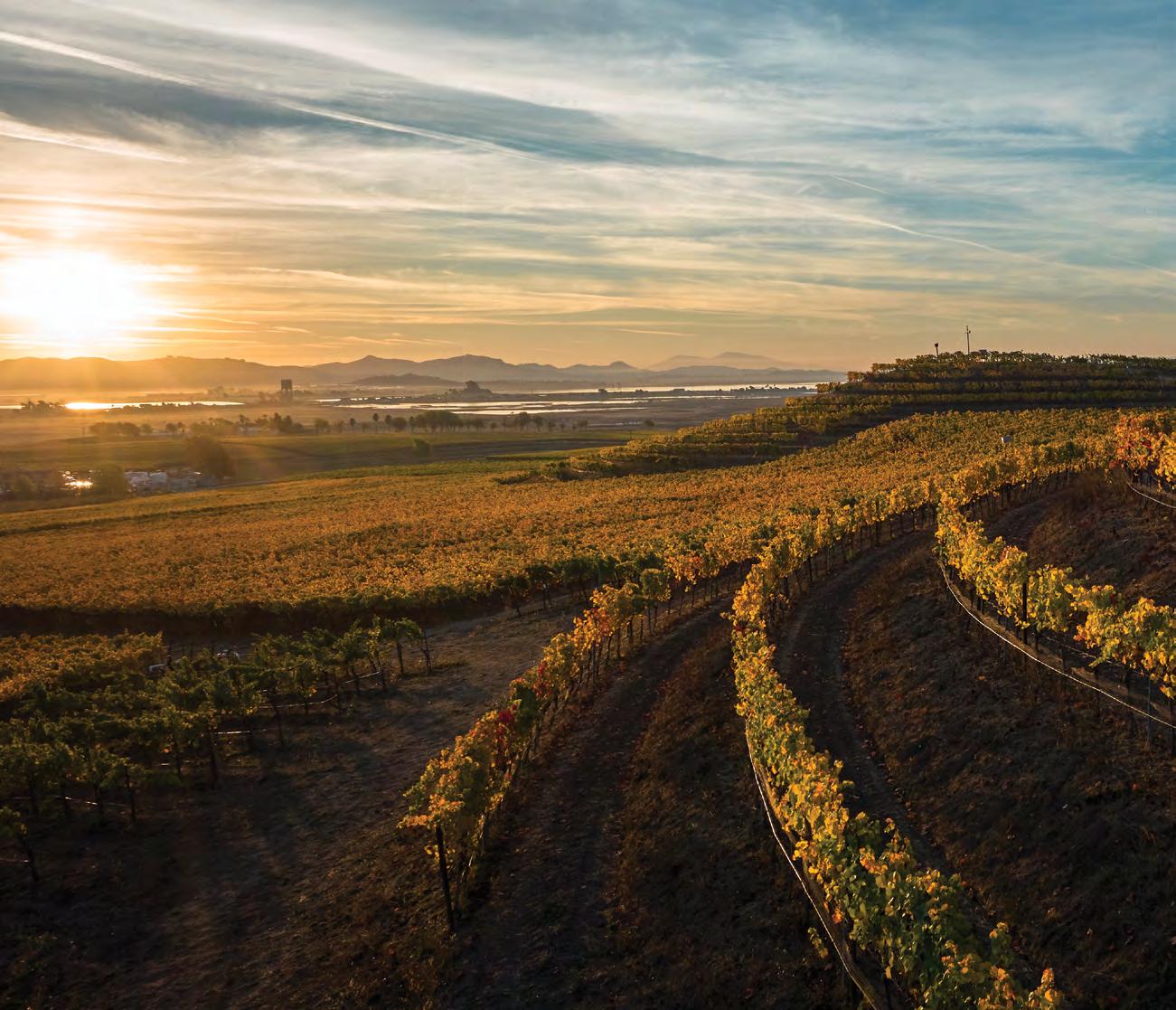
BY MELISSA VOGT
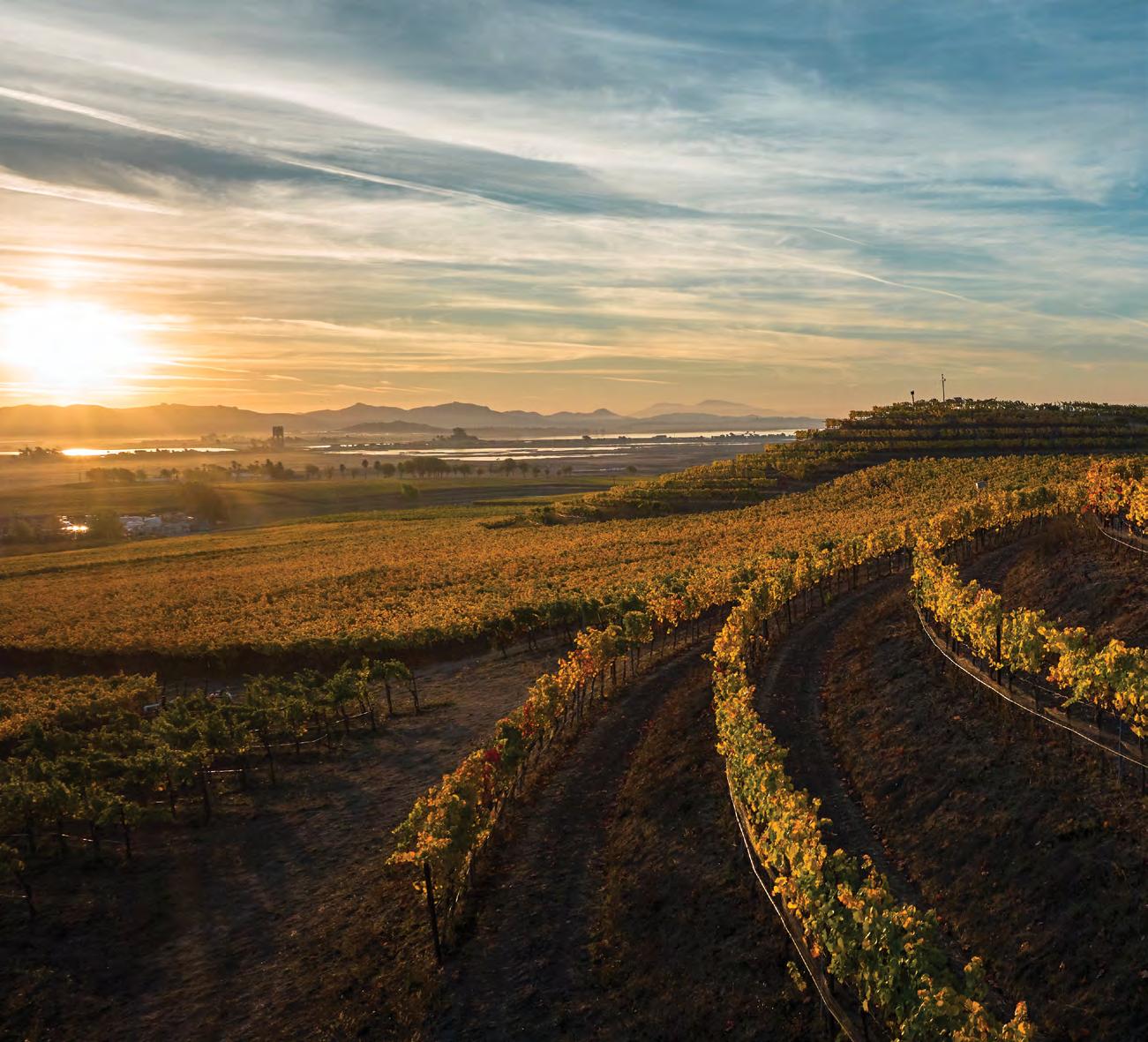

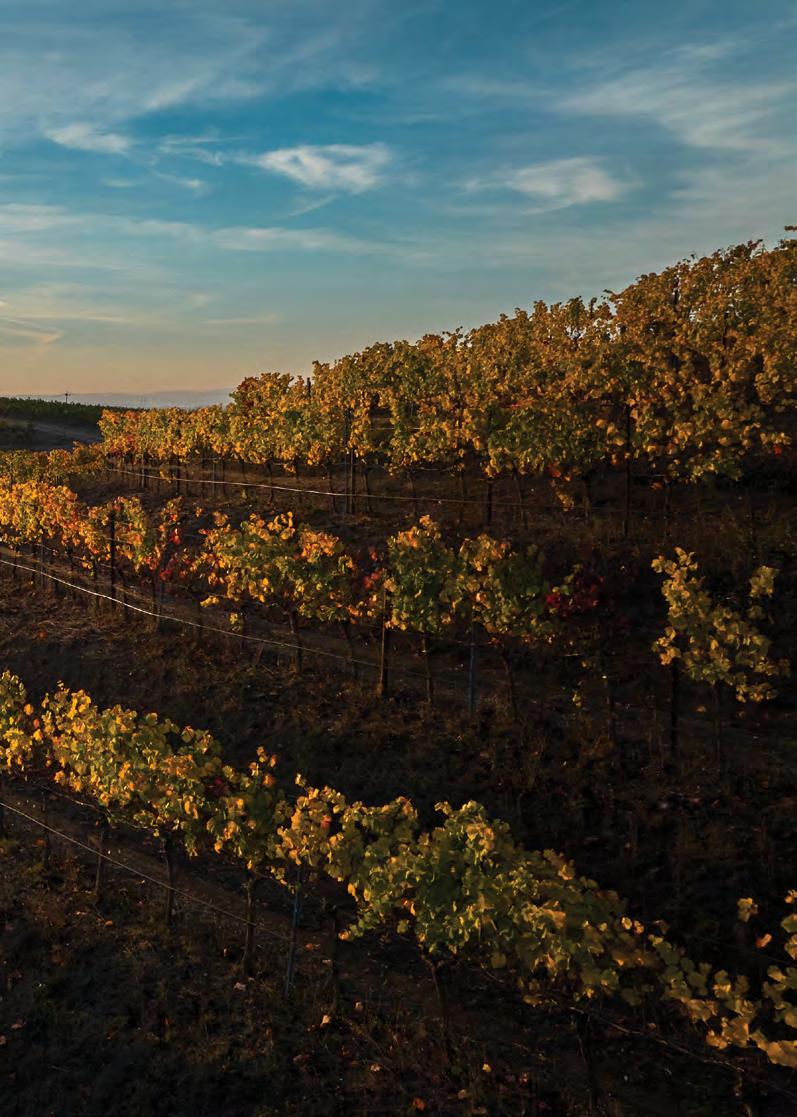
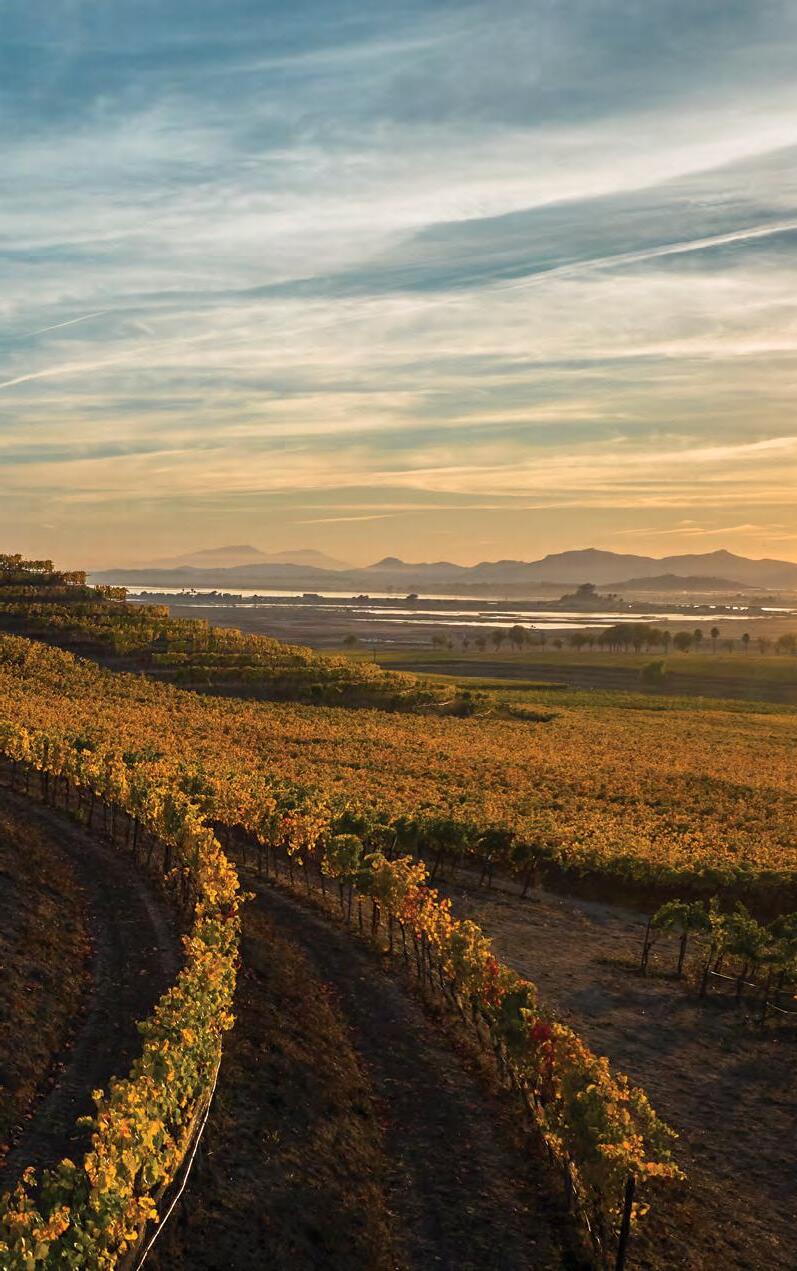
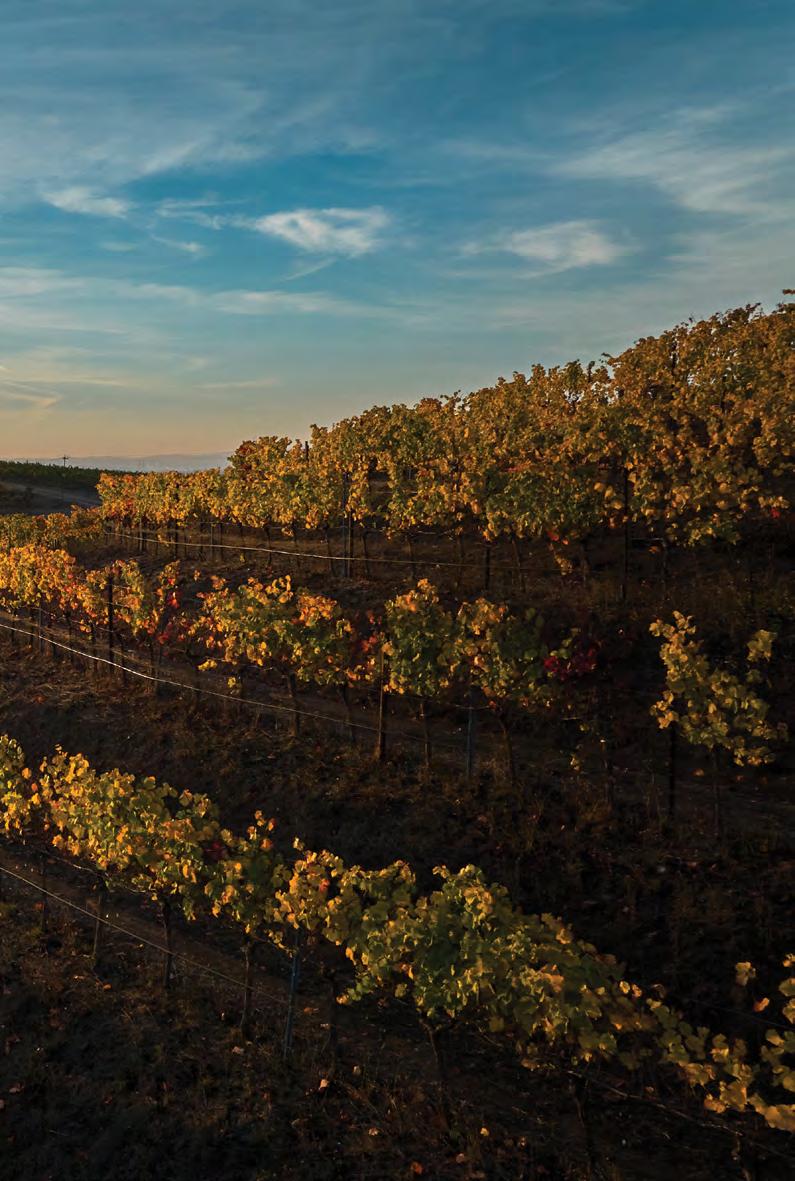

The Los Carneros AVA lies at the southernmost tip of Napa Valley, where low-rolling hills meet the San Pablo Bay. Known simply as “Carneros,” this is a land defined not by grandeur or height, but by the soft marine breeze, the slow lift of morning fog, and the unmistakable cool-climate terroir expressed in every glass poured. Officially recognized in 1983 as the first AVA defined by climate rather than geography, Los Carneros remains a place where the Bay creates wines of freshness, vibrancy, and precision
Los Carneros stretches across both Napa and Sonoma counties, a rare bi-county designation that speaks to its definition by climate. Rolling from sea level up to 700 feet, the AVA is anchored by claydominated soils, which hold winter rains and delay bud break, then restrict vigor through shallow, dry topsoil in summer. “The cool maritime climate allows for wines with freshness and vibrancy, while the soil lends depth and character,” says Jon Priest, senior winemaker and general manager at Etude. This dance of climate and clay defines Carneros as a place where winemakers excel in crafting elegant wines with balanced acidity.
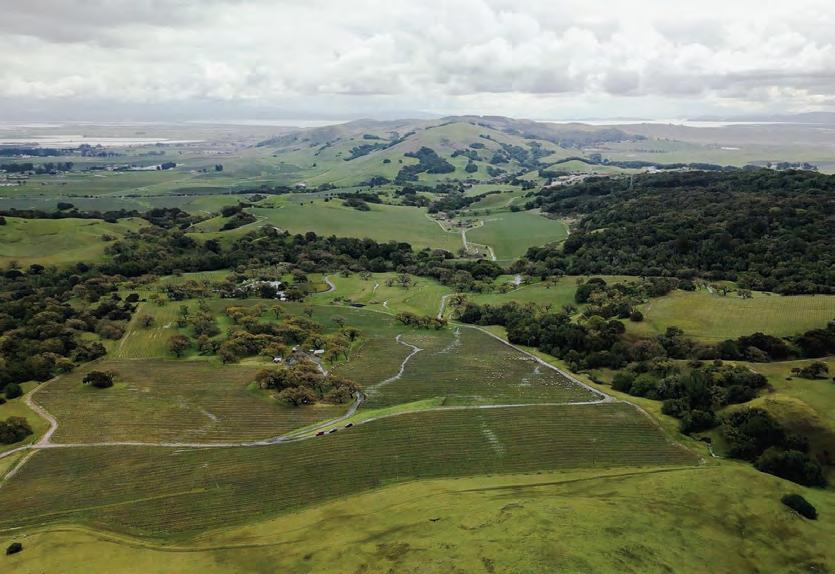
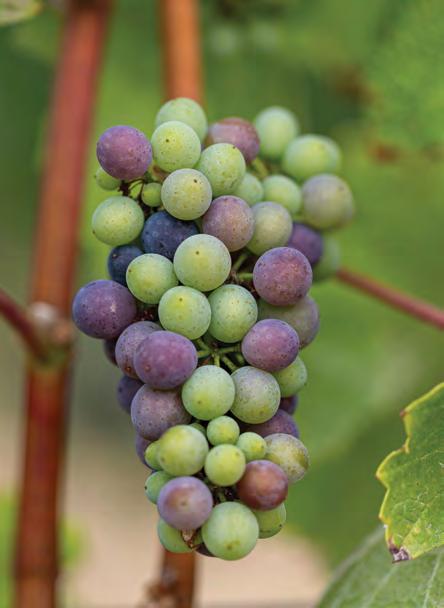
Each day begins with fog that lingers into late morning, a natural blanket that slows ripening. By afternoon, strong breezes from the San Pablo Bay sweep over the vines, ensuring daytime highs rarely crest 80 degrees—it’s typically about 20 degrees cooler than up-Valley AVAs. The interplay of fog, sun, and wind is so consistent that, as Priest notes, “You can almost set your
traditionnelle, leading houses like Domaine Carneros to craft world-class sparkling wines. “Those marine influences are what define the region and produce an expression of Pinot Noir and Chardonnay that is lean, balanced, restrained but unctuous,” explains TJ Evans, winemaker at Domaine Carneros. The result is sparkling wines that capture tension—between acidity and power, freshness and depth—hallmarks that have made Carneros a benchmark for domestic sparkling wines.
Carneros is dominated by Chardonnay (50%) and Pinot Noir (43%), the twin pillars that thrive in cool-climate conditions. Pinot Noir here is plush with cherry fruit yet taut with acidity, often showing
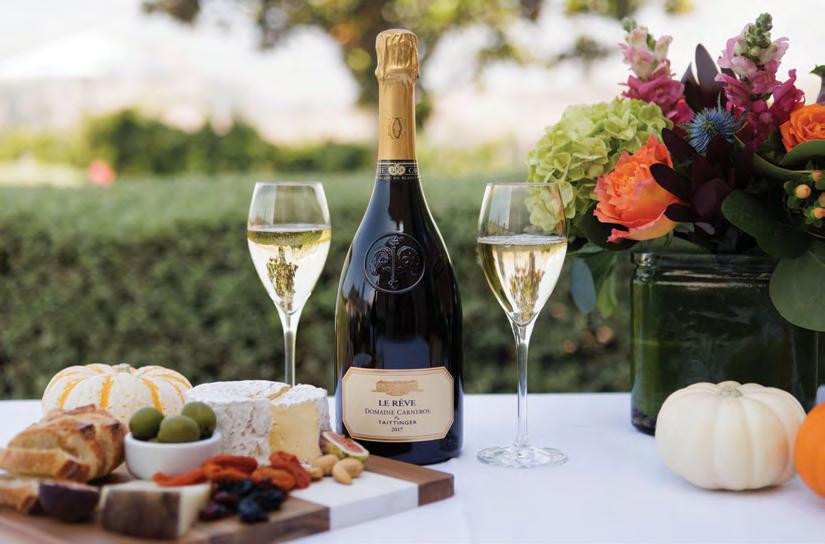
watch to when the strong ocean breezes whip over the hilltops to cool the vines.”
For Pinot Noir and Chardonnay, this climate preserves acidity, tempers alcohol, and draws out nuance—wines that are structured yet fresh, lean yet layered.
Carneros is often called “Napa’s Burgundy,” given its affinity for Chardonnay and Pinot Noir, yet the argument for “Napa’s Champagne” is equally compelling. The Bay’s cooling influence produces fruit that lends itself beautifully to méthode
earth, spice, and a silken structure. Chardonnay ranges from mineral-driven to richly textured, often striking a balance of brightness and cream. Still, Carneros’ story extends beyond the classics.
Etude has championed Pinot Blanc since 2000, exploring the grape’s refreshing potential at its Grace Benoist Ranch. Bouchaine has nurtured Riesling, a passion project that Chris Kajani, president and winemaker, says flourishes in Carneros’ fog-kissed soils: “The cool climate here is perfect for an aromatic grape such as this.” Domaine Carneros experiments with Pinot Clair, a fascinating hybrid wine that Evans
began in 2008 as an exploration in texture and crispness. These varietals, alongside Gewürztraminer and Merlot, enrich Carneros’ identity, reminding us that the AVA has much variety to discover.
Etude has been part of the Carneros fabric since 1982, founded just before the AVA itself was established. Rooted in the soils of Grace Benoist Ranch, the estate reflects what Priest calls “a quiet elegance—it’s where restraint and purity meet.” Etude’s ethos has always been about patience and observation—listening to fog, soil, and vine in order to coax out wines of vibrancy and depth. Pinot Noir remains the soul of Etude, crafted with an artistry that allows fruit to fully mature while preserving its natural acidity. Their exploration of Pinot Blanc,
a place that is dominated by vibrancy,” says Kajani. Situated on 100 rolling acres, Bouchaine harnesses Carneros’ microclimates and patchwork soils, blending fruit from diverse sites to maximize flavor while maintaining acidity. “That push and pull of cool mornings to bright afternoons captures exactly what makes Carneros special among other regions in wine country,” Kajani explains. The results are wines that reflect freshness—Chardonnays with bright minerality, Pinot Noirs with energy and depth, and Rieslings with electric acidity.
Innovation and intimacy define Bouchaine. The Riesling program, once a mere passion project, has become an emblem of how Carneros can surprise. “Riesling thrives and can produce beautiful, complex wines,” Kajani says, “and the cool climate here is perfect for an aromatic grape such as this.” Their Pinot Noir program, rooted in clonal diversity,
Carneros is dominated by Chardonnay (50%) and Pinot Noir (43%), the twin pillars that thrive in cool-climate conditions... Still, Carneros’ story extends beyond the classics.
planted in 2000, shows their commitment to diversity within the Carneros lens.
The winery’s philosophy is anchored in the idea that terroir should be tasted in the glass. “Carneros is unique because it spans across Napa and Sonoma, so balance is at the heart of this AVA,” Priest explains. That balance shines in Etude’s Heirloom Pinot Noir, a bottling of historic selections that carries a vibrant yet layered profile—proof of how fog, wind, and soil converge here. Beyond the wines themselves, Etude has played a defining role in the AVA’s story: “Carneros was one of the first regions to show the world how California could excel with cool-climate varietals like Pinot Noir and Chardonnay,” Priest notes, “and Etude was paramount in helping to define not just the borders of this new AVA, but also its uniqueness.”
Bouchaine Vineyards, the oldest continuously operating estate in Carneros, embraces vibrancy as its ethos. “Los Carneros is
captures what Kajani calls “the heartbeat of Carneros.” With a community-driven spirit, Bouchaine reflects the AVA’s collaborative essence: “The winemaking community here is tight-knit, passionate, and supportive.” A visit to their estate brings all of this to life—sweeping views of the San Pablo Bay, estate gardens, and wines that echo the land’s natural rhythm.
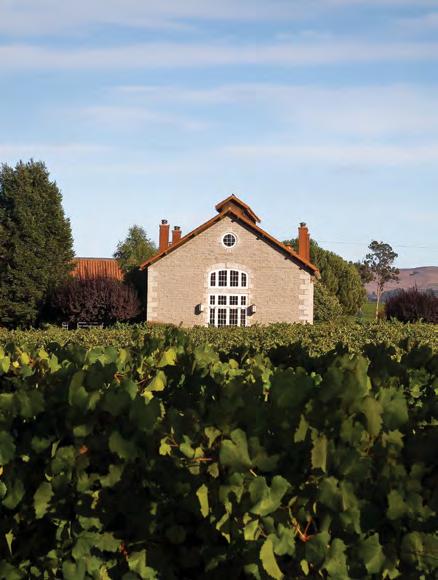
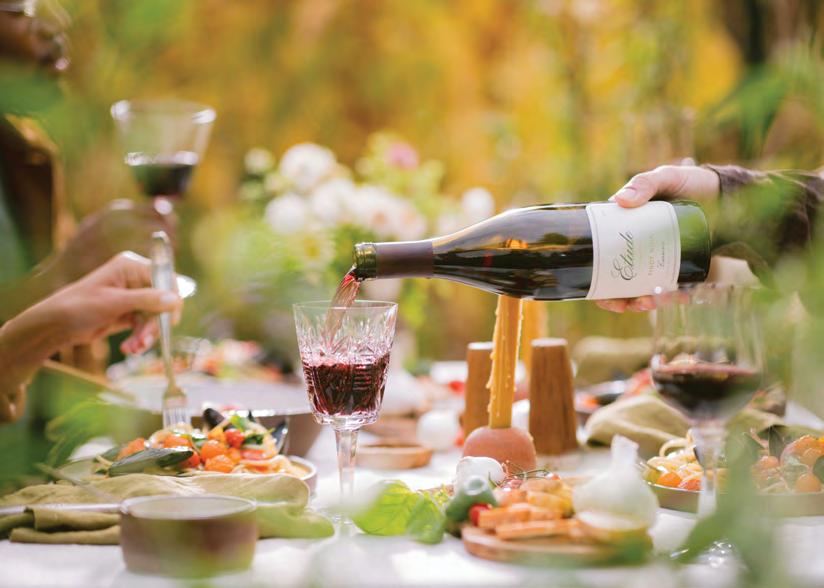
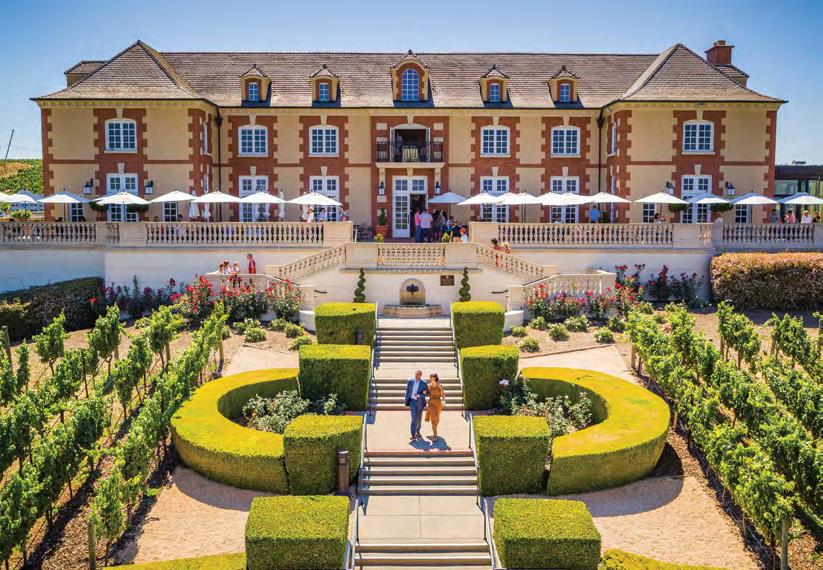
Founded in 1987 by Champagne Taittinger, Domaine Carneros has become synonymous with Carneros’ sparkling legacy. Anchored by six estate vineyards, each with distinctive character, the winery honors its heritage while innovating at the edges of tradition. “Every one of the six estate vineyards has a distinctive character that we honor by
“a fascinating hybrid wine” that balances richness with a crisp finish, aged partially in a concrete egg.
A GATEWAY of DISCOVERY
Los Carneros is more than an appellation—it is a gateway, welcoming visitors at Napa’s southern border with a distinctive cool-climate identity. Its history stretches from Mexican land grants to pioneering
Carneros is often called “Napa’s Burgundy,” given its affinity for Chardonnay and Pinot Noir, yet the argument for “Napa’s Champagne” is equally compelling.
planting with appropriate varietals and clones,” says Evans. Their Le Rêve Blanc de Blancs stands among California’s most esteemed sparkling wines. Evans notes, “We’ve even developed a proprietary yeast to produce a tiny, fine bead of bubbles.”
But Domaine Carneros is not only sparkling. Their exploration of still wines— particularly Pinot Noir and their experimental Pinot Clair—extends Carneros’ story. “We’ve been making our Pinot Clair since 2008. This wine started as an experiment,” Evans shares, describing it as
sparkling houses, its terroir defined by clay soils, fog, and wind. Today, the AVA’s wines—whether Pinot Noir, Chardonnay, or its more unique gems—carry forward a narrative of elegance, restraint, and discovery.
For travelers, Carneros offers an invitation: to sit in the breeze, to watch fog lift, to taste wines shaped by rhythm and balance. Whether at the storied halls of Domaine Carneros, the intimate gardens of Bouchaine, or the quiet strength of Etude, Carneros is where Napa begins—and where cool-climate California finds its voice.
Domaine Carneros 2017
Le Rêve Blanc de Blancs
A flagship sparkling, showing delicate notes of white flowers, citrus blossom, and brioche. The mousse is fine, persistent, and creamy, with a finish of mineral precision and elegance.
Domaine Carneros 2023
Pinot Clair
A unique, hybrid expression of Pinot Noir and Chardonnay. Aromas of red berries and pear interplay with a textural palate— rich yet lifted—balanced by a crisp, clean finish.
Bouchaine Vineyards 2022
Pommard Clone Estate
Pinot Noir
Dark cherry, plum, and spice leap from the glass, accented by earthy undertones. Silky tannins and bright acidity create tension and length on the palate.
Bouchaine Vineyards 2022
Estate Riesling
Vibrant, dry, and racy with electric acidity. Notes of lime zest, jasmine, and green apple dance on a crisp, mineral-driven frame.
Bouchaine Vineyards 2022
Reserve Chardonnay
Golden-hued with aromas of lemon curd, toasted hazelnut, and subtle oak spice. The palate is broad yet balanced, with a creamy texture lifted by bright citrus.
Etude 2023 Pinot Blanc
Fresh and aromatic, with notes of white peach, citrus, and honeysuckle. The palate is lively, offering depth and a clean, refreshing finish.
Etude 2021 Heirloom Pinot Noir
Complex and layered, with ripe cherry, raspberry, and rose petal interwoven with spice and forest floor. Vibrant acidity underpins a long, elegant finish.
BY FRAN MILLER
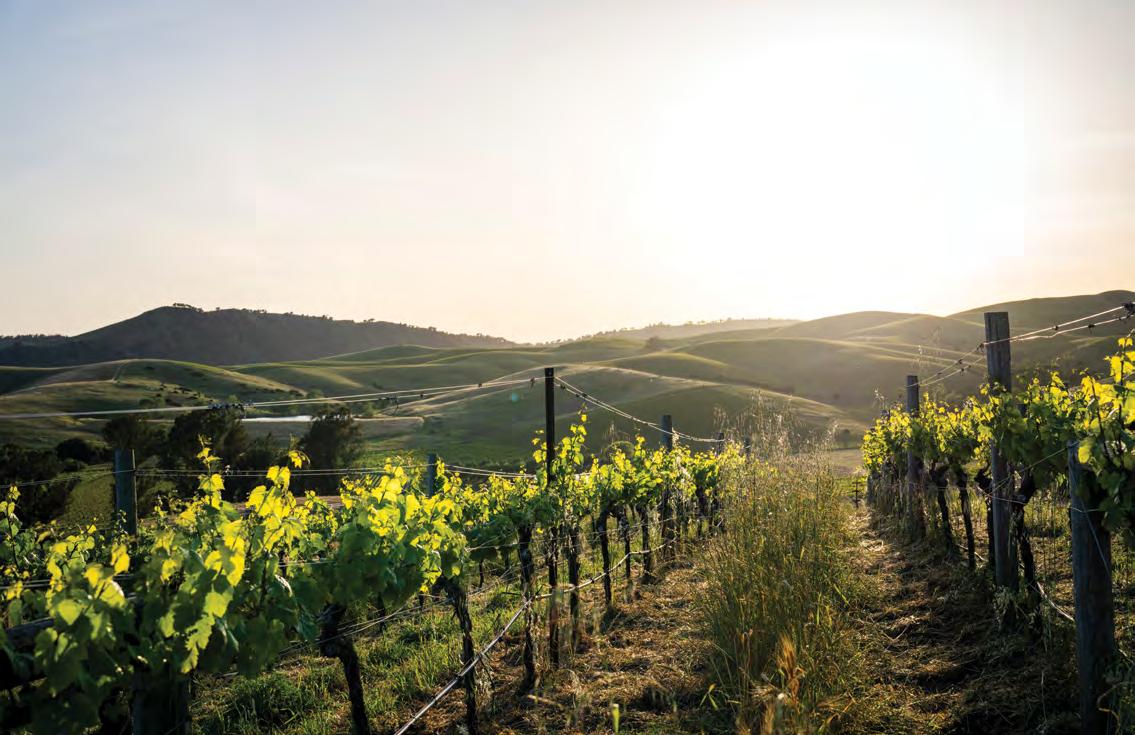
In 2024, Firetree Family Vineyards was named one of the most influential Latino-owned wineries in the United States—a remarkable achievement considering proprietors Rafael Ricardo JiménezDan and his wife, Dayva Jimenez, have only recently taken the helm of this historic Carneros property.
For Jiménez-Dan, a Venezuelan-born entrepreneur with deep agricultural roots, Firetree is both personal and professional. Raised in one of Venezuela’s most dynamic farming regions, he earned his degree as an Agricultural Technician with a specialization in phytotechnology before launching a multifaceted career spanning hospitality, technology, and real estate. But the land has always called him back.
Alongside Vineyard Manager Ben Leachman and winemaker Julien Fayard, the family is implementing organic and regenerative farming practices certified by Napa Green and Fish Friendly Farming. Their approach is hands-on and holistic: a permanent herd of goats and Babydoll sheep graze between the vines, managing cover crops naturally; participation in the California Department of Food & Agriculture’s Healthy Soils Program enriches the vineyard’s foundation; and a partnership with the Napa County Resource Conservation District
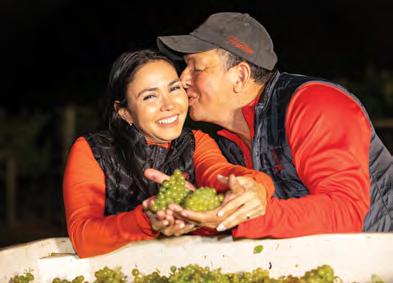
is introducing an experimental California native pollinator cover crop.
“Rafael is so passionate about the vineyard,” says Jimenez. “He cares for the vines personally, working closely with Ben and Julien, and giving his full attention to the quality of every vine. You can taste that dedication in our wines.”
The result is a beautiful Chardonnay that reflects the site’s rare combination of cool-climate freshness and sunlit concentration—a Burgundian-style wine that is pure Carneros.
The vineyard’s history stretches back to 1838, when the land was part of the Napa Rancho granted to Salvador Vallejo by the Mexican government. Over the decades, it passed from pioneer families to orchardists, livestock grazers, and Italian immigrants,
each leaving their imprint. In the late 1970s, Michael and Helen O’Hara acquired the largely undeveloped property, planting Chardonnay in 1988. That same year, Silverado Vineyards recognized its potential and refined the plantings, adding new Chardonnay clones— grapes that became a prized component of Silverado’s Napa Valley Chardonnay.
Now, under Jiménez-Dan and Jimenez’s stewardship, Firetree’s story has taken a decisive turn. Their focus on soil health, biodiversity, and community positions the vineyard not only as a producer of exceptional wine but also as a model for responsible farming in Napa Valley. It’s a philosophy that, when blended with their joy of sharing, shapes every decision they make in the vineyard and cellar.
“For me, winemaking is about more than creating a product—it’s about creating moments,” says Jiménez-Dan. “From the field to the table, we care for the vines with love and passion, knowing that each bottle will become part of someone’s gathering, a celebration, a memory. The idea that our wine might be on a table somewhere, surrounded by friends and family, bringing joy and connection—that’s an amazing feeling.”
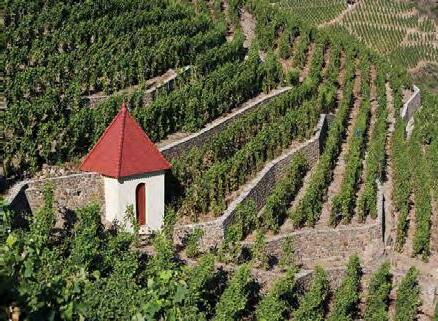
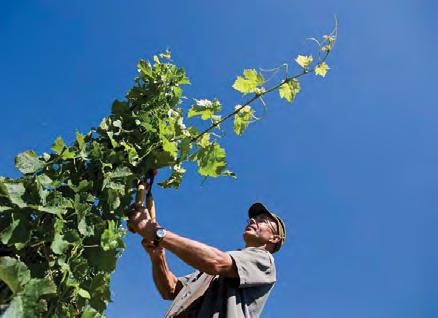
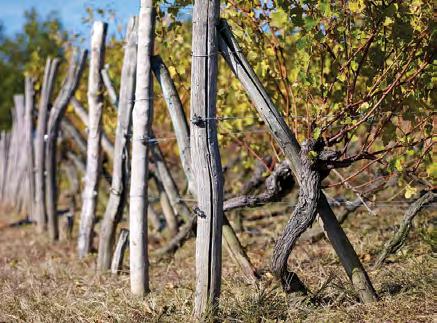
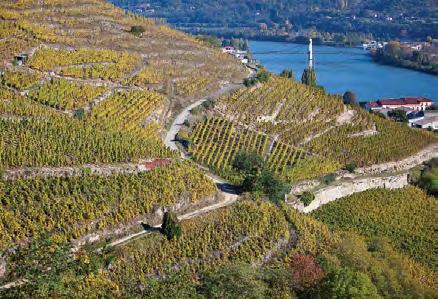
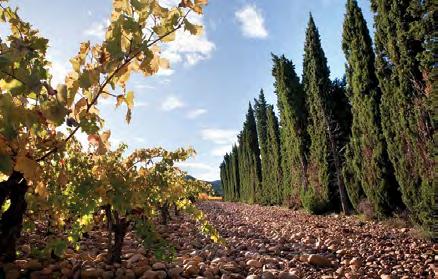

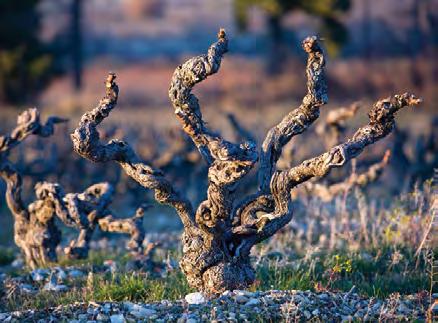
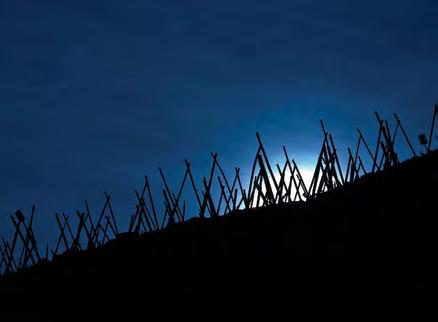
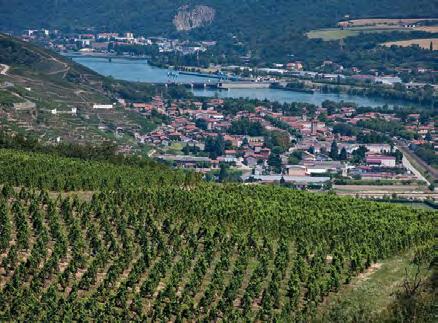
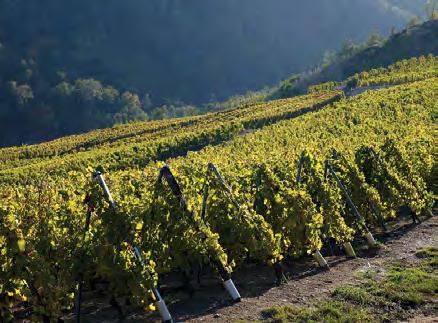
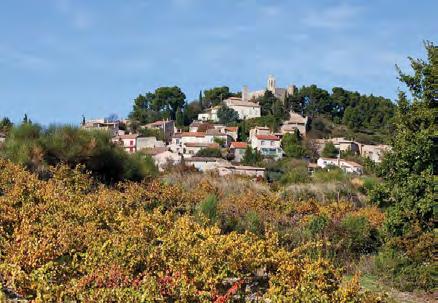
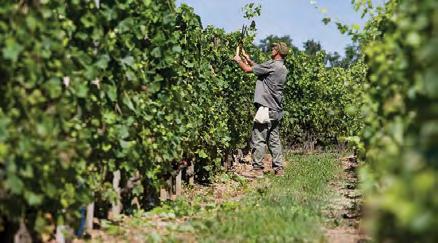
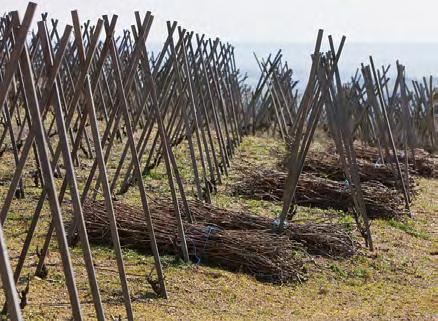
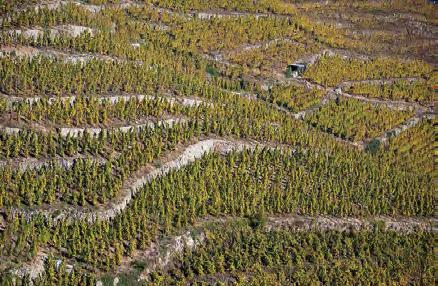
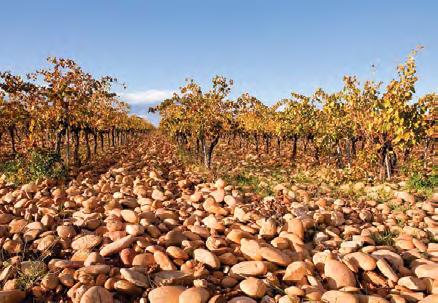
The Rhône Valley stretches roughly 200 kilometers from Vienne to Avignon, two halves of one valley. Upstream is the Northern Rhône: narrow hillsides, terraces, and Syrah as the only red grape permitted by AOC rules. Downstream is the Southern Rhône: a broader, Mediterranean landscape with blends led by Grenache and a climate shaped by the dry north wind locals call the Mistral. Understanding that split— geology, grapes, and climate—explains what you taste. (Note: the two vineyard clusters aren’t contiguous—there’s a ~40 km (~25 mile) gap with almost no vines between Valence and Montélimar.)
Wine moved along the Rhône long before modern labels. Roman trade utilized the Rhône–Saône corridor to supply Lyon, establishing vineyard zones near the transport routes. In the 14th century, the papal court in Avignon promoted the planting of vines around what would become Châteauneuf-du-Pape.
Fast-forward to the 1930s: France launched its AOC system. Châteauneufdu-Pape was among the first to be recognized in 1936. The mid-20th century saw replanting efforts following the phylloxera outbreak, and later, improvements in farming practices and cellar work enhanced reliability throughout the valley, ultimately leading to the Rhône Valley of today.
For maximum wine variety with minimal travel, the Rhône is the most timeefficient region in France: Northern Rhône (Syrah, Viognier, Marsanne/Roussanne) and Southern Rhône (Grenache-led blends, Tavel rosé, right-bank whites)—linked by a short, drivable/rail corridor. Layer in Avignon’s papal heritage, one of the bestpreserved Roman theatres at Orange, and trailheads in the Dentelles, and you’ve got a trip that blends tasting, history, and landscape in four to six days.
The Northern Rhône is a narrow ribbon of hillside vineyards running from Vienne to just below Tain-l’Hermitage. Granite and schist dominate the slopes, many of them terraced and worked by hand. Syrah is the only red grape permitted by AOC rules (some appellations allow small additions of white grapes)—and the wines are often peppery, savory, and structured—while whites come from Viognier (Condrieu, Château-Grillet) and Marsanne/Roussanne (Hermitage, Saint-Péray).
Côte-Rôtie is the benchmark for Syrah co-fermented with a touch of Viognier
for lift without changing the grape’s core profile. Expect notes of black fruit, pepper, and cured meat, along with a firm structure. The site faces mostly south; schist and mica are typical underfoot.
Try: 2020 E. Guigal Côte-Rôtie “La Mouline,” awarded 100 points by JebDunnuck.com, described as “Spring flowers, roasted herbs, graphite, chocolate…”
Hermitage is a single hill with multiple exposures and soil types. From Tain-l’Hermitage or Tournon, walk the Hermitage hill in the morning, then work north to Ampuis and Condrieu to see—up close—why the terrain shapes the style. Detour to Vienne for the Temple of Augustus & Livia or Jazz à Vienne in early summer. For a non-wine break, visit Valrhona’s Cité du Chocolat in Tain.
Hermitage’s reds are Syrah built for extended aging; whites are Marsanne, usually with some Roussanne. Young white Hermitage exhibits weight and a waxy texture; over time, it develops notes of nuttiness and honey.
Try: 2021 Domaine Jean-Louis Chave Hermitage Rouge, 98 points from JamesSuckling.com, who called it “Incredibly refined, elegant, floral and silky Hermitage.”
Try: 2020 M. Chapoutier Ermitage “L’Ermite” Blanc, 100 points from JebDunnuck.com, with the comment, “Another perfect wine in the lineup.”
If Côte-Rôtie and Hermitage set the tone, these two AOCs cater to everyday drinking and a broad price range. Crozes wraps around Hermitage on gentler land; styles vary from peppery and fresh to riper and rounder. Saint-Joseph stretches along the right bank; the best sites sit on granite and preserve the region’s savory profile.
Cornas is always 100 percent Syrah. The amphitheater of slopes concentrates heat, but modern farming has dialed back rustic edges. Expect darker fruit and firm tannin with the ability to age.
& Château-Grillet
Here, it’s Viognier only. Approximately 200 hectares are planted in Condrieu, primarily on narrow terraces. The best wines balance stone-fruit aroma with a clean, slightly bitter finish that makes them food-friendly.
Château-Grillet is a tiny monopole within the zone with its own AOC.
Try: Old-vine Viognier with 2022 André Perret Chéry. The Wine Advocate gave it 96 points.
Here, the AOC rules require white wines only (Marsanne and Roussanne), both still and traditional-method sparkling. It sits at the southern end of the northern sector and is a good stop for tasters who want a change of pace.
The southern half encompasses a patchwork of plains, plateaus, and low hills, with soils ranging from sand and clay to limestone, and in some parcels, the famous rounded river stones (galets roulés). The Mistral—a strong, dry north wind—lowers humidity and disease pressure; growers use sturdy trellising and thoughtful canopy work to protect shoots. Blends lead here: Grenache is usually the anchor, with Syrah, Mourvèdre, Cinsault, and others filling out the picture. Whites and rosés are also part of the story.
Due to its warmer, southerly location compared to the Northern Rhône, harvests are typically earlier. Canopy management now aims to shade fruit rather than expose it to direct sunlight. Some growers are planting more Mourvèdre due to its heat tolerance.

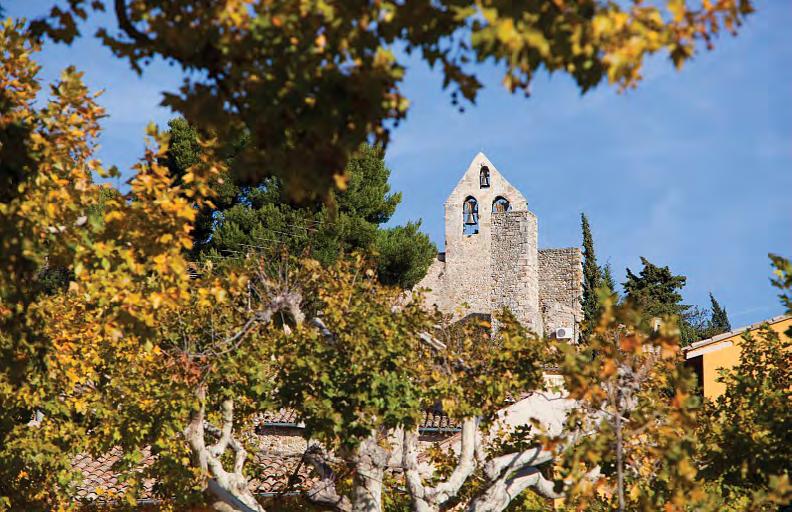
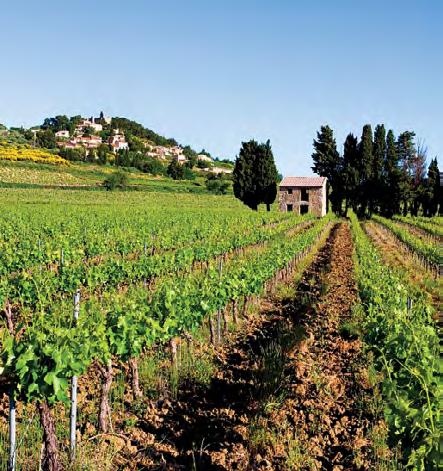
Organic and biodynamic certifications are widespread in both halves of the valley, but in the Southern Rhône, vineyards are helped in part by the Mistral’s drying effect. At the same time, producers are careful with alcohol and extraction to keep balance in warm years. And there are still historic sweet styles: Muscat de Beaumesde-Venise and the fortified wines of Rasteau remain part of the landscape, especially at dessert or with blue cheese.
In one of the Rhône’s most well-known regions, Châteauneuf-du-Pape, Grenache dominates the red wines, but both red and white wines are crafted from a long list of permitted varieties. Besides the galets roulés, sand and clay are common, shaping the style. Reds are full and spicy with savory notes, and whites have improved markedly
in texture and balance over the past decade. Base in Avignon for rail and road access. See the Palais des Papes and the Pont d’Avignon in the morning, then spend the afternoon in Châteauneuf-du-Pape.
Try: 2021 Château de Beaucastel Châteauneuf-du-Pape, Matt Walls of Decanter awarded it 96 points in 2022, and wrote it was, “deep, quite herbal… liquorice and crushed blueberries.”
Try: A biodynamic option, 2021 Domaine de Beaurenard, which received 96 points from Decanter.
The limestone and altitude at the base of the Dentelles de Montmirail bring freshness to the wine. From 2023, Gigondas may bottle whites (rule approved September 2022; whites must be at least 70 percent Clairette). Vacqueyras, next door, delivers similarly structured reds and often substantial value.
Try: 2022 Château de Saint Cosme Gigondas, awarded 94 points by JamesSuckling.com, writing, “Expressive notes of pomegranate and raspberry with lavender perfume.”
The Tavel region produces rosé only, although drier and deeper in color than in Provence. They work well with grilled foods, roasted poultry, and Mediterranean dishes.
Lirac & Laudun
Across the river from Châteauneuf-duPape, Lirac produces red, white, and rosé wines with a mix of soils and exposures.
Laudun, long a Côtes du Rhône Villages, was promoted to cru in September 2024 (first vintage 2024). It is notable for fresh, capable whites as well as balanced reds.
Cairanne
Elevated to cru in 2016. The reds keep Grenache’s generosity but rely on spice and lift rather than weight. It’s a dependable name for readers who want something beyond the usual headliners.
Rasteau & Beaumes-de-Venise
Not everything is dry table wine; two historic sweet styles still have a place, especially with cheese or dessert. Rasteau produces savory dry red wines and maintains a tradition of fortified wines, while Beaumes-de-Venise is best known for Muscat de Beaumes-de-Venise, with growing attention on dry reds from hillside vineyards.
Try: Domaine des Escaravailles (Rasteau). Its name comes from the Black Penitents who owned the farm in the 1600s.
When to go: Spring brings cool mornings and clear light; summer is busy and windy at times; autumn layers in harvest and markets; winter is quiet and better for more extended cellar visits.
Appointments: Book 60–90-minute tastings at smaller domaines and aim for weekdays— many reopen after a midday break.
Getting around: Tain-l’Hermitage/Tournon works as a northern base; Avignon for the south. Both are rail-friendly and centrally located near other AOCs.
Food pairings to seek out: In the north, try Syrah with charcuterie, grilled trout, and Picodon cheese; in the south, Grenacheled blends with daube provençale, lamb, and tapenade. For a non-wine break, Valrhona’s Cité du Chocolat sits a short walk from Tain station.
Where to stay: Avignon works well as a base for Châteauneuf-du-Pape, the Dentelles villages (Gigondas and Vacqueyras), and the right bank (Lirac, Laudun, Tavel). Autumn offers harvest activity and easier roads; winter brings truffles and more time with growers. Avignon’s Historic Centre (Papal Palace, Episcopal Ensemble, and Pont d’Avignon) is UNESCO-listed, and Orange’s Roman Theatre is an easy add-on.

Pairing chocolate with wine is a delicious way to explore the joys of the table.
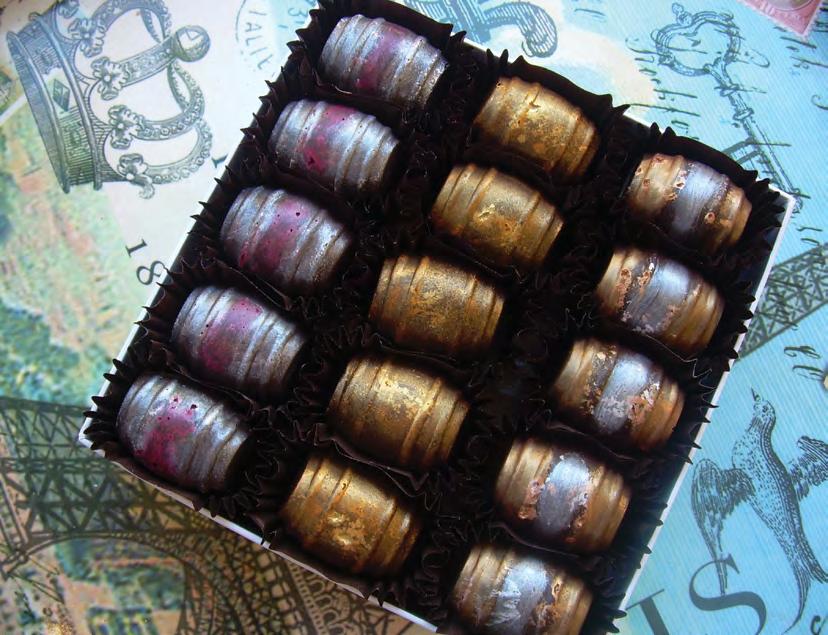
Chef and Chocolatier Holly Peterson has spent much of her career creating wine and food experiences— enriching life through every angle of the industry, raising money for charities at galas, teaching emerging culinary students and hospitality teams, and collaborating with wineries across the globe. Throughout the years, she says, “I’ve often been asked about wine and chocolate.”
Traditionally, if there was still red wine left in a glass after dinner and plain dark chocolate was served, sipping them together could be fun—and for many, downright delicious. “But was there more than just red wine and plain dark chocolate?” Peterson wondered.
Inspired by classic wine-and-food pairings, she began experimenting with flavor trials. She combined both familiar and exotic kitchen ingredients with chocolate, gathering feedback from willing tasters. “We’ve built quite a list of volunteers who love to explore food and wine,” she explains. “They’re enthusiasts rather than professionals, but honest and unbiased. No fudging allowed.”
The results, Peterson says, were not surprising: the quality of ingredients in chocolate is key. “As with many things, simple, pure ingredients tend to create the best results,” she explains. She likens it to a summer tomato garden—juicy tomatoes, fresh basil, a sprinkle of sea salt, olive oil, maybe garlic on crusty grilled bread. “Simple, real ingredients brought to life without overdoing it.”
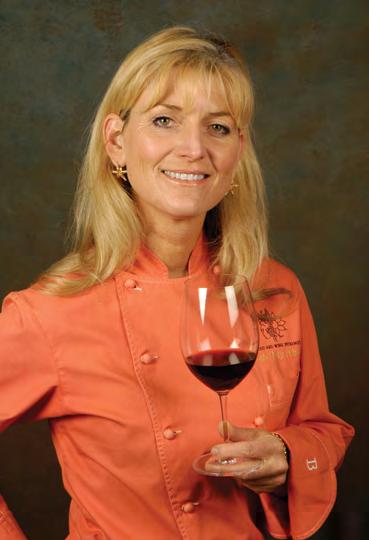
When it came to wine, nothing was off the table. Peterson and her tasters sampled reds, whites, rosés, and sparkling wines with chocolate combinations she designed. “What we found,” she notes, “is that fruit juices, spices, the type of base chocolate, even the type of organic cream we used, made chocolate and wine pairing not only possible but playful and engaging. Everyone smiled, was intrigued, and had fun tasting.”
“The success of chocolate-and-wine pairings,” she stresses, “depends heavily on the quality and type of chocolate.” This cannot be overshadowed by flashy fillings
or chocolate made with waxes, bitter preservatives, or sugary centers.
Peterson’s personal favorite is the ganache bonbon. These gained popularity as the simple truffle—made from chocolate and cream—not the misleading “creams,” which often contain no cream at all. She explains: “Ganache bonbons differ from truffles because they have a chocolate shell, making them more elegant and adding another layer of flavor and texture.”
Some sugar is always present in base chocolate, introduced during conching when cocoa beans are ground, fermented, and transformed from bitter nibs into a creamy treat. “This process brings out the chocolate’s natural flavors,” Peterson says. Sugar levels vary widely, but at her Flourish Chocolate company, she always chooses the lowest sugar, highest quality, and best flavor—using fair-trade chocolate.
Peterson offers these simple steps for experiencing chocolate and wine together:
1 2 3 4
Start with a sip of wine, letting the finish linger.
Take a bite of chocolate and savor its flavor.
Don’t rush. Once you’ve enjoyed the chocolate, return to the wine.
Voilà—that’s where the magic happens.
She adds, “We have success with white, milk, and dark chocolates for ganache, but all our shells are made with our Flourish Chocolate signature dark chocolate. It enhances each bonbon and creates a perfect bridge to wine and sparkling wine.”
Flourish Chocolate also crafts chocolates that either complement or contrast wine, often designing custom flavors for wineries seeking unique pairings for their wines and customers.
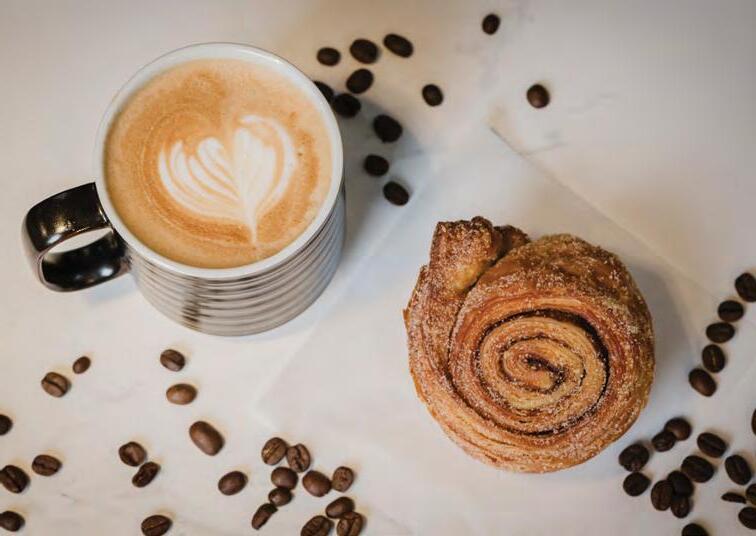
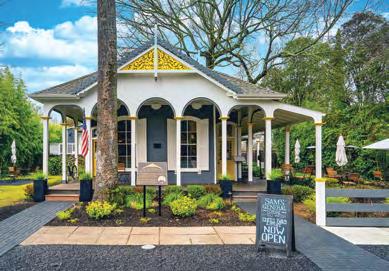
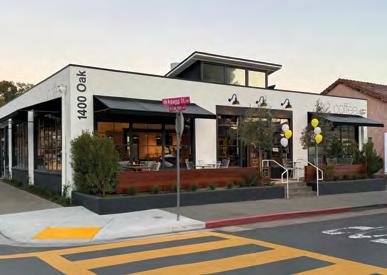
BY SUSAN L. RICHARDS | PHOTOS COURTESY OF SAM'S GENERAL STORE
Sam’s General Store is more than a café serving delicious coffee, tea, and artisanal baked goods—it is a historic landmark. Located in Calistoga, the shop is named for Samuel Brannan, who single-handedly started the California Gold Rush in 1849 with the headline “Gold, Gold, Gold” in his newspaper, The San Francisco California Star. It led to the arrival of hundreds of people in the Bay Area looking to strike it rich.
Recognizing that these “gold diggers” would need supplies and equipment to seek their fortune, Sam Brannan opened a general store inside Sutter’s Fort and promoted the Gold Rush. Sam bought up all the available pickaxes, pans, and shovels he could find and sold them at a premium, as it was the only store near the river where people were hunting for gold. He was so successful that he became California’s first millionaire within a year.
In 1852, Sam took his wealth and enterprising spirit to the hot springs of Calistoga, where he decided to establish a resort for the new rich and famous. In 1862 the resort opened, and the town of Calistoga was established.
Carl Dene arrived in Calistoga in 2018, ready to start a hotel and bring a high-end
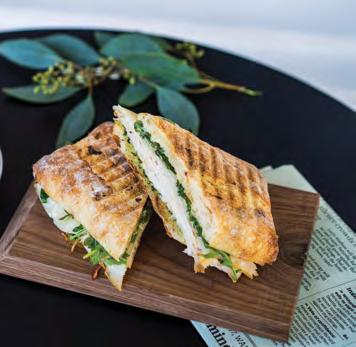
coffee café to town. He discovered and developed the last building standing on the original location of the resort into Brannan Cottage, a six-room luxury hotel, and decided it would be appropriate to name the adjoining café Sam’s General Store. Since opening in 2019, Sam’s has become a gathering place for tourists and locals. It offers an array of coffee and tea drinks, freshbaked pastries, made-to-go picnic baskets with salads or sandwiches, and gluten-free and vegan options. Patio seating provides beautiful views of the Calistoga hills and a wonderful way to start the day, enjoy lunch, or take an afternoon break outside.
In 2024 Carl decided to open a second Sam’s General Store in Saint Helena. This time, instead of historic architecture, he renovated the former Napa Valley Coffee Roasters building into a clean, comfortable café with a modern vibe, floor-to-ceiling glass windows, cozy chairs, booths, and the same customer-loved menu. It has already turned into an institution in the city, according to Carl, who said, “It’s become a community hub. From the time it opens in the morning, it buzzes inside, with everything from business meetings to real estate closings taking place.”
Both locations are focused on providing high-quality drinks and food that are inventive and delicious. Items like the ceremonial-grade iced strawberry matcha latte topped with strawberry cold foam and the gluten-free overnight oats—nutritiously packed with banana and chia seeds, yet delightfully decadent with a layer of peanut butter chocolate ganache and a sprinkle of cocoa nibs—set Sam’s General Store apart from the usual breakfast and lunch spot.
To learn more about either Sam’s location or to order online, visit their website.

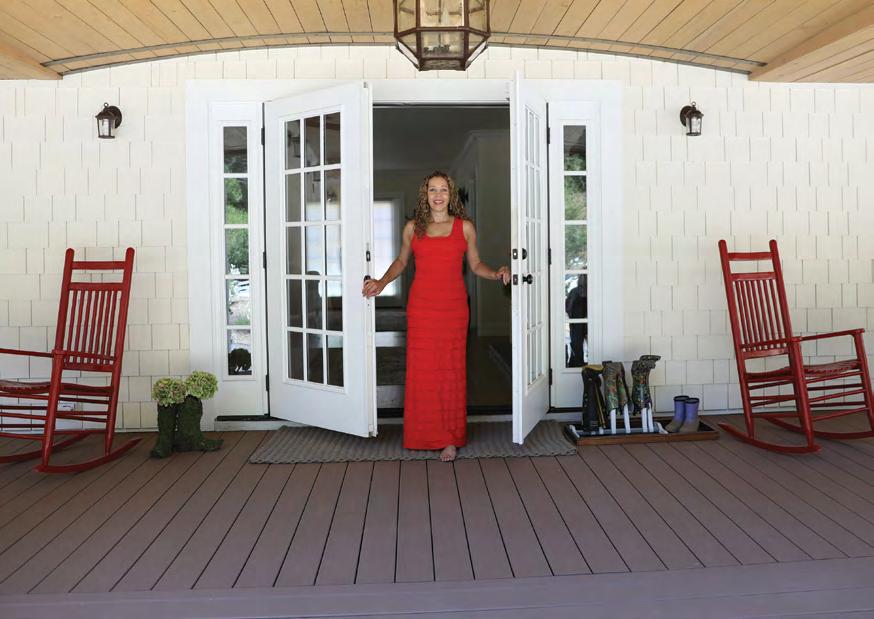
“My mission is to inspire, entertain, and have fun with you—while always setting you up for success.”
Karen Crouse
There’s something timeless about grilled cheese. It’s warm, familiar, and deeply comforting—the kind of food that wraps around you like your coziest sweater. In the early days of fall, when the air turns crisp and the garden begins to quiet, it’s exactly what I find myself craving.
In this kitchen, nothing is too simple for a little thought and heart. The bread is golden and crisp, the cheese melts into soft, stretchy layers, and every bite feels like a small indulgence.
This version brings together sharp white cheddar and creamy fontina on good sourdough, grilled low and slow with a blend of butter and mayo for that perfect, shattery crunch. It’s cozy and satisfying, with subtle layers that make each bite worth savoring.
Whether you’re making lunch after a morning in the garden or setting out a stack with a pot of tomato soup for friends, this is grilled cheese made the way I like to do everything—thoughtfully, simply, and with all the senses in mind. Let’s make it!
Makes 2 Sandwiches
INGREDIENTS:
• 4 slices good-quality sourdough
• 2 tbsp mayonnaise
• 1 tbsp softened unsalted butter
• 2 slices sharp white cheddar
• 2 slices fontina or gruyère
• 1 tsp grated Parmesan (optional)
TIP: Serving a crowd? Keep sandwiches warm on a wire rack in a 250°F oven.
INSTRUCTIONS:
1. In a small bowl, blend the butter and mayo. This creates the perfect flavorful, crisp, golden crust.
2. Spread the mixture evenly on the outside of each bread slice.
3. Layer the cheeses inside and press together gently.
4. Heat a skillet over medium-low. Cook the sandwich slowly—3–4 minutes per side, pressing lightly with a spatula—until the bread is crisp and golden and the cheese has melted.
5. Optional: Sprinkle Parmesan on the outside before grilling for a beautifully nutty, golden finish.
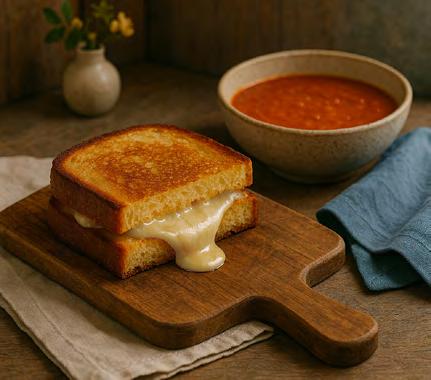
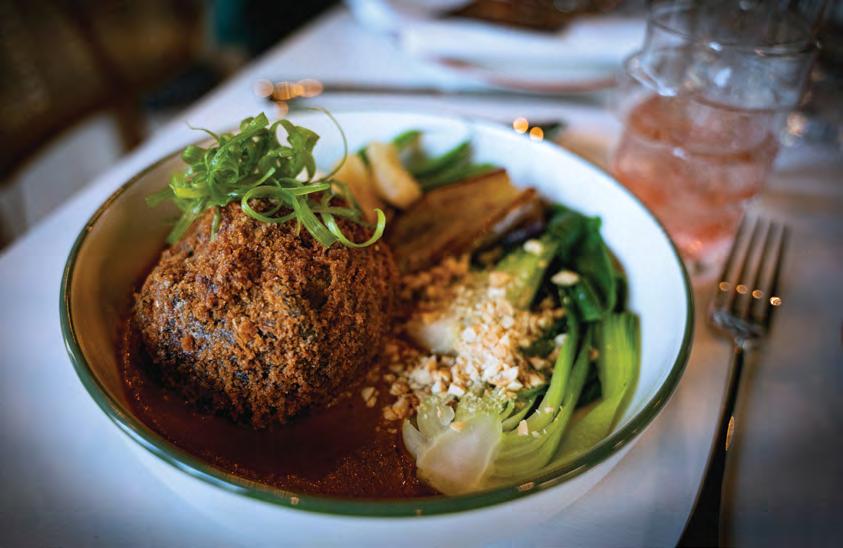
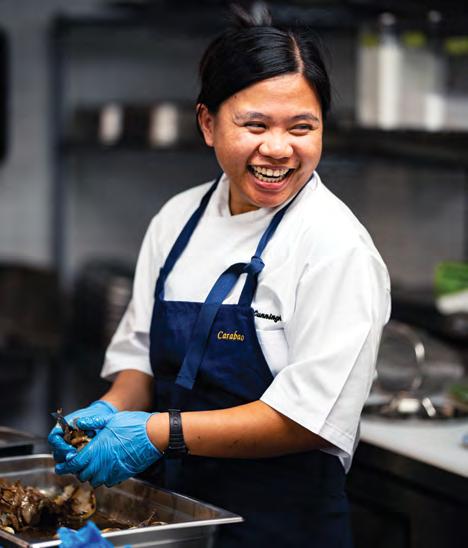
BY JILLIAN DARA | PHOTOS COURTESY OF CARABAO
There’s a brand-new restaurant in Napa Valley and for the first time in a long time, it’s not just new—it’s novel—as the venue is Napa’s first Filipino restaurant.
Carabao, translating to water buffalo in its native Filipino, debuted in June on Gasser Drive. Led by a trio of industry veterans, including Michelin-trained chef Jade Cunningham, Carabao embodies the strength, perseverance, and deep cultural identity of the national animal of the Philippines—qualities Jade witnessed firsthand as a little girl growing up in Bulacan, some 60 miles north of the country’s capital, Manila.
Jade founded Carabao in partnership with her husband Mathew Cunningham and Eric F. Gonzales to showcase a fusion of her two worlds: the Filipino cuisine she grew up with, refined by the techniques she learned during her time training at none other than The French Laundry. Even though she’s been cooking since she was six years old, it was at the famed Michelinstarred restaurant in Yountville where she truly honed her technique—working her way through all the chef de partie stations of canapés, garde manger, fish, entremet, grill, and meat—to ultimately be inspired to lead her own concept.
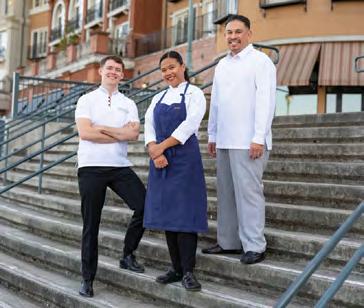
Carabao began as a series of dinner pop-ups, serving everything from à la carte menus to kamayan dinners (Filipino-style feasts eaten with the hands) and prix fixe plated dinners that regularly sold out. The current brick-and-mortar menu is quite different from the pop-ups, but the soul behind it remains the same—classic Filipino comfort dishes including kukutin, or small bites; inihaw, grilled meats; sizzling sisig (crispy pork belly with sweet onions and chili pepper); and pansit Palabok (pork and shrimp ragu with bihon noodles, bonito, and egg).
Throughout the evolution of Carabao, Mathew’s been by Jade’s side; the couple met while she was an intern at the Meritage Resort in 2019. At the time, Mathew was
working at The French Laundry (they later became co-workers) by way of humble beginnings in the wine and hospitality world that eventually became linear. He began as a server at Olive Garden before stints at Frog’s Leap Winery and PRESS Restaurant.
The son of Filipino immigrants, Eric F. Gonzales rounds out the trio’s leadership team. His technical position is lead investor; however, Mathew recognizes that he’s so much more than that—he’s worked on the floor with Jade and Mathew since Carabao opened and was actively involved in business planning, guest experience, and community building. Gonzales was attracted to the project not only because of his family heritage but also due to his philosophy of empowering Napa’s vibrant local and cultural landscape. This commitment extends beyond hospitality, as he serves on the board of trustees at Justin-Siena High School, where he established the Diversity & Inclusion Scholarship Program to mentor students of diverse backgrounds.
On paper and in person, the trio are a perfect match as they band together to celebrate their individual stories—as well as those of their community—all through the flavors and cultures of Filipino cuisine.
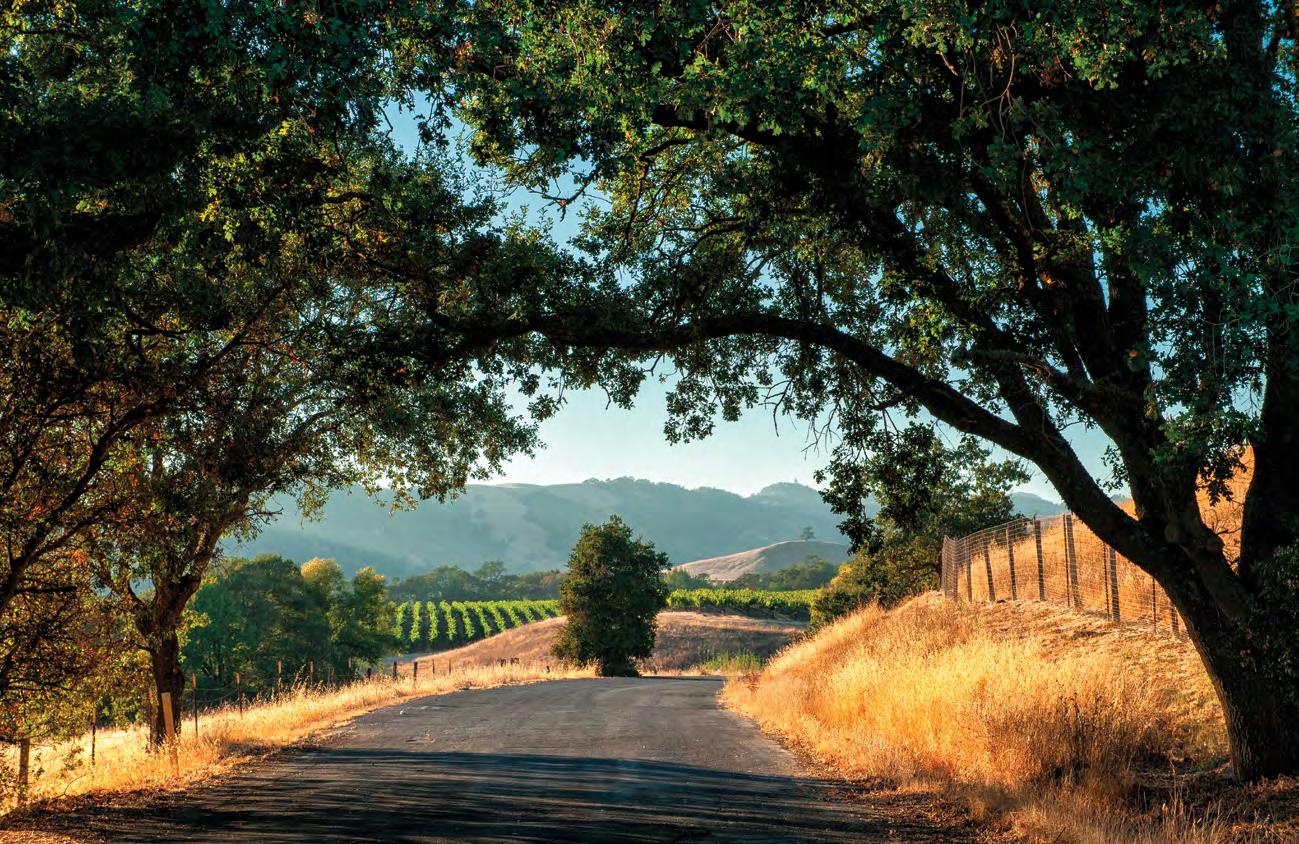
For those searching for a short, scenic drive in a less-traveled part of Sonoma County, consider the Bohemian Highway—ten miles of two-lane road linking Freestone, Occidental, and Monte Rio through redwoods, pastures, and pockets of vineyards.
The Bohemian Highway, once an enclave for artists and musicians, connects these towns, each with its own unique style of laid-back creativity, small-town charm, and nature escapes. The road’s name also has a local anchor: Monte Rio’s Bohemian Grove, the private redwood retreat of San Francisco’s Bohemian Club since the late 1800s.
It’s an easy drive to do fast, but a better one to do slow. Pull over for bread, a farmstand, or a tasting room. Walk a minute under the redwoods, then get back in, put the windows down, and keep following the curve of the road until the light shifts and the blue sky opens.
Start at the southernmost town, Freestone, to stroll through front-porch shops, travel to Occidental for its artisan flair, drive through forested bends, and then finish in Monte Rio, where the pavement meets the Russian River for a playtime experience. If you’re coast-bound, State Route 116 picks up the river’s line and carries it to Jenner and the Pacific.
For those who haven’t experienced it yet, traveling the ten miles of twisting roads on the Bohemian Highway offers a unique blend of scenic beauty and local charm.
Freestone is tiny, yet it was named Sonoma County’s first designated historic district in 1974. With its short main street of 19thcentury buildings situated at the southern end of the Bohemian Highway, it allows visitors to park once and cover the essentials on foot.
Freestone isn’t just cute; it’s also a gateway to one of California’s newest appellations. In 2022, the federal government approved the West Sonoma Coast AVA to distinguish this fog-soaked, ocean-cooled pocket of terroir from the much larger, more varied “Sonoma Coast.” That fog and marine airflow are why Pinot Noir and Chardonnay succeed here: slower ripening, bright acidity, detailed aromas.
To taste some of the Sonoma Coast goodness, try Black Kite Cellars’ Jasper House. Named for the black kite bird that can be seen flying overhead in the region, the winery specializes in cool-climate Pinot Noir and Chardonnay from coastal sites.
It’s a cult favorite winery for a reason—its premium, distinctive, small-lot Pinot Noir.
For food, Wild Flour Bread bakery is a must-stop. When you pass by, the first clue that something amazing is happening here is the line to get in. On any given day, it snakes along the porch out to the road, and the smell of baking bread keeps everyone in place. People drive from miles around to experience Wild Flour; it’s the type of place you don’t forget, and because it’s mainly known only to Sonoma County locals—the lucky ones—it feels like a secret pleasure.
Next door to the bakery scene, BlueGoat is a compact market specializing in local cheese, wine, and provisions, making it an ideal spot to build a picnic.
If your idea of relaxation involves heat, Osmosis Day Spa Sanctuary is three minutes up the road. It’s the only U.S. spa offering a cedar enzyme bath—a Japanese fermentation treatment that’s part science experiment, part relaxation.
Practical tips to make the day work: Wild Flour is open Fri–Mon and does sell out; lines move quickly. Black Kite’s Jasper House is appointment-only, so book ahead. BlueGoat is an efficient picnic stop and a good place to ask about what’s local that week. Osmosis requires reservations.
From Freestone, the Bohemian Highway bends north into the forest. This is slow wine country; it’s laid back and quiet—no limousines, no bridal parties—just in-theknow wine lovers enjoying the day.
OCCIDENTAL (population 1,132) : WINE, ART & PICNIC STOPS
From Freestone, the Bohemian Highway twists north, traveling in and out under redwood canopies along the way. Stop for lunch at Occidental Community Park, an unfussy picnic ground beneath oak and bay laurel. Unpack your Wild Flour bread and BlueGoat cheeses, slice into local charcuterie from Bohemian Market, and pour what’s left of that Black Kite Pinot Noir (responsibly, of course). It’s the kind of lunch that doesn’t need a tablecloth or menu.
Walk through Occidental today, and you’ll get a glimpse of what it once
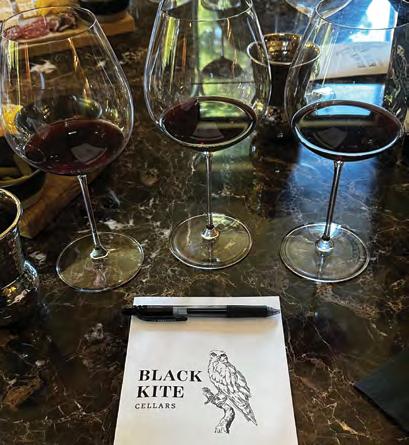
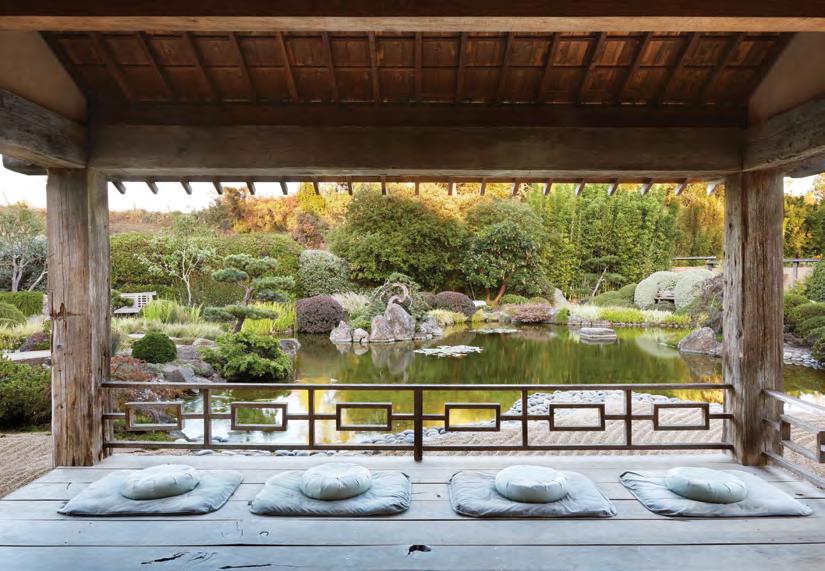
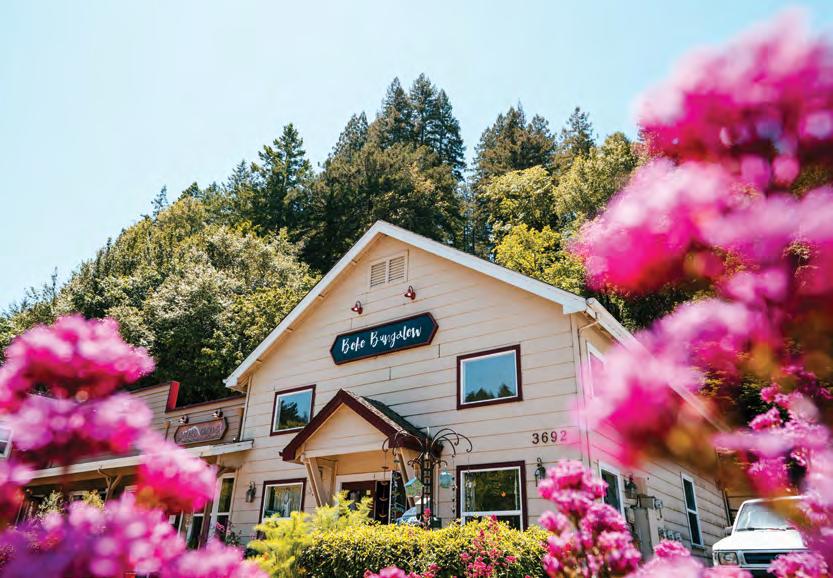

was—the galleries and performance halls represent a quiet refusal to let commercial gloss smooth the town’s edges.
Occidental is an artist’s town. If you’re feeling curious, pop into the Occidental Center for the Arts. This small-town gallery hosts exhibits, poetry readings, and occasional live sets by local musicians.
Boho shops spill pottery and woven baskets onto porches; murals peek out from alley walls. At Bohemian Bungalow, you can browse hand-carved cutting boards and glass jewelry made by local artisans.
Then there’s Hazel, the most lauded restaurant in the area. The menu changes with the seasons, with choices like roasted local carrots tossed with tahini or blistered pizzas cooked in the wood-fired oven. Pro tip: ask
for whatever pairs best with Sonoma Coast Pinot Noir. Sit on the patio if you can, and watch as locals and travelers drift past.
Two historic Italian institutions face each other. The Union Hotel has been serving since 1879; Negri’s dates back to 1943 and now offers a more intimate, barcentric service on weekends. You don’t come for flash—you come for red-sauce comfort and nostalgia.
If you’d rather walk before dinner, head to LandPaths’ Grove of Old Trees, a pocket of old-growth redwoods just outside town. The loop is short and quiet; parking is limited, so be respectful. It’s the simplest way to feel what the coast range does to your pulse. The Grove of Old Trees lot is tiny—go early or off-peak.
Before you leave Occidental, taste again—this time at Marimar Estate, just a short detour off the main road. Marimar Torres’ Spanish heritage is evident in the Albariño, which is as bright as sea spray, and in Pinot Noirs that have a distinctly coastal feel. On a good day, she’s there herself, talking about organic farming and laughing about Sonoma’s slow rhythm.
The final stretch of the Bohemian Highway dips back into the forest before opening onto the Russian River at Monte Rio. Here, the vibe softens even further.
For adventurers, try Sonoma Canopy Tours’ Tree Tops Course, offering breathtaking views of the majestic redwood forest from above.
MONTE RIO (population 1,080 ): WHERE THE RIVER MEETS THE SEA
Keep rolling and the road drops you at Monte Rio, where the Russian River widens. Monte Rio Community Beach is the largest public beach on the lower river; in summer, you’ll find kayak rentals, shady spots, and enough space for families to spread out. Kids splash in the shallows while kayakers glide past old wooden boathouses. Charlie Musselwhite, the iconic blues harmonica player, once said he could “hear blues in the water” here, and you’ll believe him when you sit on the sand, wine glass in hand, watching the sunlight dappling through the trees.
Golfers get an extra treat in Monte Rio: Northwood Golf Club, a nine-hole course designed in 1928 with Alister MacKenzie’s fingerprints on it, carved through secondgrowth redwoods. It’s casual, affordable, and very Sonoma—no pretense, just golf under trees surrounded by forest.
If you’re coast-bound after the river, Highway 116 follows the water to tiny seaside Jenner and the Pacific. That connection, and the morning fog pushing up from the ocean, are why these valleys read “cool climate” even in high summer. It’s the defining feature of Russian River and West Sonoma Coast fruit alike.
If the ocean is calling, keep driving west; follow the Russian River to where it flows into the Pacific Ocean. In the vast open expanse of sky and sea, hike the cliffs where the Pacific crashes against the rocks below.
While California boasts many wine roads, the Bohemian Highway stands out for its unpolished, soulful charm, offering a distinct experience compared to the polished Napa or foodie-chic Healdsburg. The wine is excellent—cool-climate Pinot, minerally Chardonnay—but it’s also inseparable from the setting. You taste salt air in the glass, smell forest floor in the barrel room. Even the bread, cheese, and charcuterie carry the stamp of this land.
Artists came here for that exact authenticity. In a world of curated experiences, the Bohemian Highway remains wonderfully uncurated. Zoom out, and the Bohemian Highway is defined by scale and pace: short distances, modest storefronts, quiet roads, and cool-climate wines that favor nuance over power. Eat, taste, walk, repeat. Then drive the last few miles to the ocean with the windows down.
BY LAYNE RANDOLPH | PHOTO COURTESY OF DE LOACH VINEYARDS
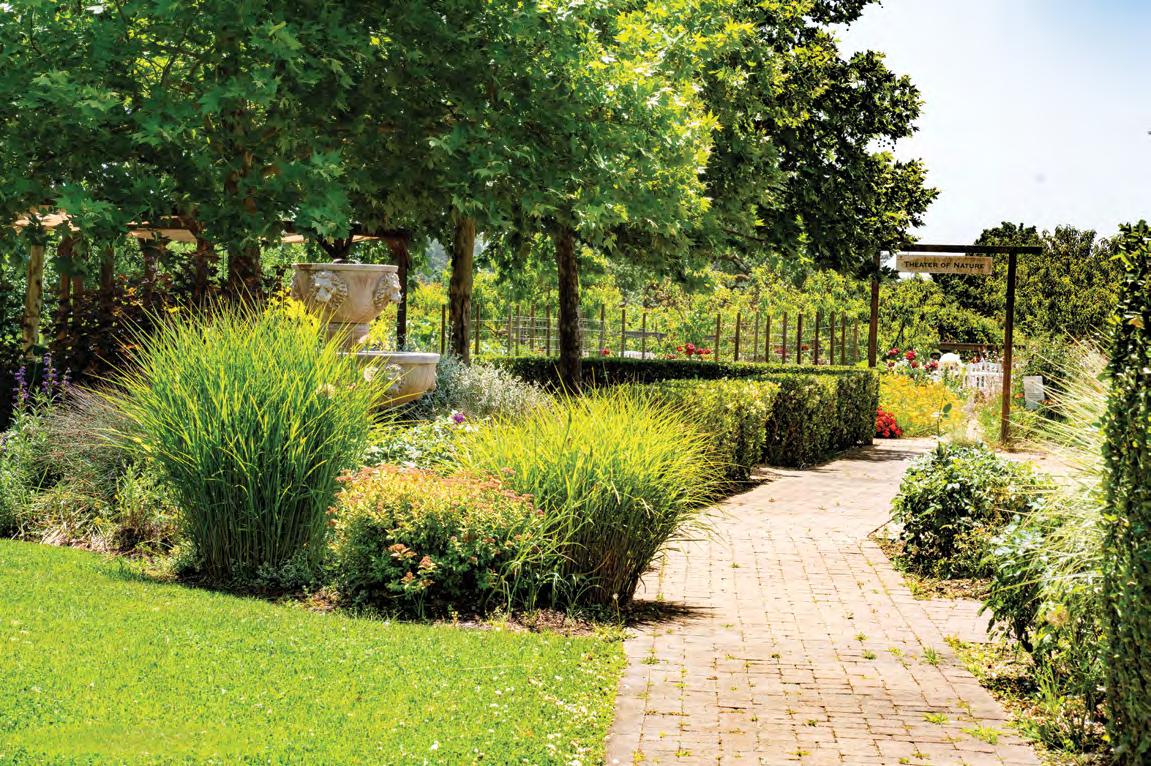
When Jean-Charles Boisset purchased DeLoach Vineyards in 2003, he replanted the estate’s vineyards and converted them to organic and biodynamic farming practices. It was a dramatic shift for a property founded in 1975 by Cecil and Christine DeLoach, who planted some of the Russian River’s first modern Pinot Noir vines. The couple were pioneers—early adopters of sustainable farming and among the founding members of the Sonoma County Winery Co-op.
Winemaker Brian Maloney was already on board when they sold the property to Boisset. “At the time, the soil was full of nematodes, which were spreading viruses and causing vine death. We plowed in safflower. Safflower has a taproot that’s really good for drying out the soil profile. We did this for about 18 months, introducing competitive microorganisms to keep the nematodes at bay. Over time, beneficial fungi would bind to the plant roots, and when nematodes tried to attack, they would hit the fungus instead, which would capture and feed on them.”
“Now, the vineyards have essentially developed an immune system. We’re not constantly fighting the same battles anymore.”
Site sustainability extends beyond the vines and soil: solar panels generate nearly 85 percent of the winery’s energy usage. All their water is captured, treated, and reused for irrigation. “One reason we can support large grapevines is because of these sustainability measures,” Maloney explained.
“In the gardens, we have butterfly bushes, sages, rosemary—plants that bloom year-round to provide habitat for beneficial insects. Whether in the Earth and Sky gardens at the front of the property or in the rear insectary, these plantings give predatory insects a place to settle, feed, and then return to the vineyard to handle pests like leafhoppers and mealybugs.”
Biodynamics has been a crucial component of their vineyard management. “We talk about lunar cycles, but I’m more responsive to the vineyard itself. Often, it aligns with the lunar cycle, but we must also respond to the weather. This year, it warmed up early, then cooled. Initially, we left the shade on the fruit; later, we removed the leaves to expose the clusters to light, wind, and air. This helps the fruit harden off, develop color and thicker skins, and protect itself from fungal disease. If we strictly followed lunar
cycles, the tasks would be the same, just timed differently. For me, lunar phases are a guideline, but the vineyard comes first.”
The payoff has been quality consistency in wines. Since the mid-2000s, DeLoach has been named on Wine & Spirits’ Top 100 list, and critics consistently praise its sitespecific Pinot Noirs. Add to that Boisset’s flair for hospitality—visible at his other properties, such as Raymond Vineyards in Napa—that has also shaped the DeLoach experience, though in a subtler, farmfocused way. DeLoach feels less like a polished tasting lounge and more like a functioning farm. Visitors can wander past grazing sheep and chicken coops, through rows of vegetables and herbs.
DeLoach celebrates its 50th anniversary in 2025, marking a milestone that reflects Boisset’s balance of heritage and innovation. It’s also an acknowledgment of DeLoach’s evolution and Sonoma County’s larger shift away from volume-driven production and toward site-specific, sustainable farming.
FOR MORE INFORMATION: www.deloachvineyards.com
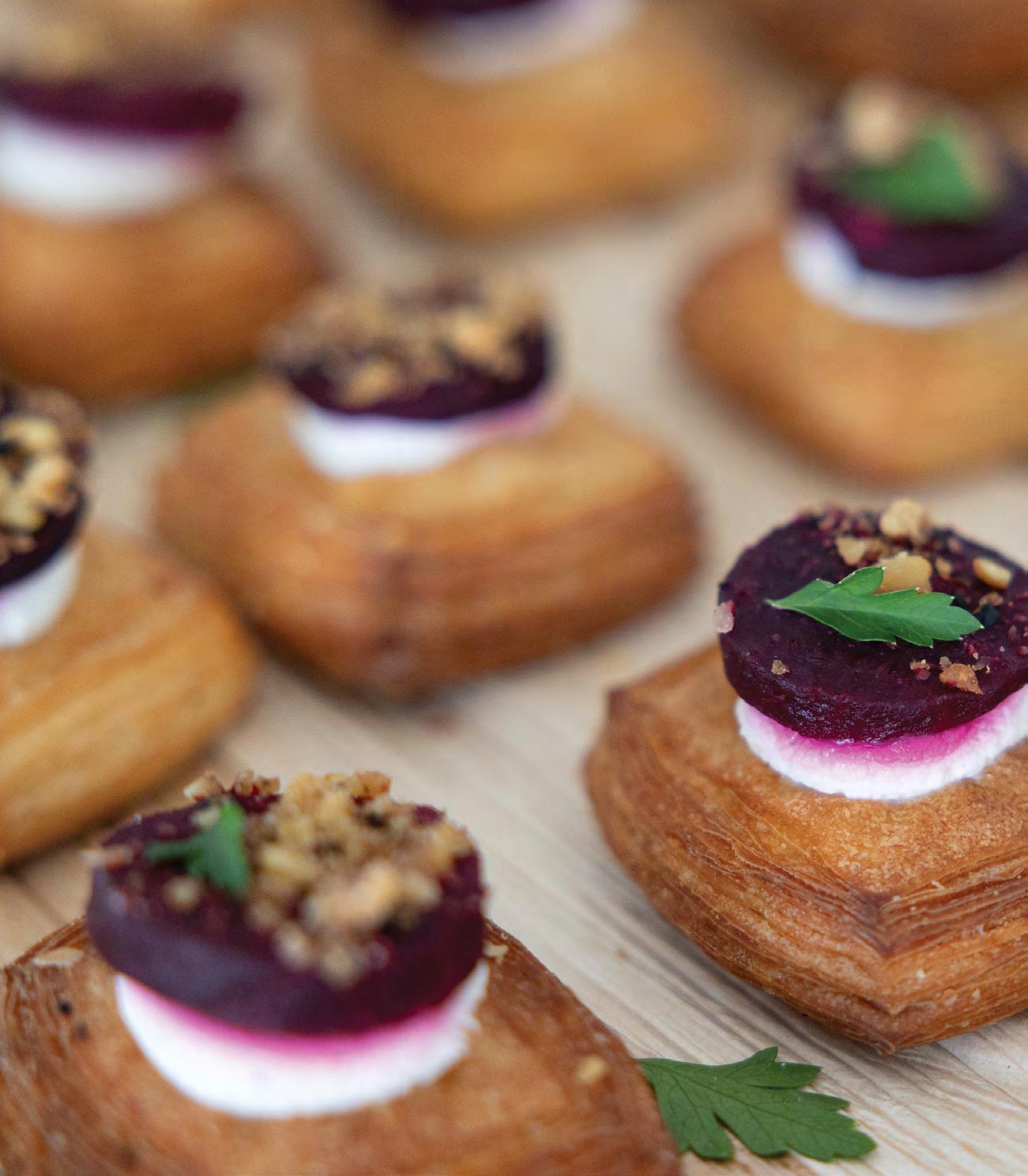
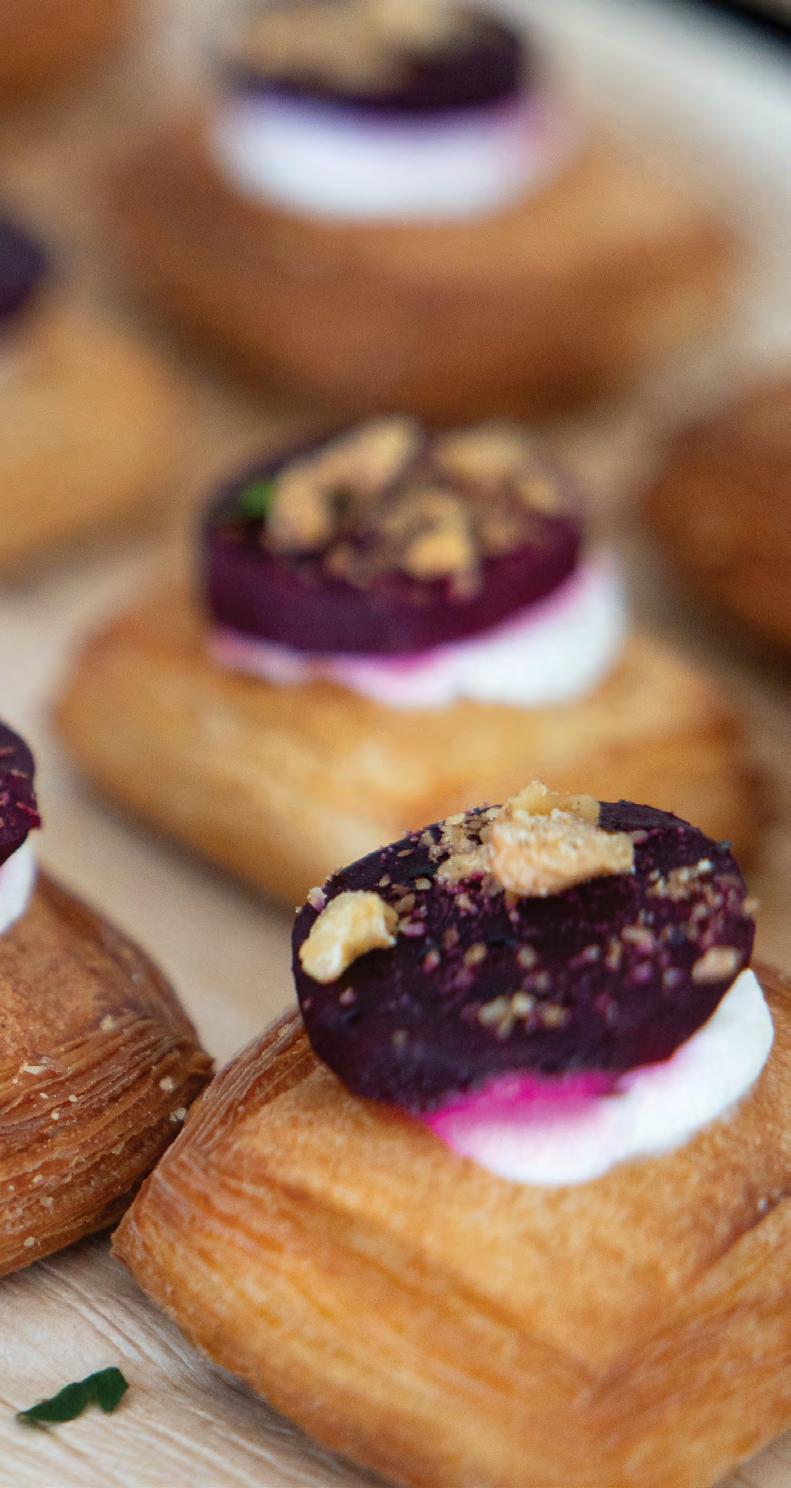
Four years in, the Healdsburg Wine & Food Experience (HWFE) has become a fixture for anyone tracking America’s food festivals. It marries Sonoma’s neighborly spirit with chefs and winemakers who bring ideas from far beyond the vines. Created in 2022 by industry veteran Steve Dveris and Karissa Kruse of Sonoma County Winegrowers, HWFE was built to celebrate the region’s agricultural backbone while positioning Healdsburg as a culinary destination with international pull.
The 2025 edition, held May 15–18, proved that vision true. The Grand Tasting at Vintners Plaza anchored HWFE 2025, drawing more than 150 wineries and chefs who blended global techniques with Sonoma sensibilities. Stephanie Izard served playful Asian flavors, Matt Horn smoked Texas-style barbecue with California wine pairings, and Maneet Chauhan brought spice-driven plates to the party.
Attendance is intentionally capped at approximately 2,000, keeping the event intimate. Guests are more likely to trade vineyard stories with a winemaker than fight for a pour. It’s the kind of festival where someone might hand you a glass of their own Pinot Noir and tell you exactly which farmer grew the grapes. While the Grand Tasting provided the spectacle, HWFE’s smaller events revealed its personality—intimate, surprising, and deeply tied to the people behind the food.
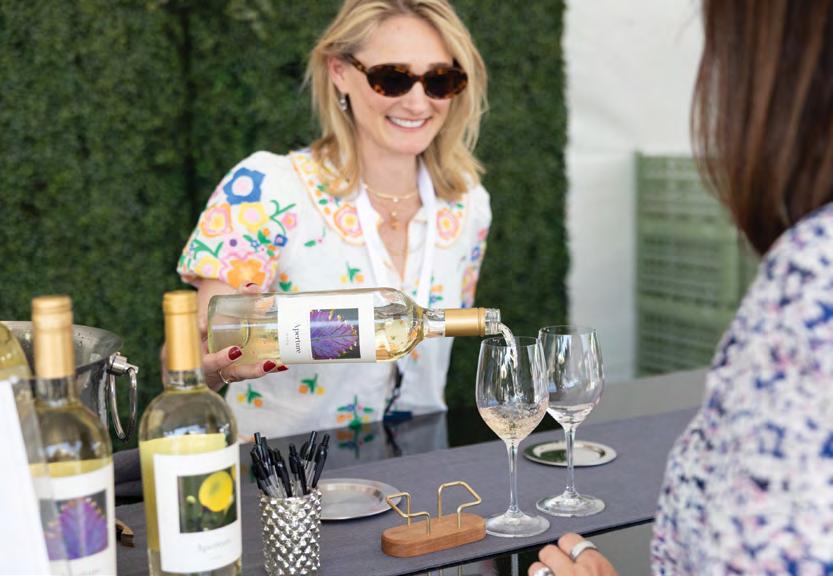
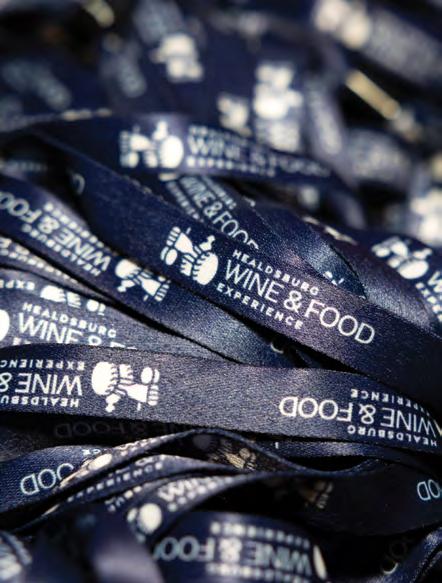
At Aperture Cellars, the Sushi by Scratch Omakase dinner paired the precision of Japanese sushi with Sonoma’s local wines, bringing out flavors that reflected the region’s surrounding hills. At Orsi Family Vineyards, Matt Horn’s West Coast Barbecue Lunch married Texas smoke and Southern tradition with California wines, proving barbecue belongs in wine country as comfortably as Pinot Noir.
Chef Michael Reed’s “Shifting the Lens” series at J Vineyards dug even deeper,
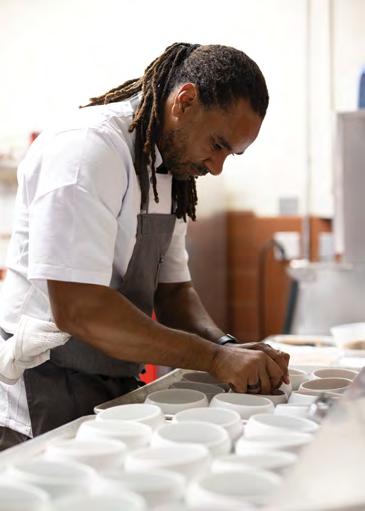
exploring Black Southern foodways through a California lens. Reed, a Food Network star and James Beard Best Chef West nominee, curated the dining journey. Each dish was paired with sparkling or still wines, turning the dinner into a conversation about how culture travels—and evolves—through food.
“Our goal is to celebrate the talented makers, honor our agricultural roots, embrace culinary diversity, and promote sustainability, all while pairing local talent with top chefs from across the country,” exclaimed Steve Dveris, founder and CEO of the festival.
Local talent kept the tasting grounded. Local chefs Domenica Catelli, Duskie
Estes, and Tracey Shepos Cenami created dishes sourced from neighbors they’ve worked with for years. The result felt closer to a neighborhood gathering than a polished showcase—a reminder that even at its most high-profile, this is still a festival about Sonoma.
Platinum VIP Weekend Package holders were treated to two exclusive events: lunch at MacMurray Estate with Ravenswood Winery and Chef Michael Reed alongside winemaker Michael Eddy-Cort and Sommelier Amanda McCrossin; and the Platinum Dinner at Chalk Hill Estate, spotlighting an unmatched culinary experience with renowned chefs Maneet Chauhan, Antonia Lofaso, and Crista Luedtke, alongside local talents Craig Wilmer, Executive Chef of The Restaurant at Farmhouse
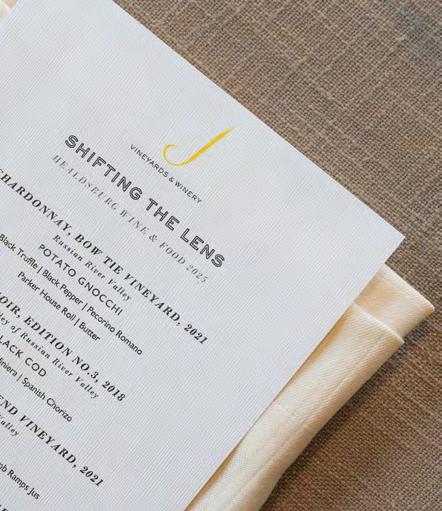
Inn; David Lawrence, Executive Chef of Goodnight’s Prime Steak + Spirits; and Eric Piacentine, Executive Chef of MacArthur Place Hotel & Spa.
But the real heartbeat of the event was in its stories, told best through people who know the region like family.
One of the best examples of hometown pride is Dustin Valette, a fourth-generation Healdsburg native and Michelin-trained chef. His presence—part host, part chef, part storyteller—captured what HWFE does best: making the most ambitious
flavors feel rooted in the local farms and people behind them.
Dustin Valette has done as much as anyone to define how Healdsburg eats today. He grew up surrounded by farmers and bakers—his grandfather owned the former bakery that is now his French-focused Valette Restaurant on Healdsburg’s square. He credits local growers with shaping his understanding of ingredients long before he entered culinary school.
He sharpened his craft at the Culinary Institute of America and worked in Michelin-starred kitchens like Aqua in San Francisco, Bouchon in Napa, and Hōkō’s in Honolulu. But Healdsburg eventually pulled him home. In 2015, he and his brother, Aaron Garzini, opened Valette,
The festival wasn’t just about food. A Friday night concert at Rodney Strong Vineyards, headlined by R&B star Allen Stone, had guests dancing before the last plates were cleared.
For those seeking a more cerebral moment, the “Lifelong Leaders of Terroir” panel brought together wine veterans like Bruce Phillips and David Ramey, who shared rare insights into the vineyard sites that have shaped California’s wine identity.
By Sunday, HWFE shifted into an easygoing mood at the Montage Wine-Down Pool Party. Guests played croquet, lounged in the sun, and sipped chilled rosé—a reminder that, even at its most glamorous, Sonoma doesn’t take itself too seriously.
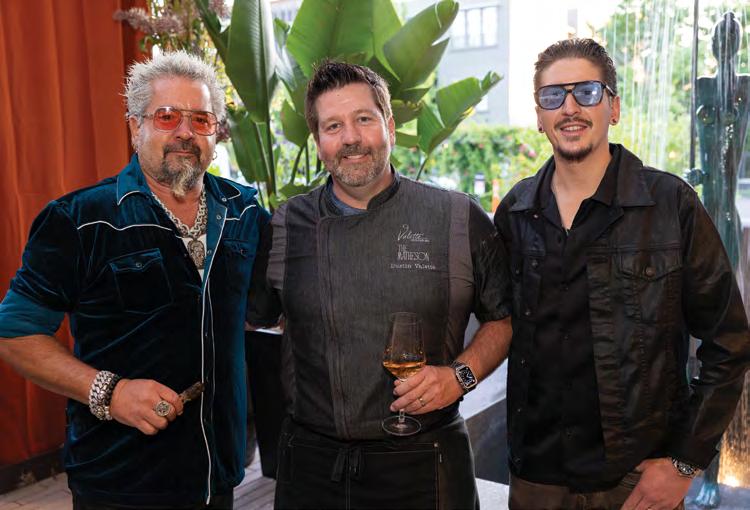
designed to showcase Sonoma’s winemakers, farmers, and artisans. Six years later, his restaurant The Matheson, on the other side of the plaza—a three-level space with rooftop views and a wine wall lined with local labels—made him as well known for championing farmers as for his cooking.
At The Matheson’s Reserve Lounge Rooftop, Valette poured rare wines beside his tasting bites in a setting that felt more like a chef’s private dinner party than a festival event.
That night’s Big Bottle Party, co-hosted by Guy Fieri, slid into late-night revelry with large-format pours and a rooftop dance floor. For many, Valette is the unofficial guide to Sonoma.
HWFE does more than showcase Healdsburg and share its bounty. Proceeds from the 2025 festival supported the Sonoma County Grape Growers Foundation, Healdsburg’s Future Farmers of America chapter, and Farm to Pantry, which collects fresh produce for food-insecure families.
HWFE returns May 14–17, 2026. The festival adds new layers each year, but its spirit remains constant—generous, rooted, and driven by the growers, winemakers, and chefs who give Sonoma its particular charm.
FOR MORE INFORMATION
www.healdsburgwineandfood.com
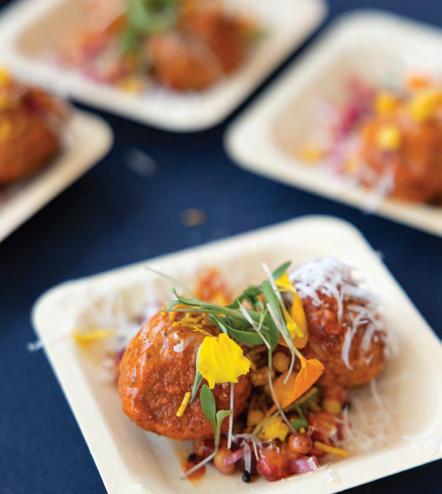
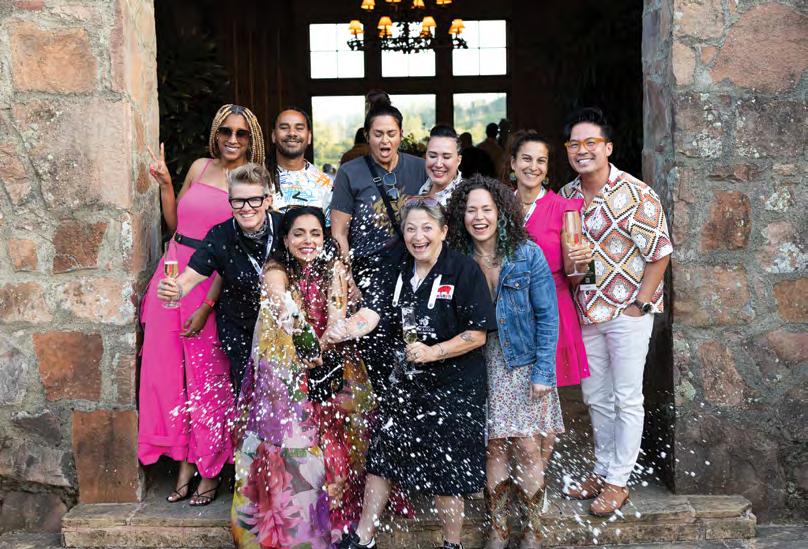
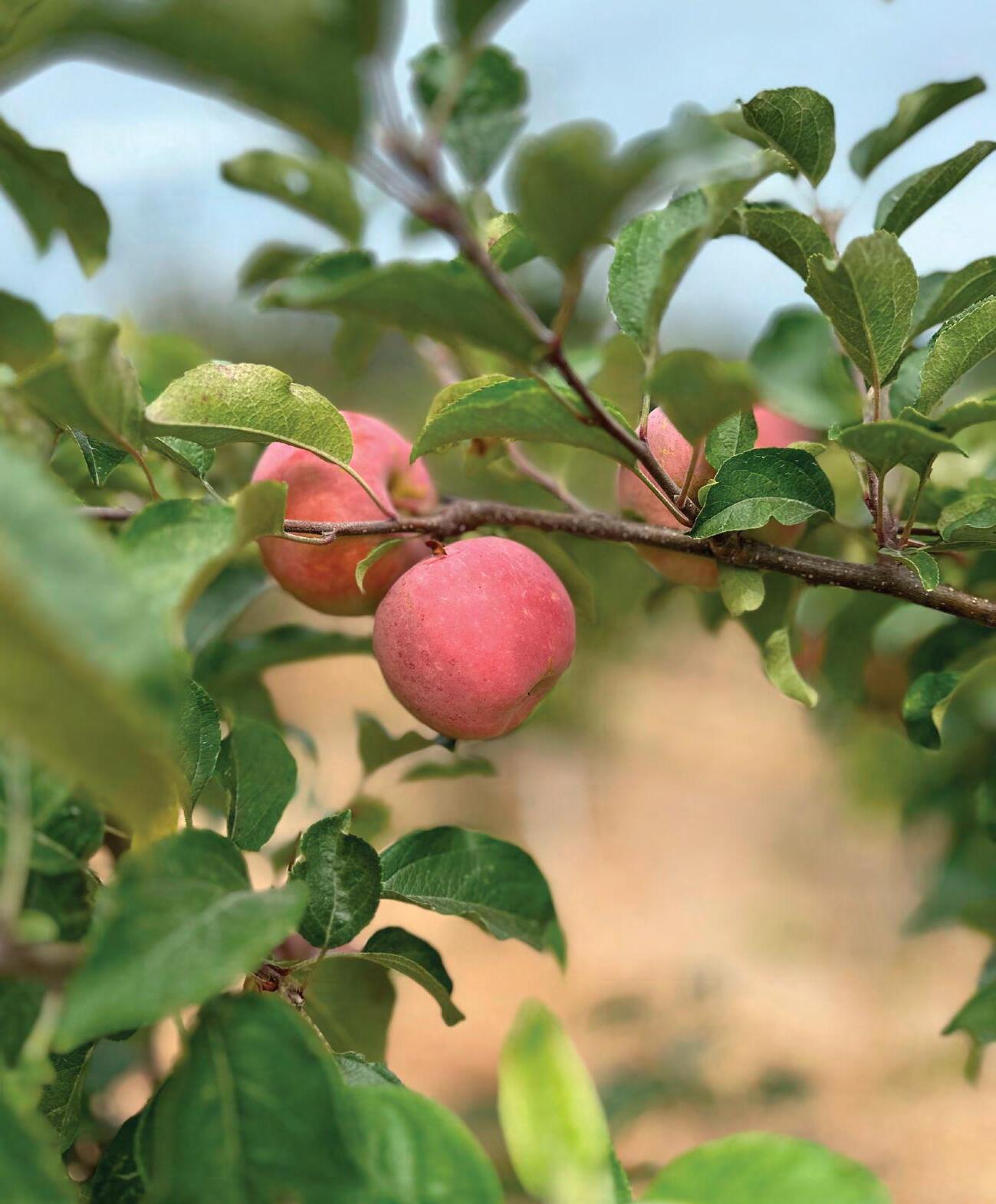
For most visitors, Sonoma County is synonymous with wine. But long before Sonoma became a wine country destination, it was fruit country. Orchards stretched across hills and valleys, bearing prunes, apples, peaches, and pears. By the early 1900s, Sebastopol was known as the “Gravenstein Capital of the World,” exporting crisp, tart apples nationwide.
The Gravenstein—thin-skinned and tart—is believed to have arrived with Russian settlers at Fort Ross in the 1810s and spread inland over the next century. Today, the Gravenstein Apple Fair—founded by Sonoma County Farm Trails in 1973—still fills Ragle Ranch Park each August with orchardists, cidermakers, bakers, and bands.
Luther Burbank arrived in Santa Rosa in 1875 and turned Sonoma into his laboratory, breeding for flavor, resilience, and yield. Over a career that made him a national figure, he introduced more than 800 plant varieties—among them the Santa Rosa plum and experimental hybrids like the plumcot— crossbreeding thousands of plants in search of better flavor, disease resistance, and productivity. His legacy is tangible at the Luther Burbank Home & Gardens in Santa Rosa and the Experiment Farm in Sebastopol, where test orchards still grow.
Wine’s rise in the 1960s and 1970s transformed the landscape, and as California wine gained international attention, Sonoma’s open land became increasingly valuable when planted with grapevines. Meanwhile, the orchard map shrank. In the booming 1940s, nearly 15,000 acres of county land were planted with apples; by 2016, about 2,200 remained. But today might be a new moment for Sonoma, as there’s a renewed interest in activities for tourists and locals that celebrate the full picture of agriculture in the region.
Sonoma County Farm Trails was established with the mission of keeping farms viable by attracting visitors. They achieved this through practical means, mapping out the county’s producers and inviting the public at key moments—such as blossom, peak harvest, and fall festivals. The nonprofit organization publishes a Map &
Guide, runs spring and fall open-farm weekends, and produces the Gravenstein Apple Fair each August—now in its 52nd year. These events are revenue and visibility engines that keep fields planted and crews employed while giving the public a fun experience with education and a taste of everything apple-related.
Two days in August, the Gravenstein Apple Fair compresses the county’s working fruit culture into one park. If you want a day that sums up the county’s orchard DNA, it’s the Gravenstein Apple Fair. It’s Sonoma at ground level—the fair showcases local apple producers crafting a wide range of apple products, including cider, pies, pastries, juice, and syrup.
Gold Ridge Organic Farms boasts an idyllic landscape of fruit groves that roll toward the coastal hills. Founder Brooke Hazen planted these orchards at the turn of the century; today, the farm is certified organic and treats olive oil with the same respect that many reserve for Pinot Noir. In season, the farm shop opens for tastings and occasional orchard strolls; late summer brings fresh apples in a seated apple tasting led
by an in-house apple expert. Guests savor four peak-season heirlooms from the farm’s 75-plus varieties, each paired with local cheeses, apple cider syrup, and balsamic vinegar. Gold Ridge grows dozens of apple varieties and runs special apple weekends in late summer and early fall.
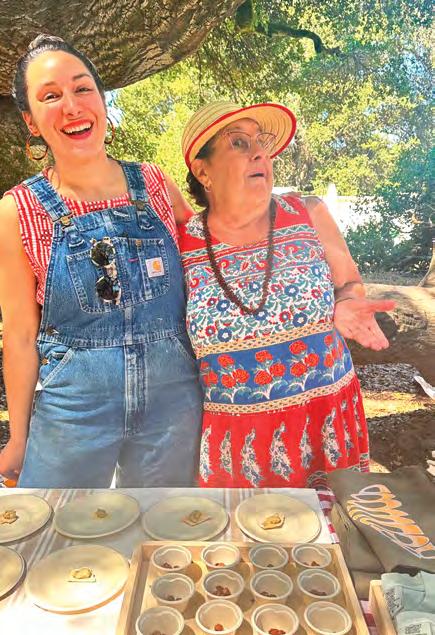
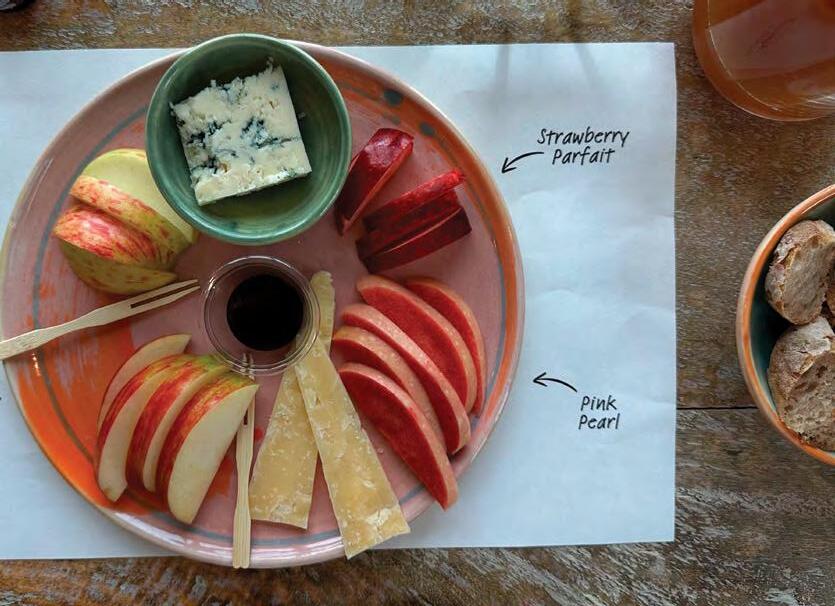
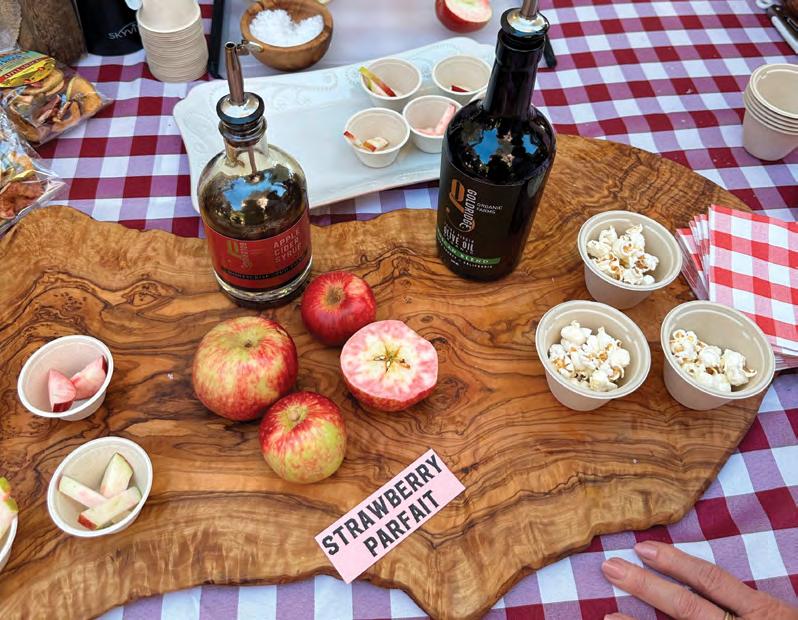
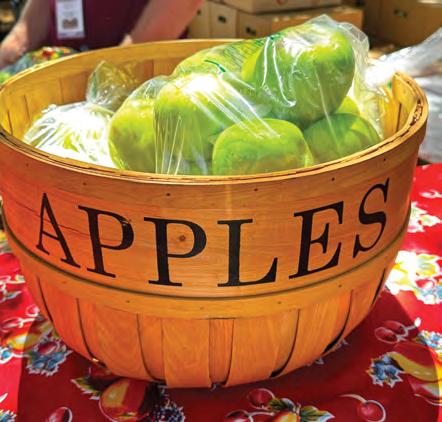
Dry Creek Peach & Produce, the last remaining peach orchard in Dry Creek Valley and the county’s only dedicated, certifiedorganic peach farm, has been around for over 100 years. Its tiny roadside stand opens in July and rarely stays stocked past lunchtime—it opens when fruit is ready and closes when it’s gone. Peak season runs roughly from Memorial Day to Labor Day.
Book a Saturday at Boring Farm, a certified-organic u-pick raspberry operation.
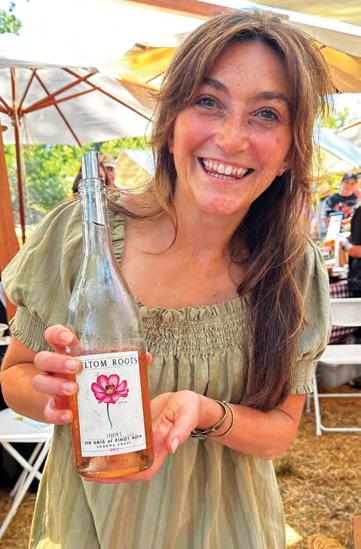
Family-friendly and simple: reserve a slot, pick, picnic. The u-pick season typically runs from June to September, with most Saturdays open to the public, although reservations are required.
Run by Santa Rosa Junior College, Shone Farm is both a classroom and a working farm: students steward orchards, berries, vineyards, gardens, and livestock, then invite the public in for seasonal u-pick days and an
annual Fall Festival. Expect summer berry and flower u-picks, and autumn pumpkins, apples, and sweet potatoes, plus a farm stand with produce and value-added goods. It’s an educational pipeline that also offers authentic farm experiences for visitors.
Overlooking the Russian River, this 110-acre organic farm mixes fruit and olive orchards with heirloom grains, rows of flowers, heritage vegetables, and vineyards. They host regular u-pick days— blackberries, tomatoes, flowers—alongside a market stand and occasional on-farm events. When open, you can wander the grounds, picnic by the river, and see diversified farming up close. It’s a model of ecology and craft that keeps fruit in the frame even in wine country.
Long before Sonoma became a wine country destination, it was fruit country. Orchards stretched across hills and valleys, bearing prunes, apples, peaches, and pears.
Farm Trails’ core idea—that producers survive when the public can actually find them—has never mattered more. Small farms live or die on direct sales and seasonal traffic. And when August rolls around, the Gravenstein Apple Fair gathers everyone—farmers, makers, musicians, and volunteers—under a canopy of West County shade to celebrate a heritage apple and provide proceeds that roll straight back to Farm Trails so the map, directory, and tours keep opening gates.
So, next time you’re in Sonoma, add a fruit farm to your itinerary. Especially for travelers who’ve done the wine circuit, fruit farms provide a slower, family-friendly way to taste Sonoma—make reservations where needed, and bring a basket and an appetite.


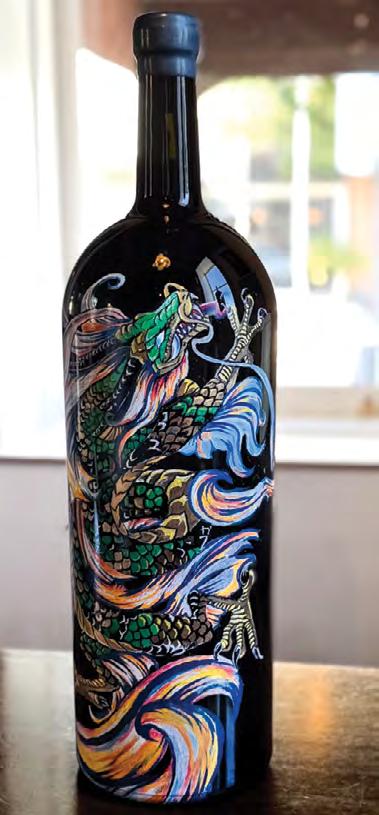
BY MELISSA VOGT | PHOTOS COURTESY OF
In Napa,
artist
Blake Barrios is merging art and winemaking like never before.
His brand, Rebellium, primarily aims to offer art collectors and wine connoisseurs the chance to support philanthropic efforts in both local and national communities. Often, the bottles are created for fundraising events that support those in need—spanning everything from adults with special needs to children with life-threatening illnesses to the elderly.
“There’s always a dark edge to everything I do,” says Barrios, referring to his one-ofa-kind, hand-drawn wine bottles, which double as wholly unique pieces of art.
Barrios grew up in Napa “as a visionary, with the eyes of an artist,” he says. That artistic proclivity, combined with Napa Valley living, led him to find synergy between the art and wine worlds. “I started to use glass as my canvas,” Barrios says. “I
was self-taught, and I had the attitude that there was always a way.”
Today, Barrios is sponsored by DecoColor, a brand that makes multi-purpose paint pens designed to adhere to glass. “DecoColor is the only thing that adheres to glass,” Barrios explains. This medium allows him to create distinctly original wine bottle artworks: “Every single one of them is a unique and individual art piece.”
Barrios hand-draws each bottle, which is custom-made for his clients. These range from personal commissions (such as bottles for weddings or those featuring family portraits), to private-label-style bottles for famous musicians, to bottles created for philanthropic purposes.
For the latter, Barrios is often inspired by “working with young artists,” he says. “Kids still have imaginations that adults don’t. The young artists are the visionaries, to me. It doesn’t matter if they’re 5 or 15 years old—they come up with wild ideas.”
One of Barrios’ favorite projects this year was working with Teen WILD (Wilderness Inspired Leadership & Development) at the local American Canyon Ecology Center.
He collaborated with 15 young students to paint a stunning piece called The Guardian, featuring an owl. “I am very passionate about youth and arts, and how it creates a sense of belonging and a place they can go.” The piece was auctioned off at the Evening at the Ruins fundraiser, and 100% of the proceeds went toward building the American Canyon Ecology Center. The center offers programs like Teen WILD—a year-long volunteer team that enables teens to:
• Complete 20+ community service hours at monthly scheduled events
• Develop leadership and mentoring skills
• Have fun outdoors
“The kids I try to inspire and mentor are what give me my drive to succeed as an artist, to have that higher power to set a good example for them,” Barrios says.
Barrios’ next project is a private design for CureDuchenne, a nonprofit organization devoted to finding a cure for muscular
dystrophy. Barrios will design and handpaint one wine bottle, which will accompany an entire barrel of wine (24 cases) to be auctioned. The highest bidder will take home both the hand-painted bottle and the 24 cases, with all proceeds going directly to CureDuchenne’s research efforts.
In addition to the unique artwork on each bottle, Barrios collaborates with renowned Napa winemaker Julien Fayard—known for his namesake brand Julien Fayard Wines and others like Covert Estate—to ensure the quality of the wine inside. “What’s in the bottle has to be just as beautiful as what’s on the outside,” Barrios says. “I expect the highest quality that winemakers can produce.”
From custom designs to projects with a higher purpose, Blake Barrios’ Rebellium bottles offer clients deeply personal, oneof-a-kind works of wine bottle art that are aesthetically striking, taste exceptional, and serve a purpose far greater than just a simple bottle of wine.
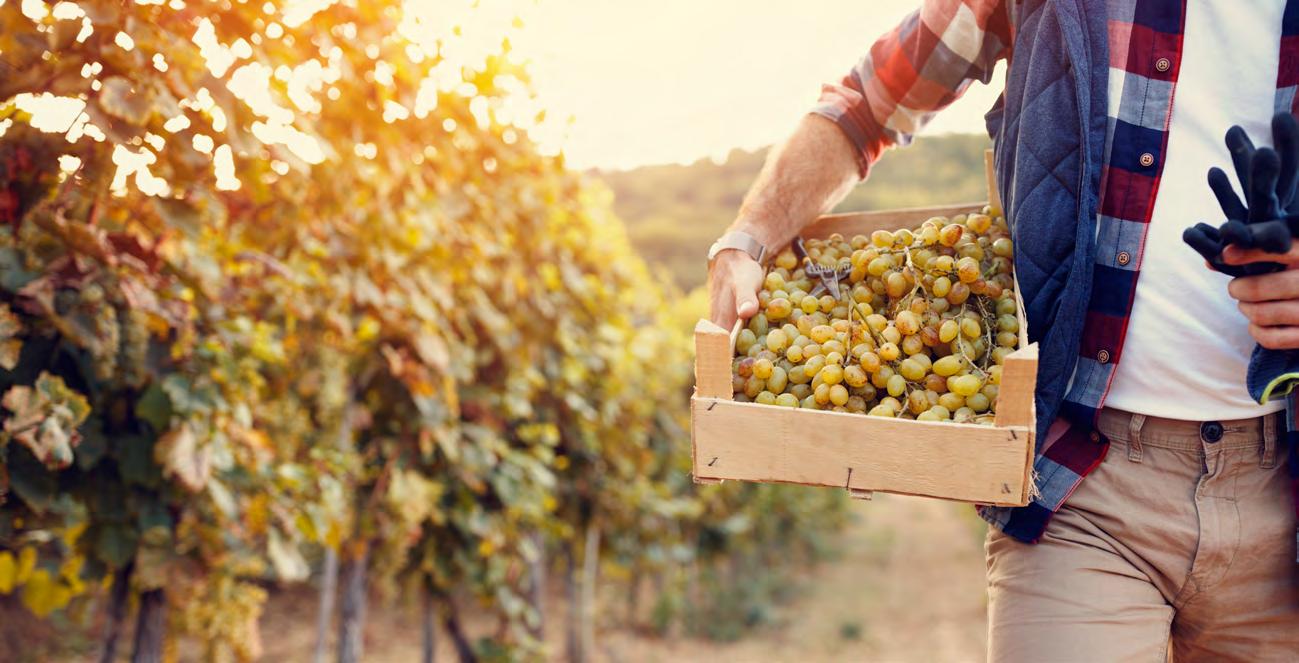
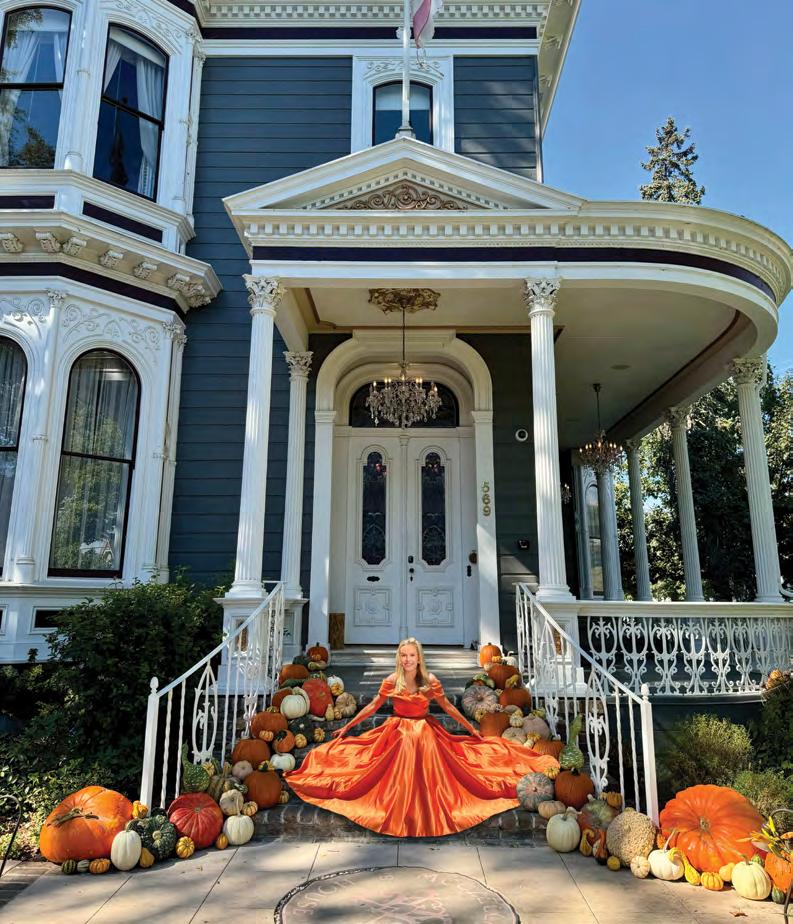
BY SUSAN L RICHARDS | PHOTO COURTESY OF PARKS PUMPKINS
There is nothing like pumpkins on the front porch or entryway that says “Happy Halloween” or “Happy Thanksgiving” in autumn. And no one better in Napa to create a beautiful pumpkin, gourd, and hay bale porch display than Allison Parks of Parks Pumpkins in Napa. As the owner of The Painted Lady Tanning and Spa, Allison is well known to the Napa
business community as an entrepreneur. In 2024, she decided to take her creative instinct and passion for all things fall and establish Parks Pumpkins, a concierge pumpkin porchscaping service that offers home and condo owners an easy and beautiful way to decorate for fall holidays and events.
Serving all of Napa County, Parks Pumpkins can create any theme desired, from
spooky Halloween to cozy Thanksgiving. Parks Pumpkins handles everything, including design, installation, and postThanksgiving cleanup. No porch is too big or small for a festive cornucopia of perfect pumpkins and gorgeous gourds! The team at Parks Pumpkins can turn any porch into a seasonal masterpiece.
Inspired by a similar service being marketed in the Southwest, Allison knew porch-scaping could work in Napa Valley. The first year of starting a new business is challenging and involves finding suppliers, marketing, and the work itself. To showcase her designs and have examples to share with customers, Allison did a few porches for free. Her first paying customer, Laurie Daw, saw one of her gorgeous displays and quickly hired Parks Pumpkins to design and install a Thanksgiving display at her home. Allison said, “I am forever grateful for Ms. Daw’s support and its impact on helping to launch the business”.
Parks Pumpkins offers three pumpkin porch-scaping packages, each customizable for the size and type of porch being decorated. Grand Autumn Elegance, $1200, includes two 400-pound Grand Prize Pumpkins flanking a bounty of brightly colored, miniature pumpkins and gourds flowing down steps or a walkway. For smaller homes or condos, the Petite Harvest, $350, is the perfect choice, offering creative placement of pumpkins and gourds around the entrance way.
Removal and disposal at the end of the season is also available for a fee. Parks Pumpkins will remove the pumpkins and ensure they are put to good use. They partner with Bleating Hearts Farm and Sanctuary in Napa, where the pumpkins are enjoyed as treats for the animals. It’s an eco-friendly way to wrap up the season, giving back to nature while leaving a clean space behind.
Parks Pumpkins operates from September through the day after Thanksgiving. To ensure an adequate supply of “materials” this season, Allison is contracting with local farmers and growing pumpkins behind the Painted Lady Spa. She plans to expand to a pumpkin patch in 2026.
Parks Pumpkins porch packages can be ordered online and installed within one to two days after ordering, which takes approximately an hour. To see pictures of Pumpkin Scaping displays and learn more, visit the Parks Pumpkins website.
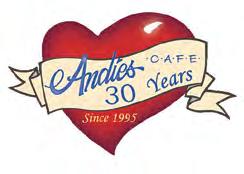
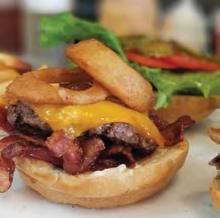
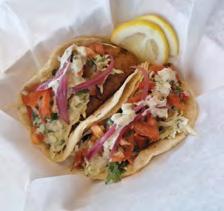
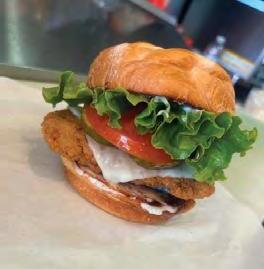
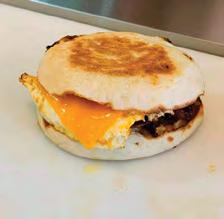


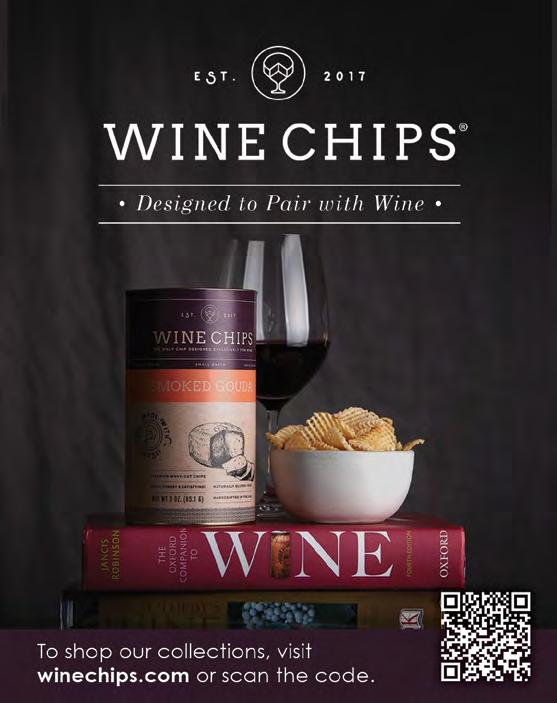
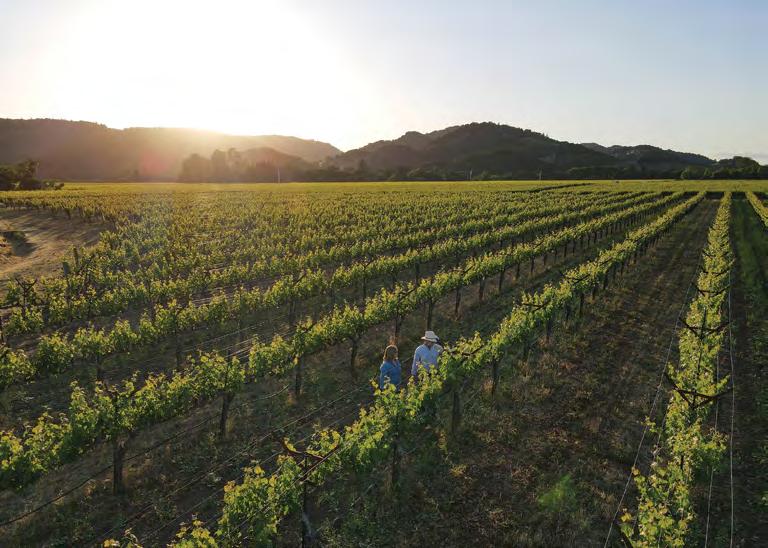
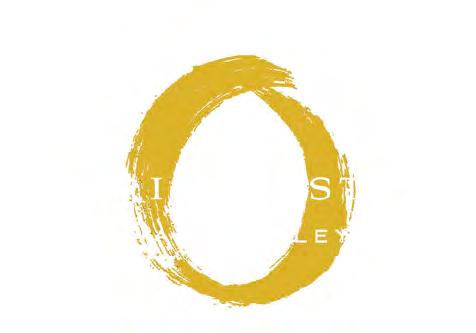
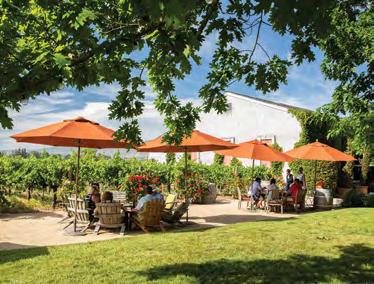
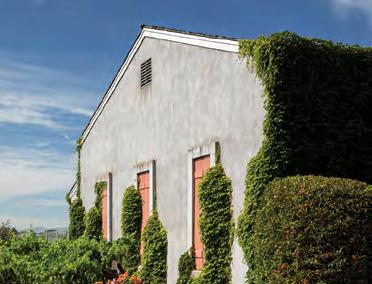
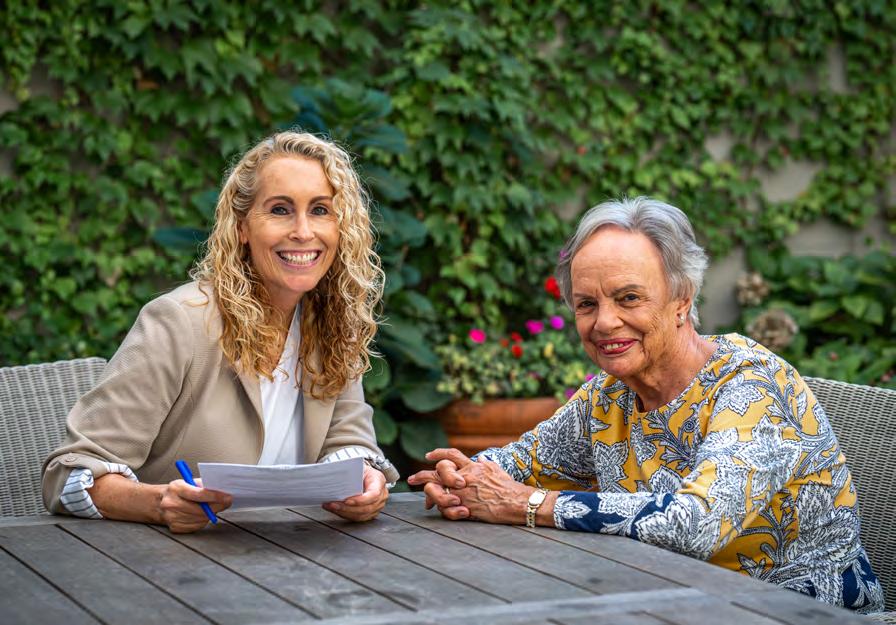
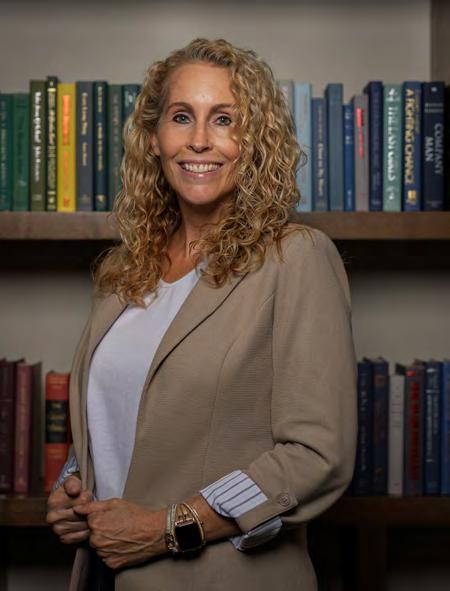
BY FRAN MILLER | PHOTOS BY WESLEY
STEFFENS COURTESY OF ALL 4 SENIORS
Napa Valley’s All 4 Seniors, founded by longtime elder-care professional Colleen Kabeary, has quietly become a trusted name in senior support. Kabeary offers a novel, highly personalized approach to senior placement and consulting—one rooted in deep experience, local expertise, and an unwavering commitment to helping older adults thrive.
Kabeary’s entire career has been dedicated to serving seniors. After more than three decades working across various levels of care—from skilled nursing to independent and assisted living—she saw a need for the type of one-on-one consulting she now provides through All 4 Seniors. She set out to create a more thoughtful, client-first model—one that blends local knowledge with lasting relationships.
Unlike national placement services that rely on broad algorithms and one-size-fitsall lists, Kabeary takes a hands-on approach. Having worked directly in several of Napa’s senior living communities, she brings a rare, insider-level understanding of how each facility operates—its strengths, quirks, staffing culture, and day-to-day realities. That firsthand knowledge allows her to offer honest, specific guidance tailored to each client’s medical, social, and financial needs.
Before recommending any communities, Kabeary takes time to get to know each
“I created All 4 Seniors to be the kind of resource I would want for my own loved ones: honest, experienced, and deeply human.”
–Colleen Kabeary
senior and their family. Her vetting process includes in-depth consultations, health assessments, and a review of lifestyle preferences to ensure her recommendations are not only viable—but the right fit. She arranges visits to communities that genuinely meet the client’s needs, personally accompanying them on tours. This curated approach saves families time and stress. It’s also one reason local senior housing communities welcome her involvement. They see her as a valuable ally—someone who educates families, manages expectations, and ensures a smoother transition for everyone involved.
But her role doesn’t end once a decision is made. Kabeary remains in close contact with clients and their families long after move-in—checking in, offering guidance, and serving as an ongoing resource.
Based in Napa and serving the surrounding counties, All 4 Seniors offers
consultations free of charge and without pressure—just expert insight delivered with compassion. For Kabeary, this work isn’t transactional—it’s deeply personal. She’s not just finding housing; she’s helping people navigate one of life’s most sensitive chapters with grace.
Kabeary, who serves as board vice president of Share the Care (a local nonprofit supporting the health and well-being of older adults), has quickly earned a strong reputation in the community. Clients frequently commend her compassionate, pressure-free approach and her ability to simplify a stressful process. Her services come at no cost to the families she helps, as placement fees are covered by the senior living communities with which she partners.
“After decades of watching families struggle through impersonal systems, I created All 4 Seniors to be the kind of resource I would want for my own loved ones: honest, experienced, and deeply human,” says Kabeary, who also sits on Napa County’s Commission on Aging and is a member of Sunrise Napa Rotary.
Thanks to her compassionate guidance, Napa’s seniors have a trusted advocate in Kabeary.








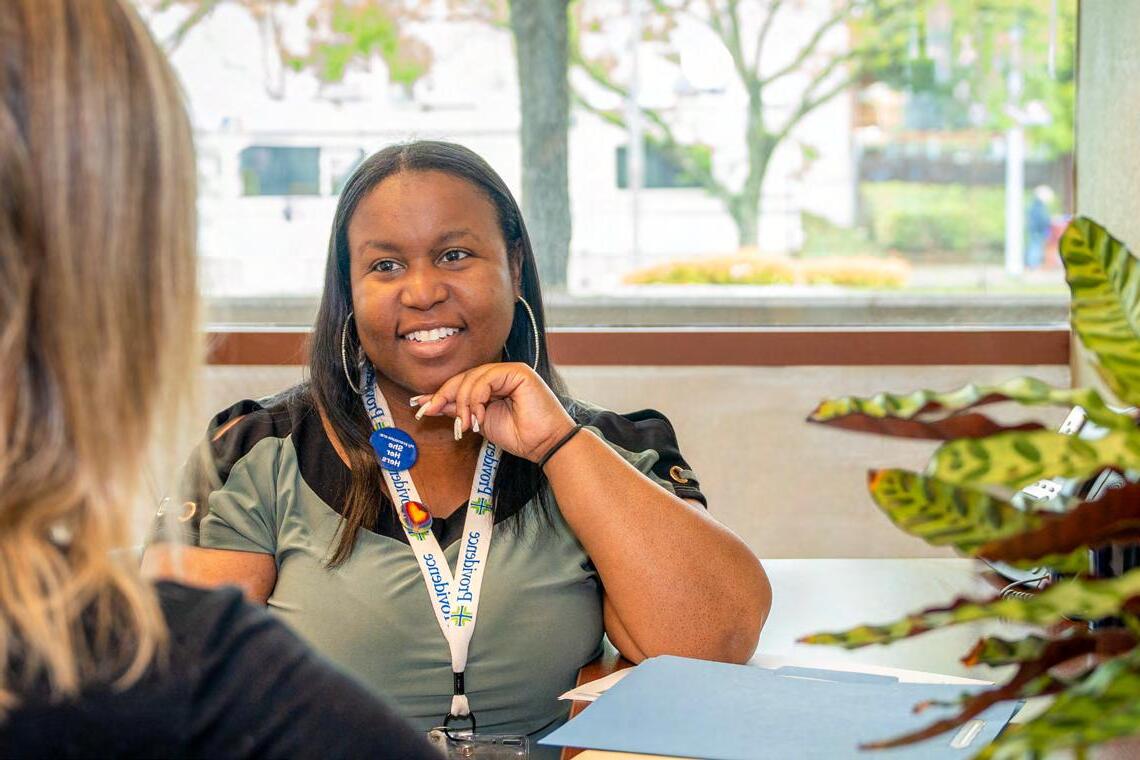
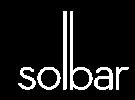
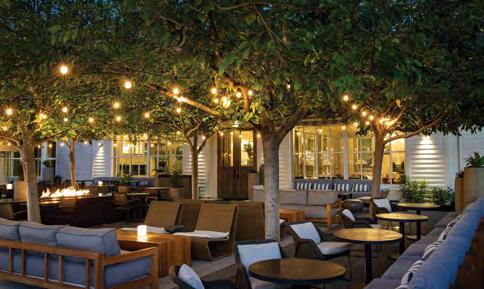
SOLBAR RESTAURANT Solbar divides its menu into light, delicate flavors to stimulate your palate and bold, savory dishes, all with ingredients that showcase the best of what’s fresh and seasonal in the Napa Valley. Enjoy outdoor dining on the sunlit Solbar patio, or the new Picobar, for dining al fresco or relaxing by the firepits overlooking the landmark pool.
755 SILVERADO TRL, CALISTOGA // 707- 226-0860 // AUBERGERESORTS.COM


HERITAGE EATS Heritage Eats offers a fast-casual, globally-inspired menu that thinks and acts locally. The popular restaurant serves up tacos, wraps, baos, rice and salad bowls made-to-order with choice of protein, toppings and sauces with unique flavor profiles from all over the world. The Dirty Fries, Papa K’s Burger and Haven Wings are local favorites.
3824 BEL AIRE PLAZA, NAPA // 707-226-3287 // WWW.HERITAGEEATS.COM


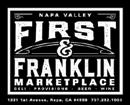
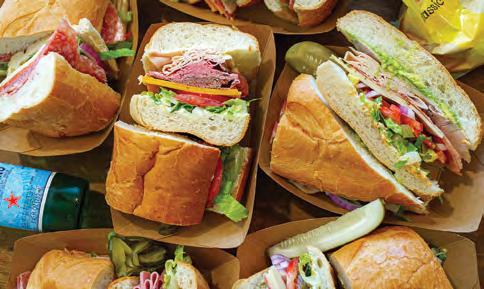
FIRST & FRANKLIN Downtown Napa’s newest Marketplace and Deli features the best of the Napa Valley. The Marketplace offers a full-service deli and a specialty Grocery Store selling local wine and craft beer. The store is filled with grab-and-go or made-to-order sandwiches, salads, and picnic side salads for you to take home or enjoy on either of their two patios.

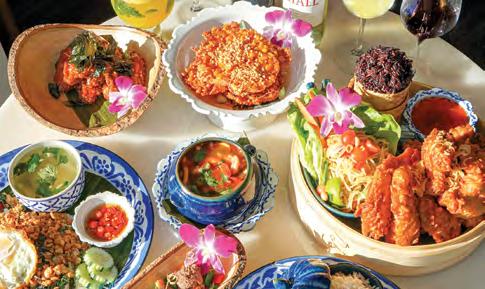
OSHA THAI Led by renowned Chef Lalita Souksamlane, the menu highlights her award-winning flavors and showcases dishes never before tasted at her other restaurants. Sourced with ingredients grown in her own personal garden and partnering with local vendors, Osha Thai provides an authentic farm-totable experience with quintessential wine country flair.
1142 MAIN STREET, NAPA // 707-253-8880 // WWW.OSHATHAI.COM/NAPA

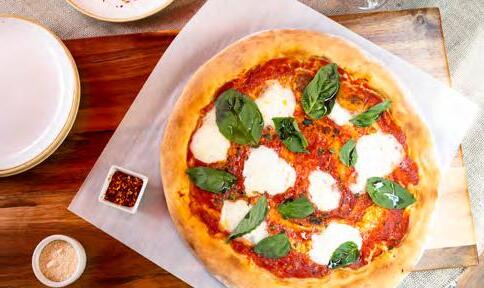
PIZZERIA TRA VIGNE For the past 25 years, Pizzeria Tra Vigne reigns one of St. Helena’s local treasures. Guests of all ages enjoy the pasta, pizza, or a fresh daily special to go at this vibrant, family restaurant. Their pizzas are a crowd favorite to eat in or carry out. There’s plenty of seating outdoors on the beautiful patio, complete with a bocce court, or inside with family and friends.
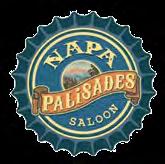
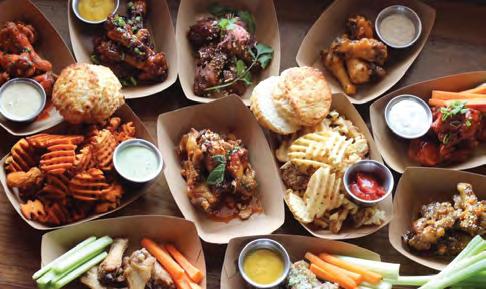
NAPA PALISADES SALOON Located in downtown Napa, Napa Palisades is a local gourmet grub pub serving American comfort food with a twist. Their full bar serves up their own Napa Palisades Beer Company house brews, over 30 local craft beers and many guest taps. They boast 16 big screen TV’s, weekend brunch and a popular happy hour.
1000 MAIN ST, NAPA // 707-492-3399 // WWW.NAPAPALISADES.COM

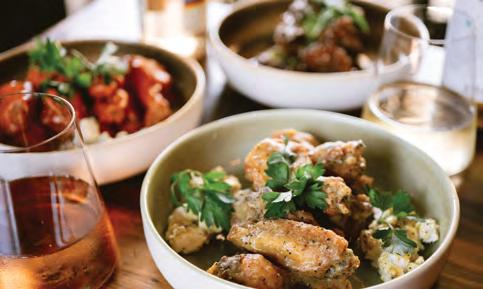
THE LINCOLN AT ACE & VINE This is where good times and great games come together. From Blackjack and Baccarat to lively monthly events, The Lincoln at Ace & Vine is Napa’s go-to destination for high-energy entertainment in a stylish, welcoming space with craveable bites and craft cocktails served until 2am.
505 LINCOLN AVE., NAPA // 707-699-2276 // WWW.THELINCOLNNAPA.COM
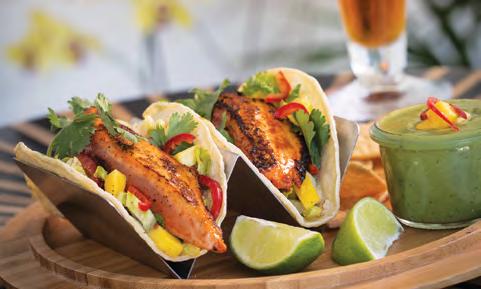
THE GRILL AT SILVERADO A one-of-a-kind Napa Valley restaurant, serving breakfast, lunch, dinner and bar appetizers, The Grill at Silverado features Wine Country Cuisine, emphasizing fresh and sustainable products. Just minutes from downtown Napa, the Grill overlooks one of the most beautiful golf courses on earth and offers a respite from the daily routine for everyone who visits. 1600 ATLAS PEAK RD, NAPA // 707-257-5400 // WWW.SILVERADORESORT.COM
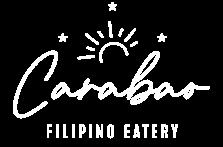

CARABAO Located in downtown Napa, Carabao is a modern Filipino restaurant offering bold, seasonal dishes inspired by traditional flavors and locally sourced ingredients. With a vibrant, welcoming setting and thoughtfully crafted cocktails, Carabao delivers an authentic, elevated dining experience that celebrates Filipino heritage with a contemporary twist.
145 C GASSER DRIVE, NAPA // 707-699-1220 // WWW.CARABAONAPA.COM

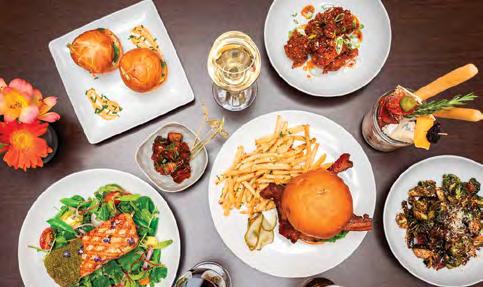
GRILLE 29 Nestled in Embassy Suites Napa Valley, Grille 29 offers a casual, friendly space ideal for a business lunch, after work drinks or dinner with the family. The tall rustic ceiling with chandeliers, sofa seating and beautiful oak bar add an old-world charm to the intimate dining room and lounge. Enjoy delightful entrees using fresh products and herbs grown from its very own garden! 1075 CALIFORNIA BLVD., NAPA // 707-320-9520
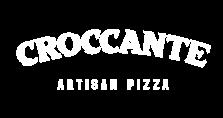
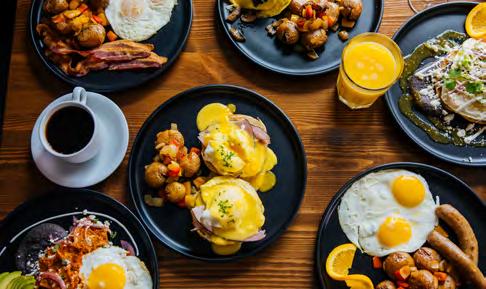
CROCCANTE ARTISAN PIZZA Along with its made-from-scratch Detroit and Chicago-style pizzas and other delectable menu items made from locally sourced, fresh ingredients–family-owned Croccante serves up a warm, family-friendly atmosphere, earning their loyal following. NEW! Now serving breakfast and brunch Thu-Sun from 8am–1pm! Come hungry. Leave happy. 976 PEARL ST, NAPA // 707-222-5017 // WWW.CROCCANTEPIZZA.COM

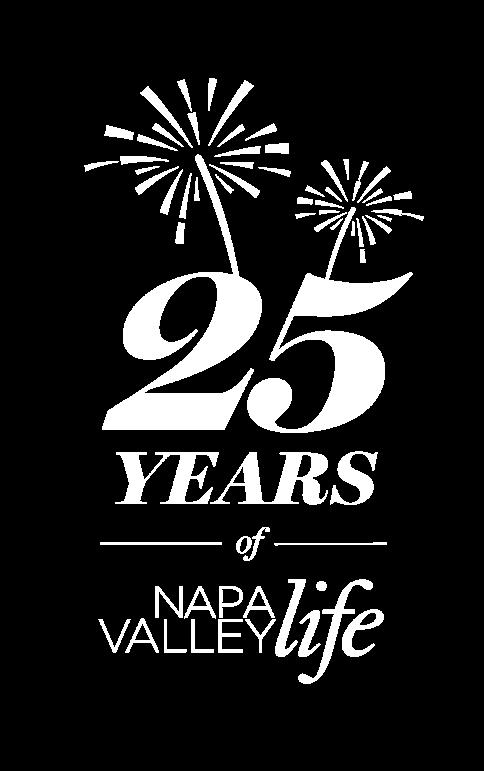
•••
We would not be here without our wonderful readers and the support of our valued partners.
We so appreciate your loyalty and partnership through the years.
•••
Cheers to the next 25!
